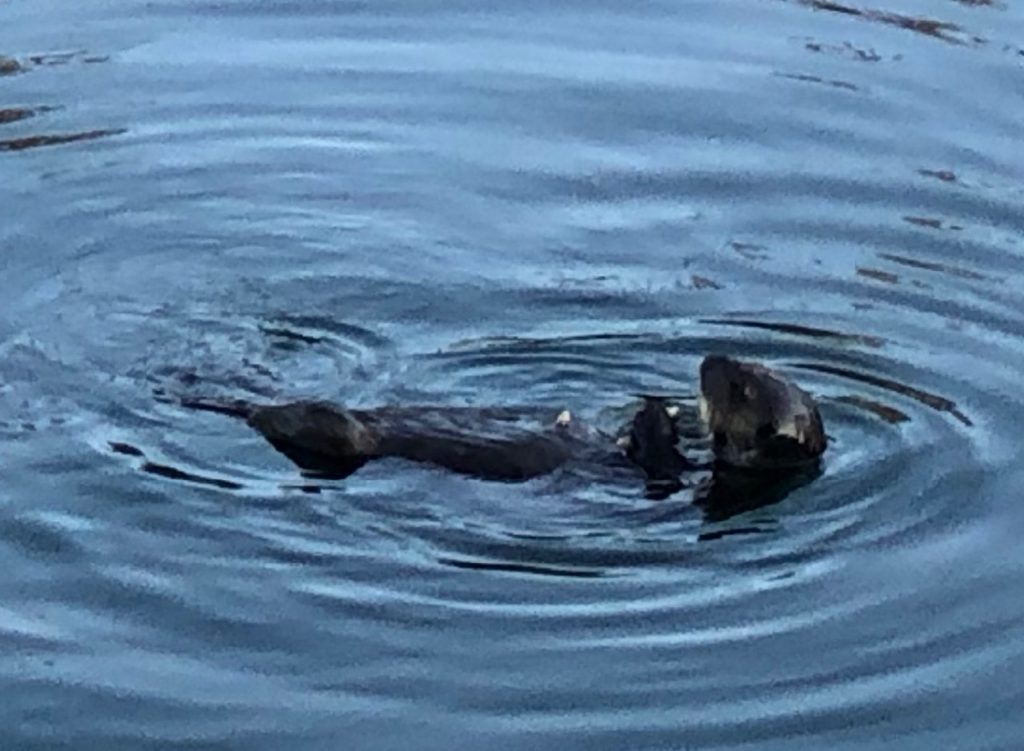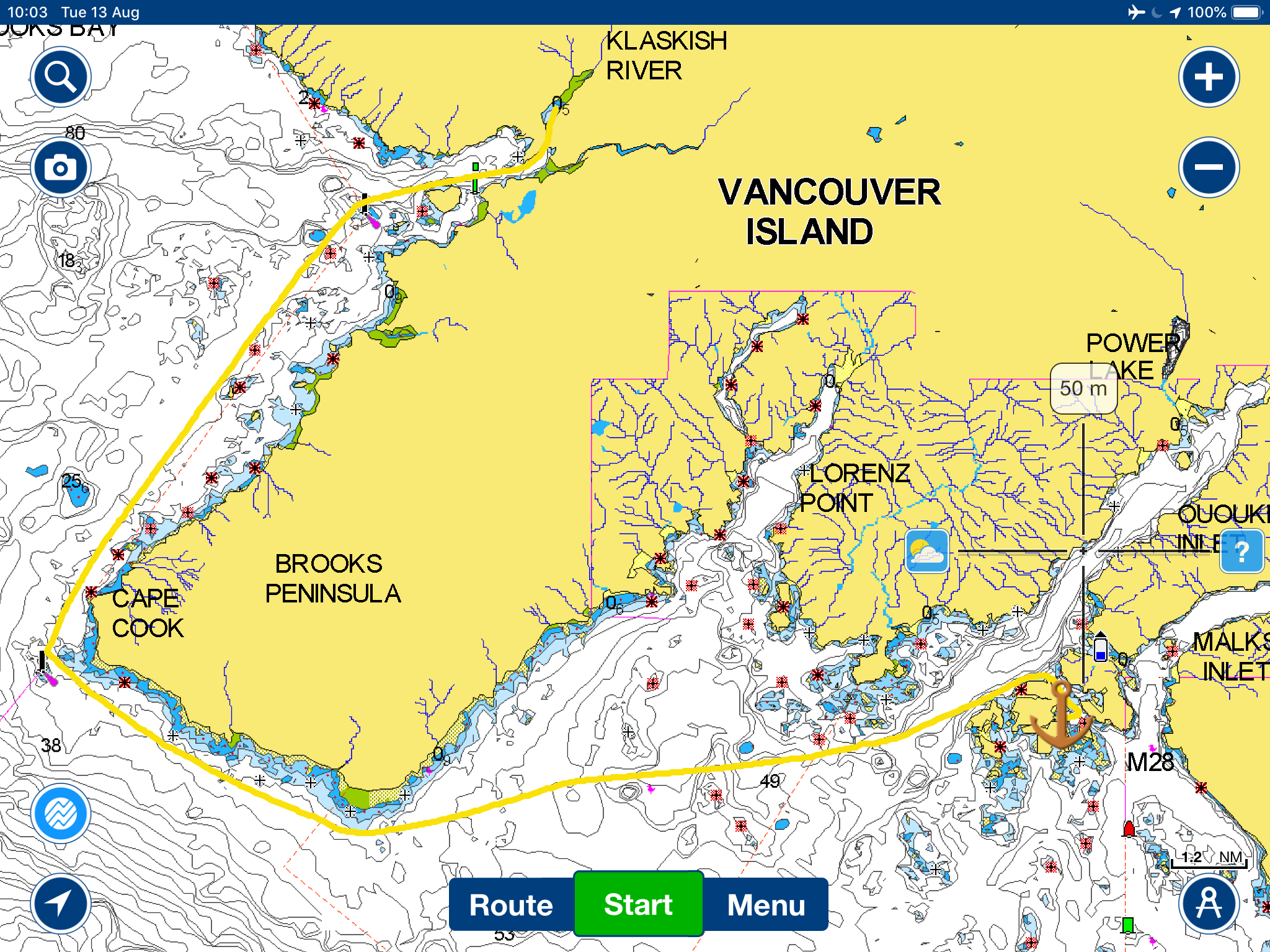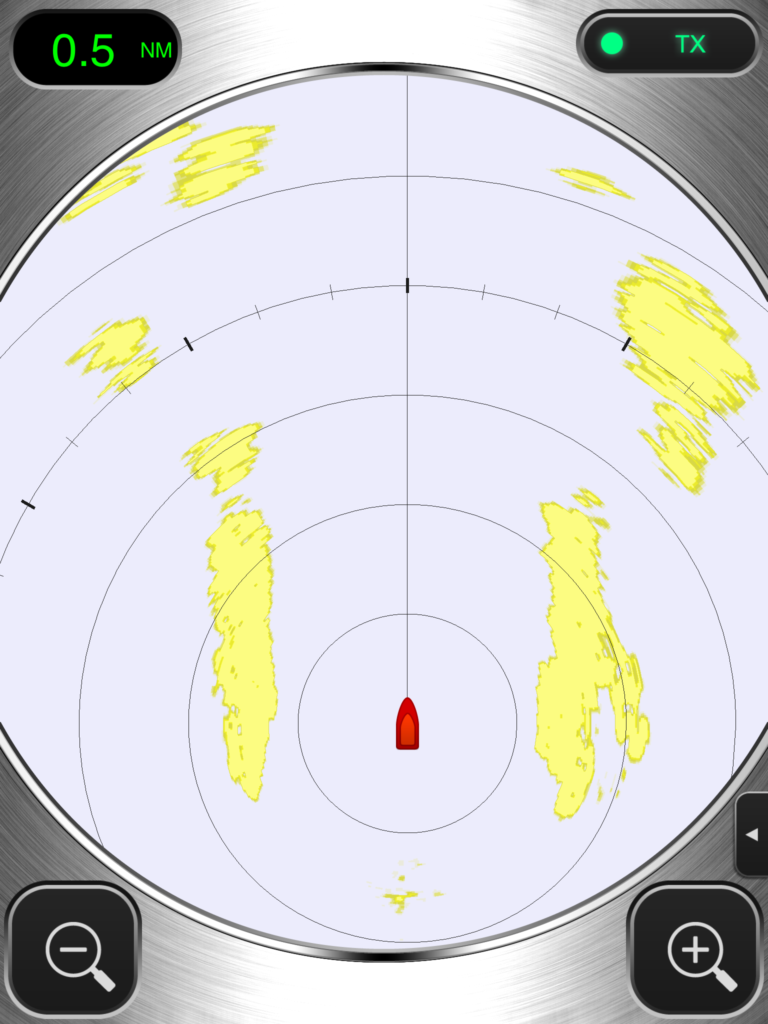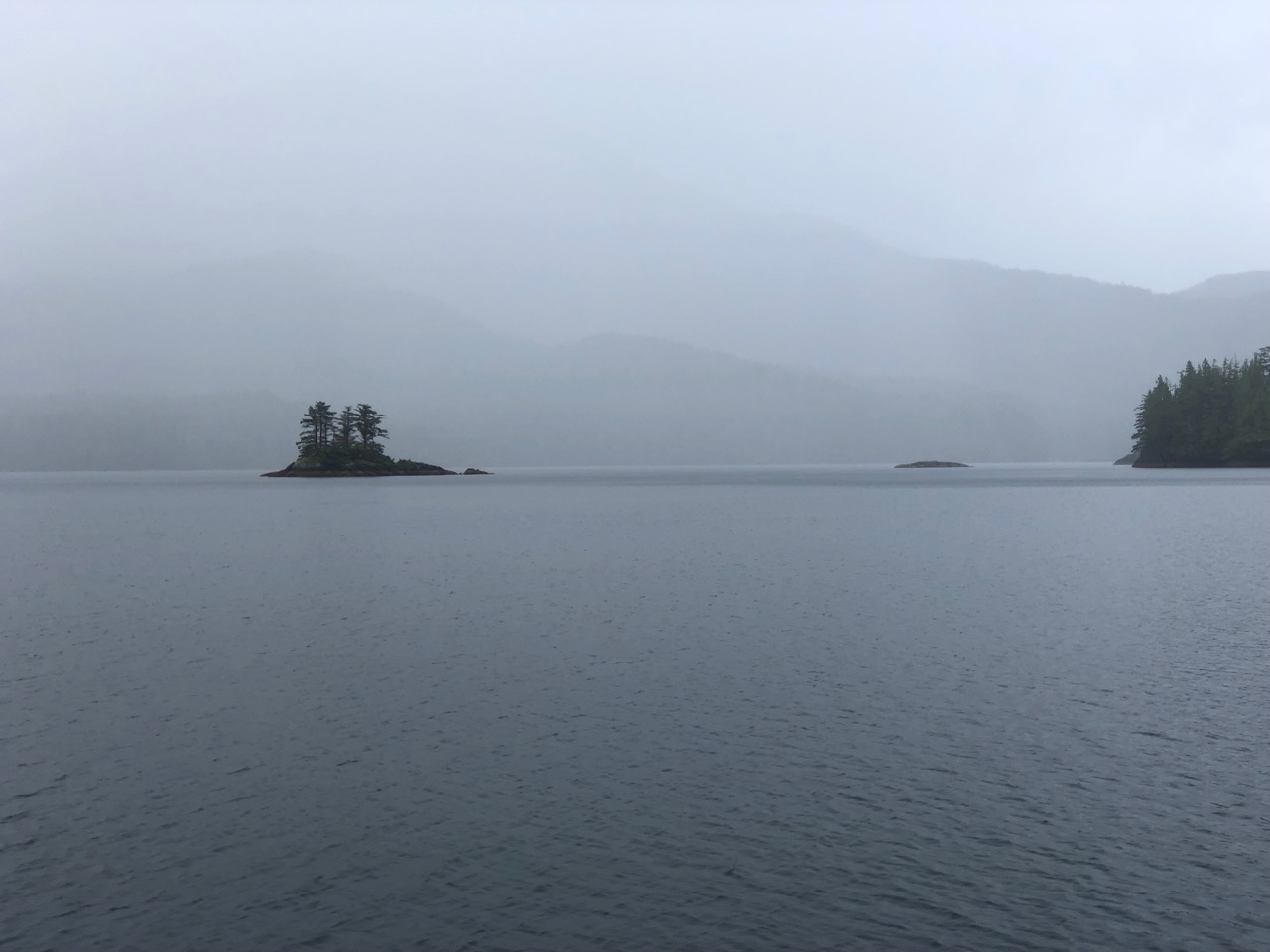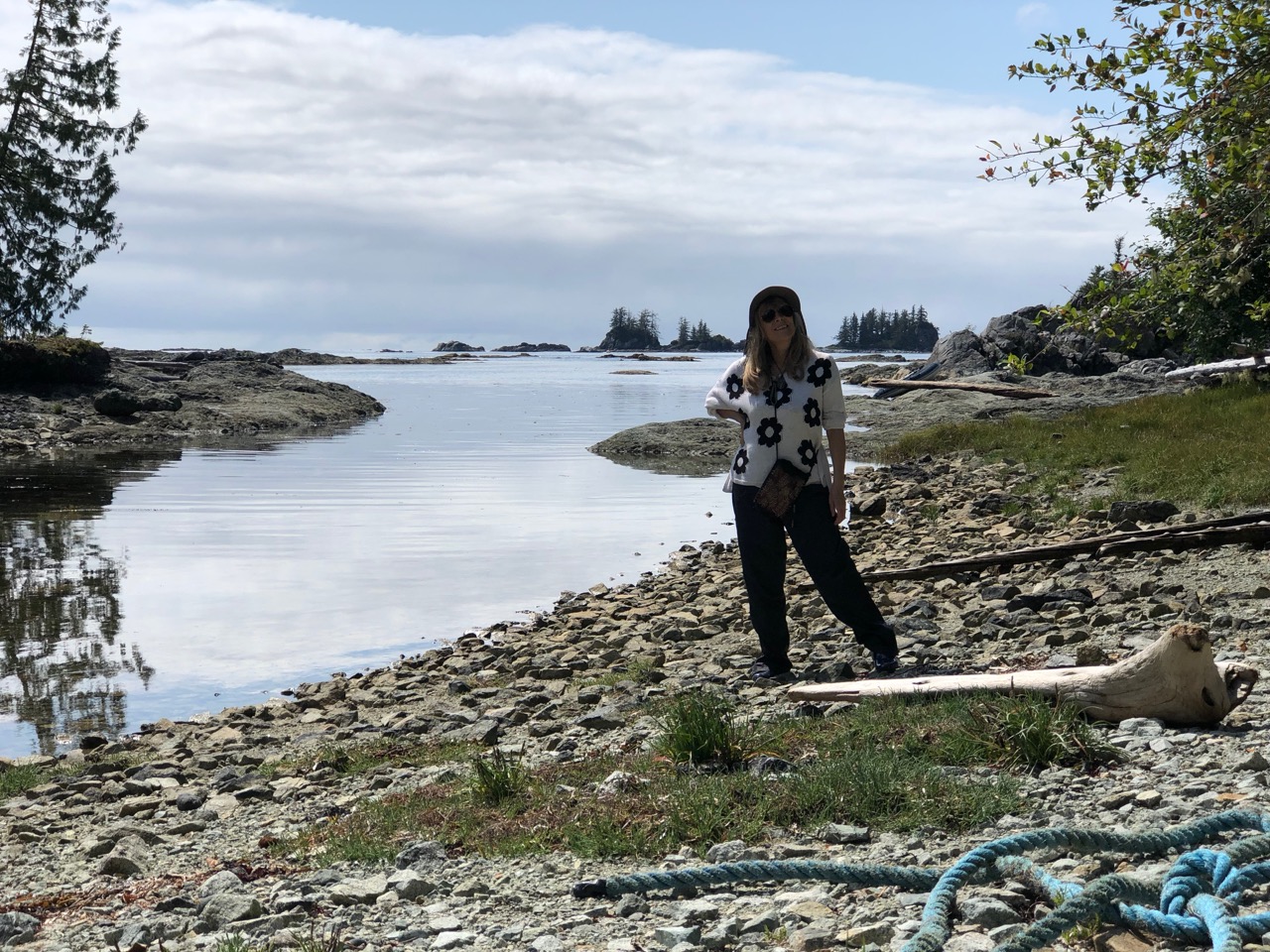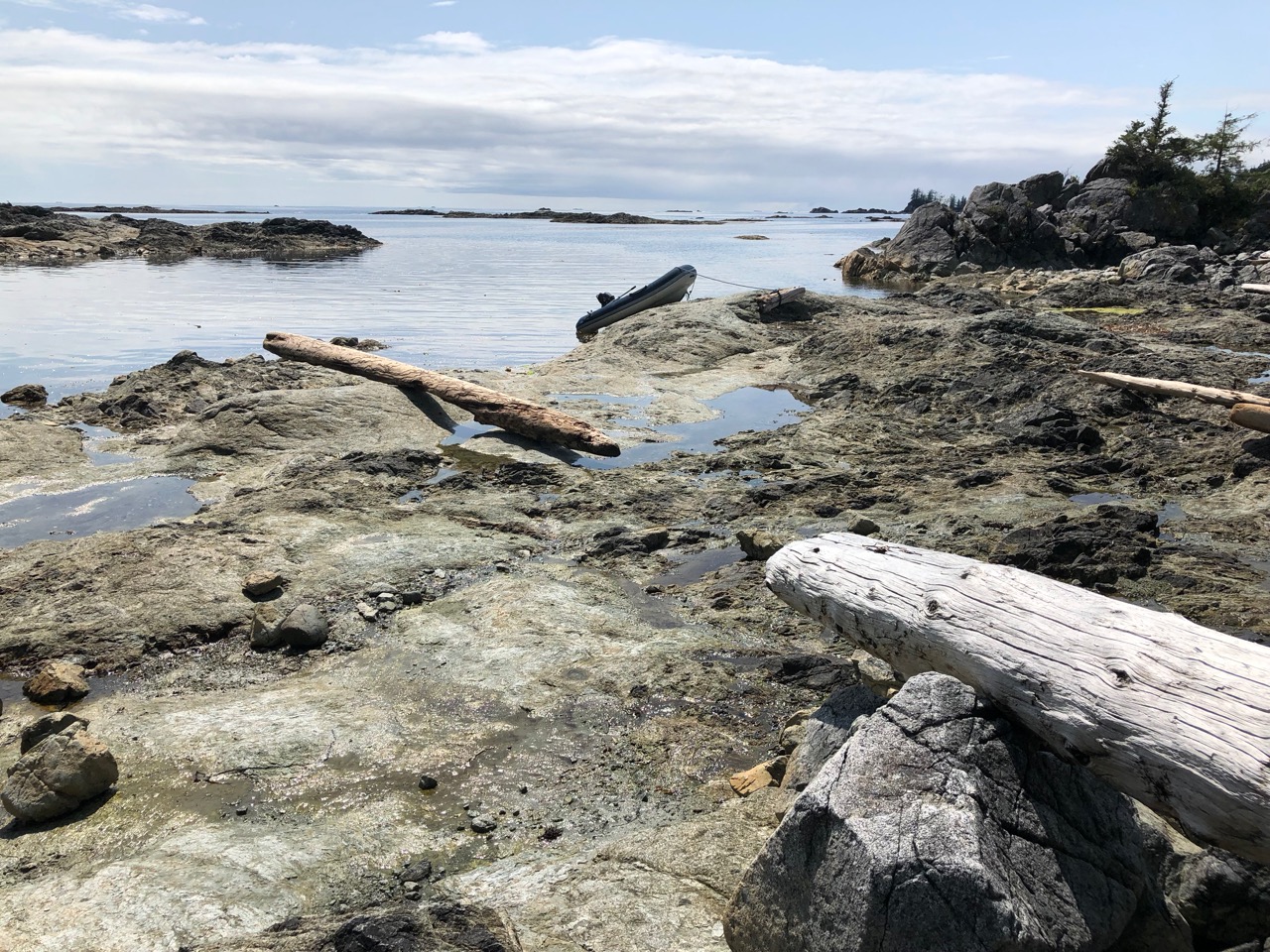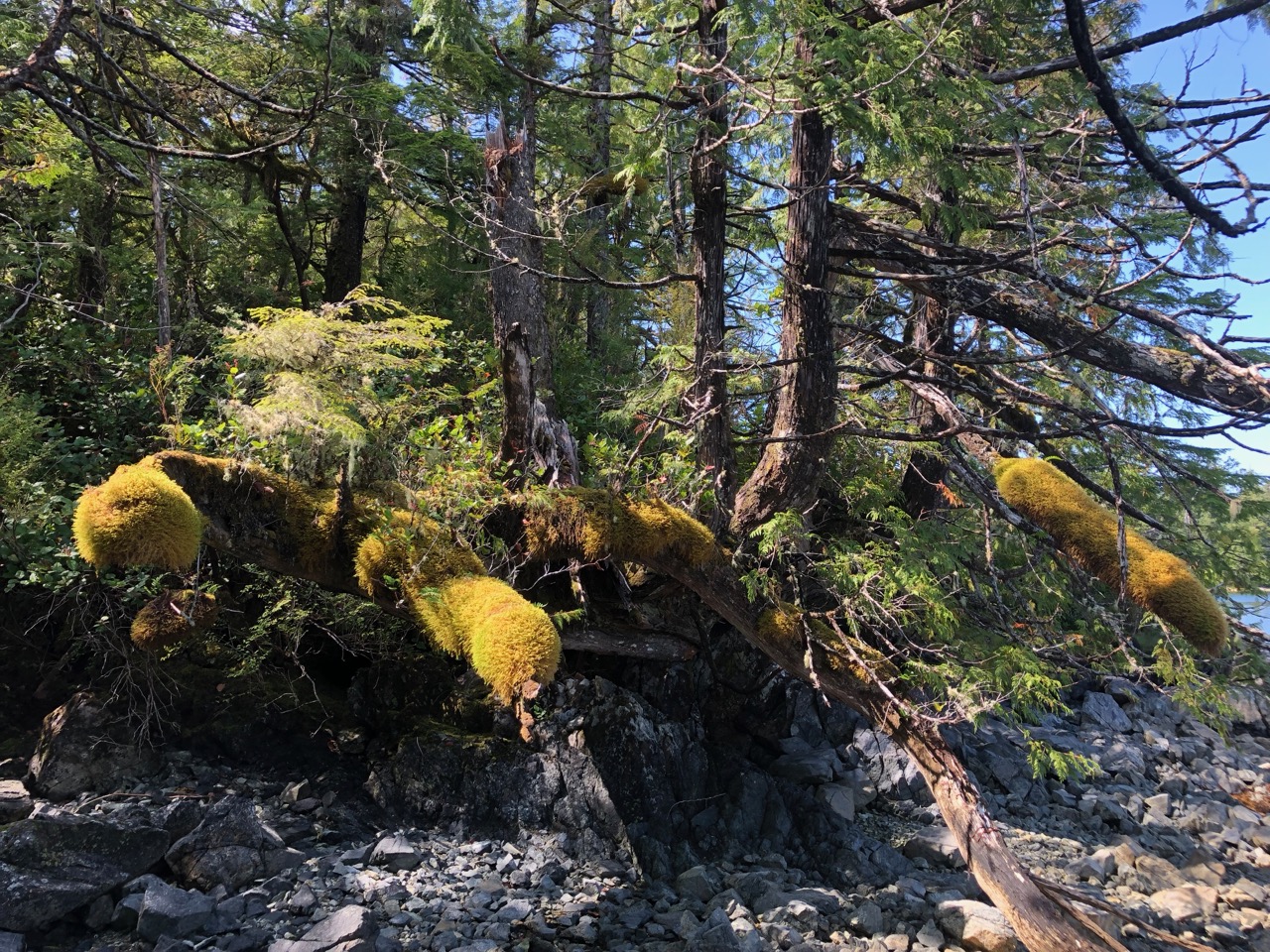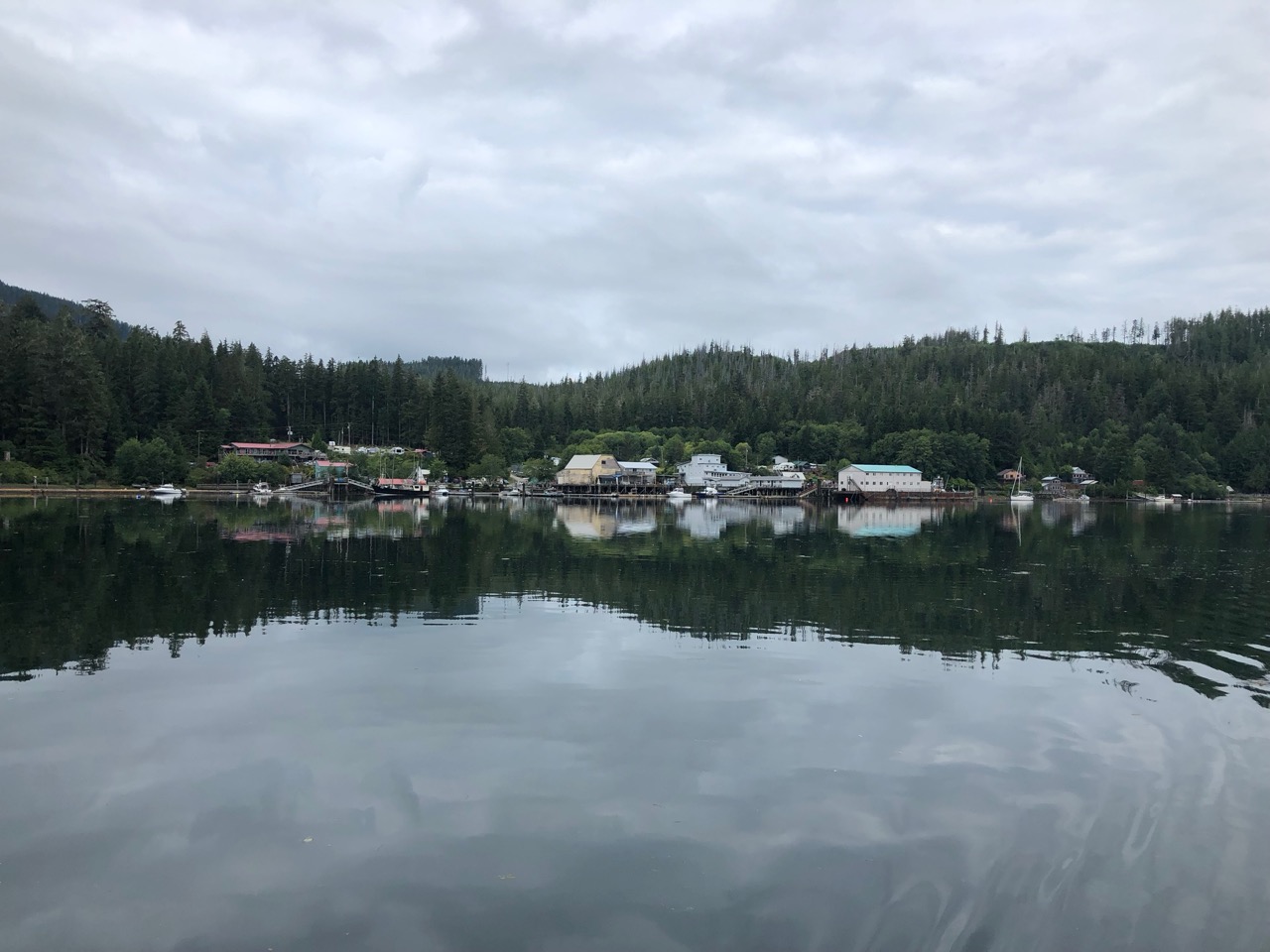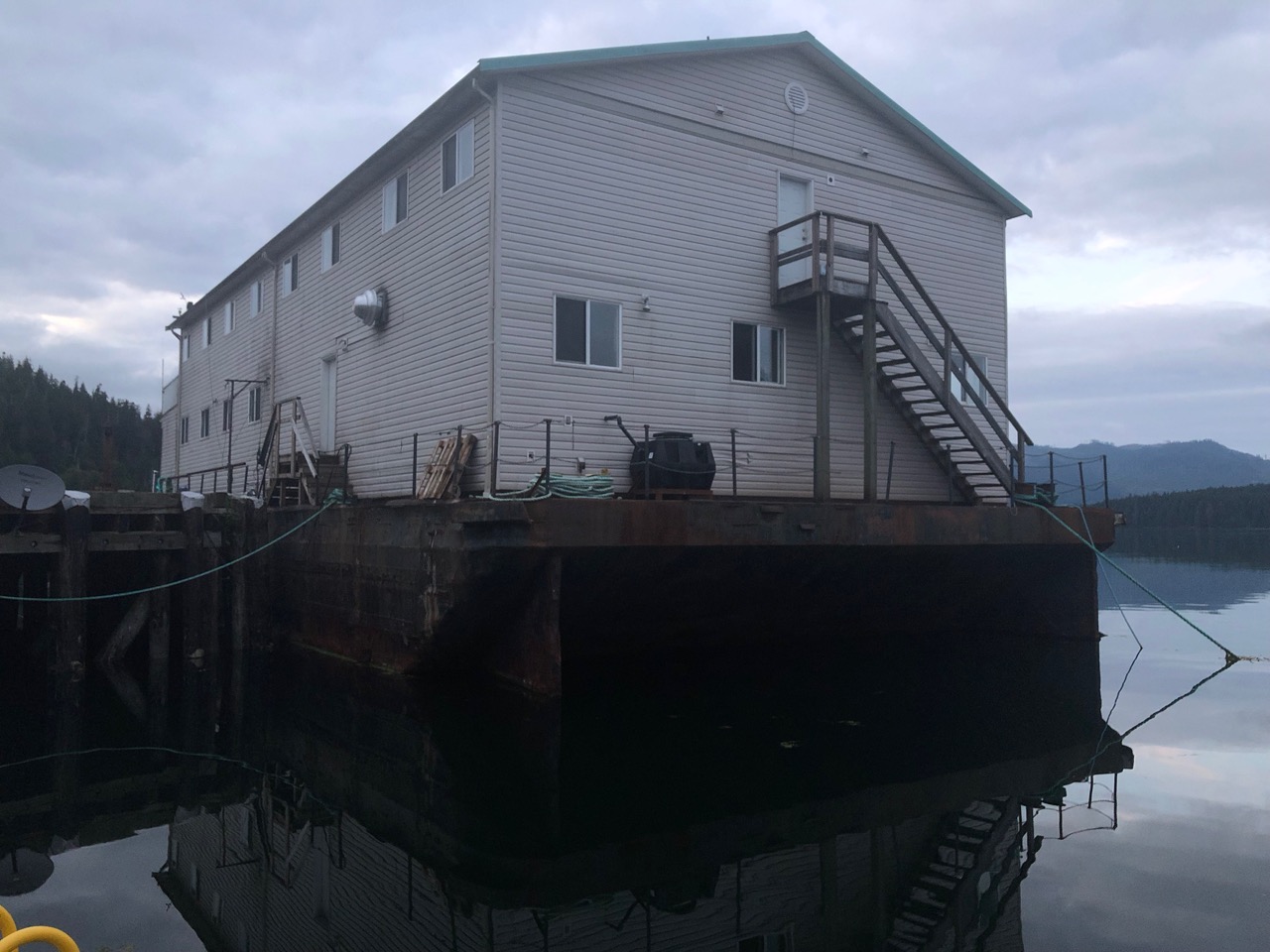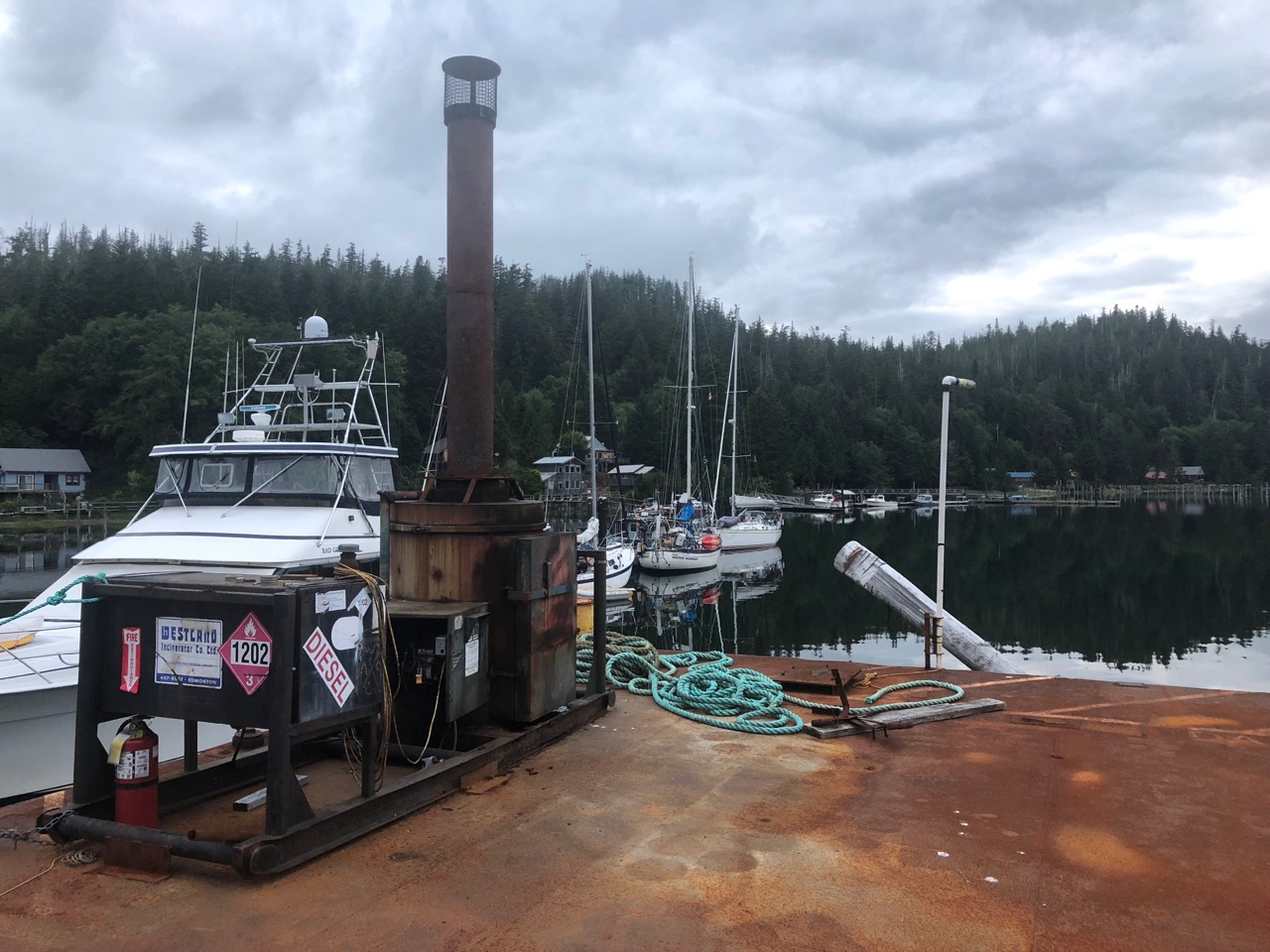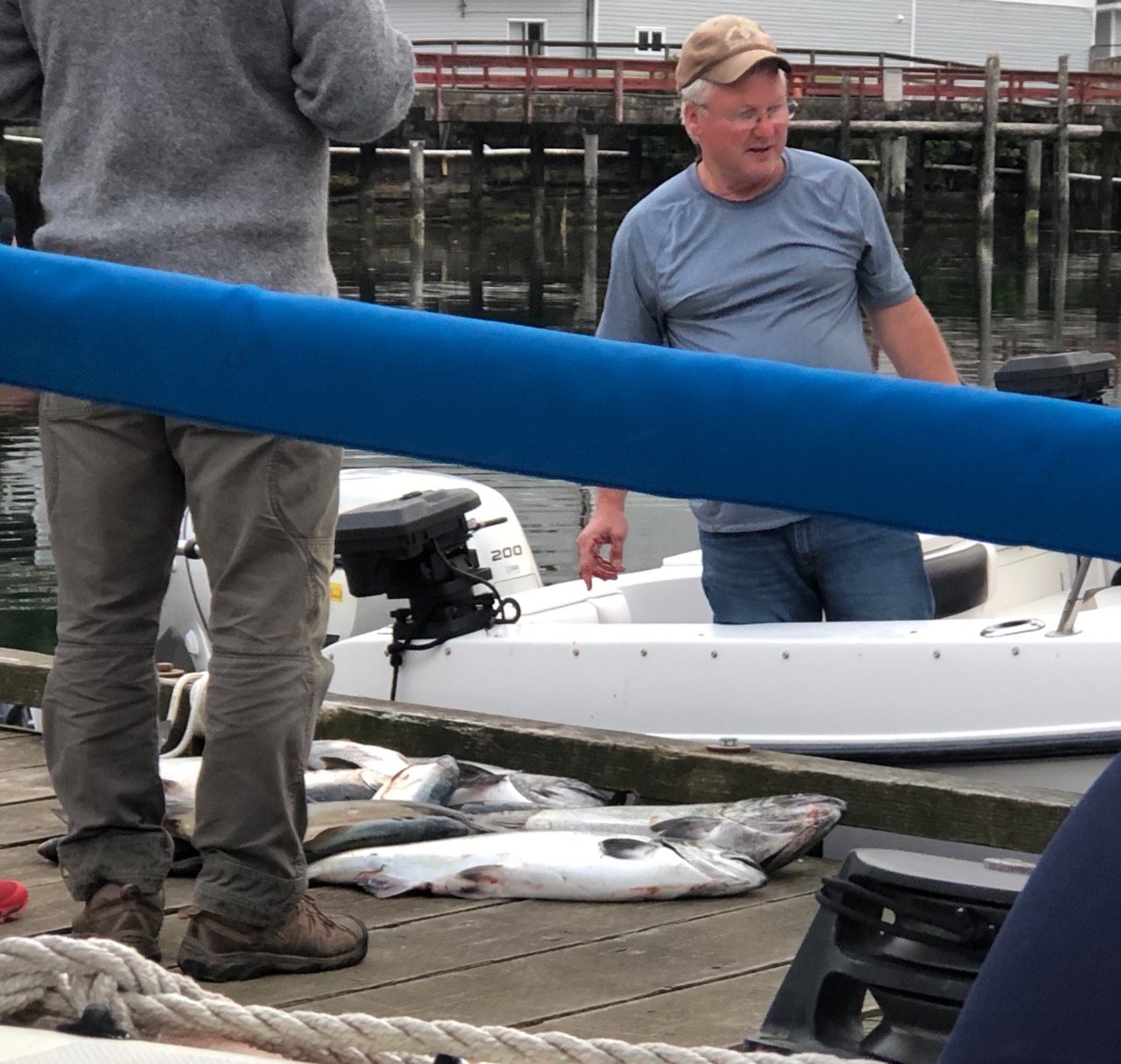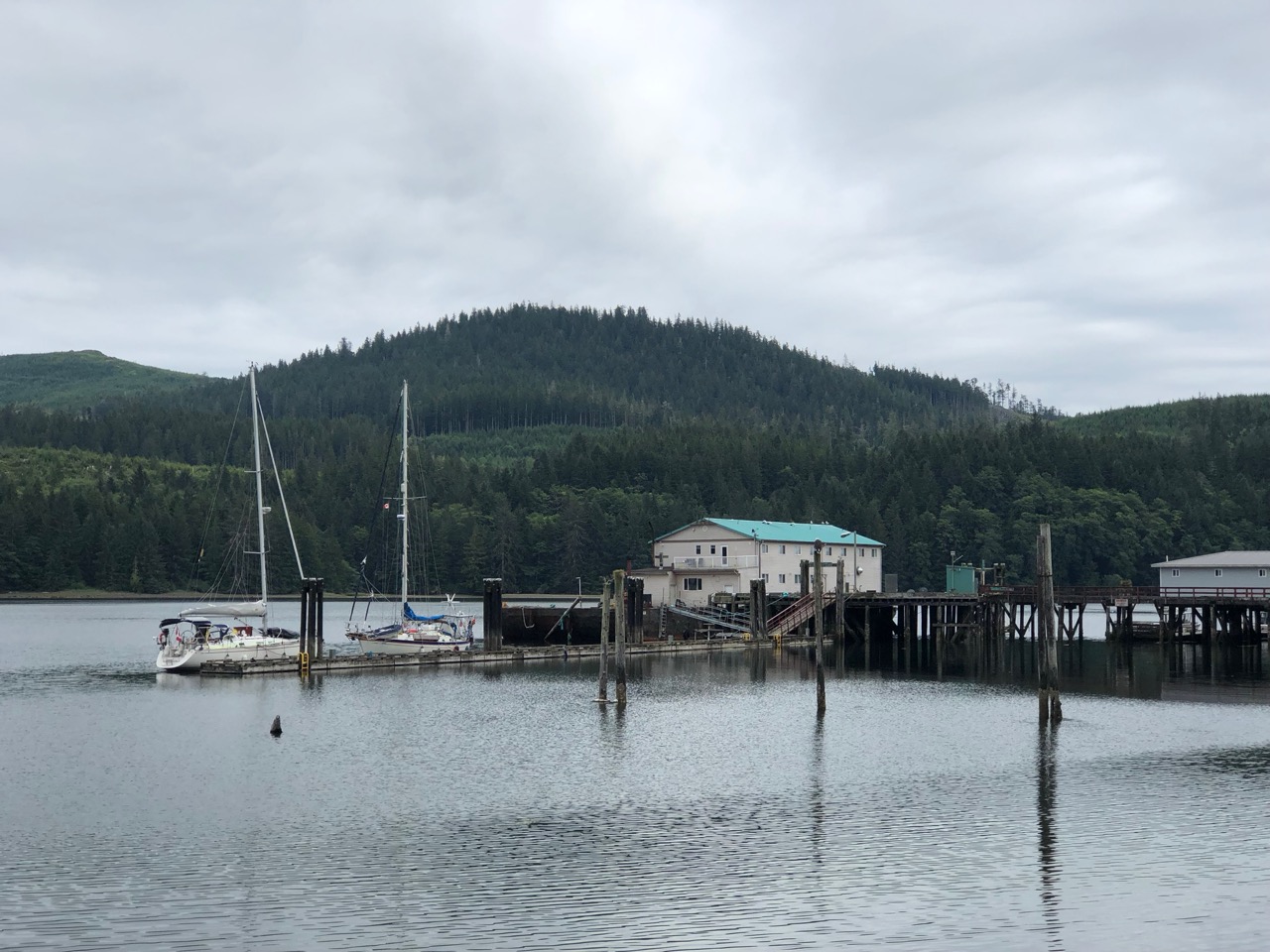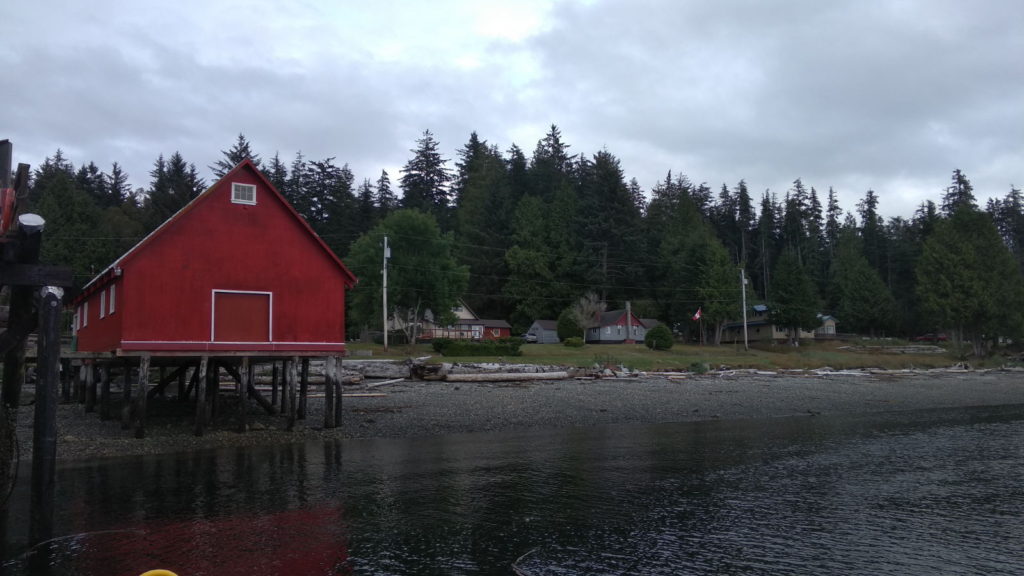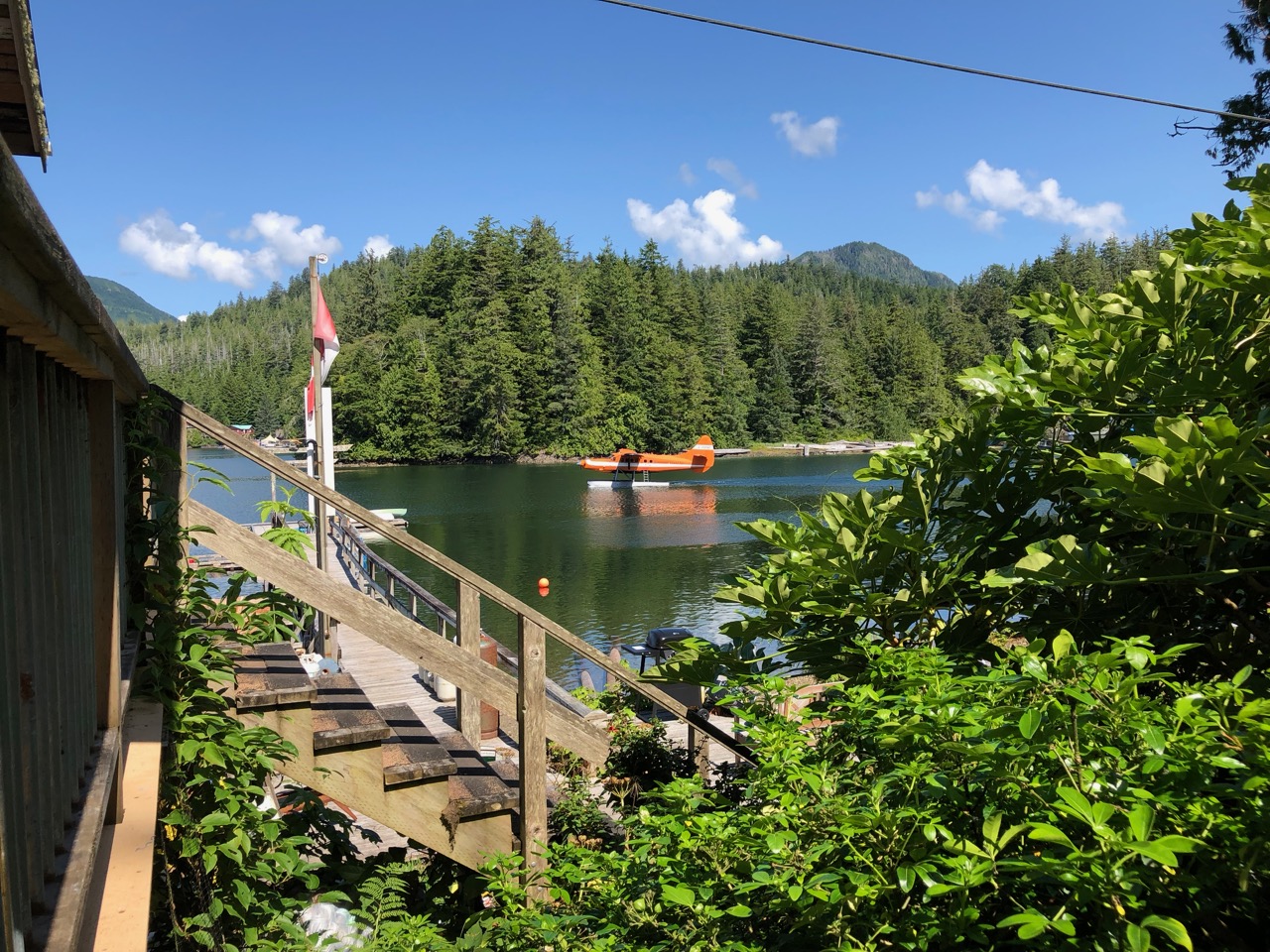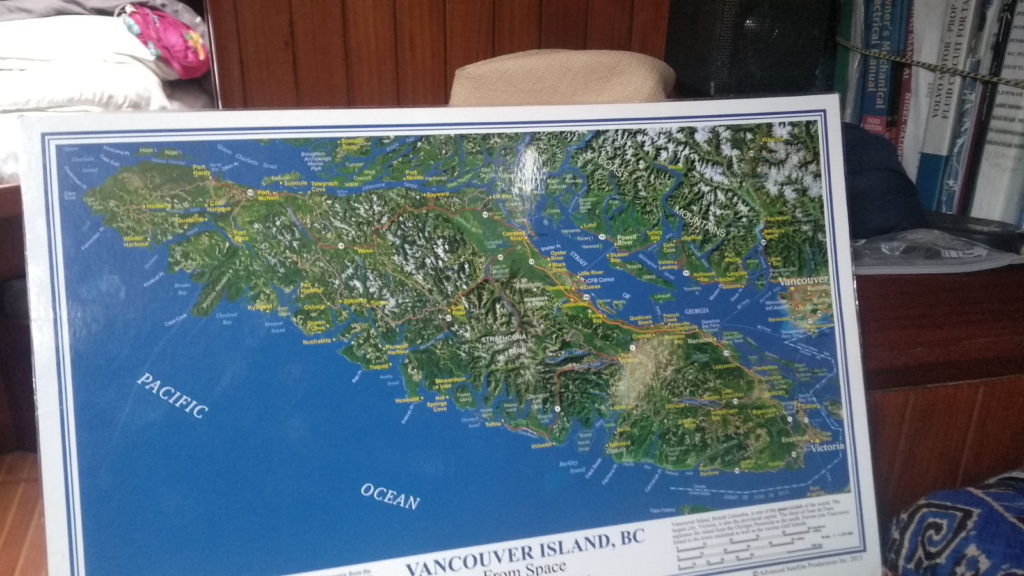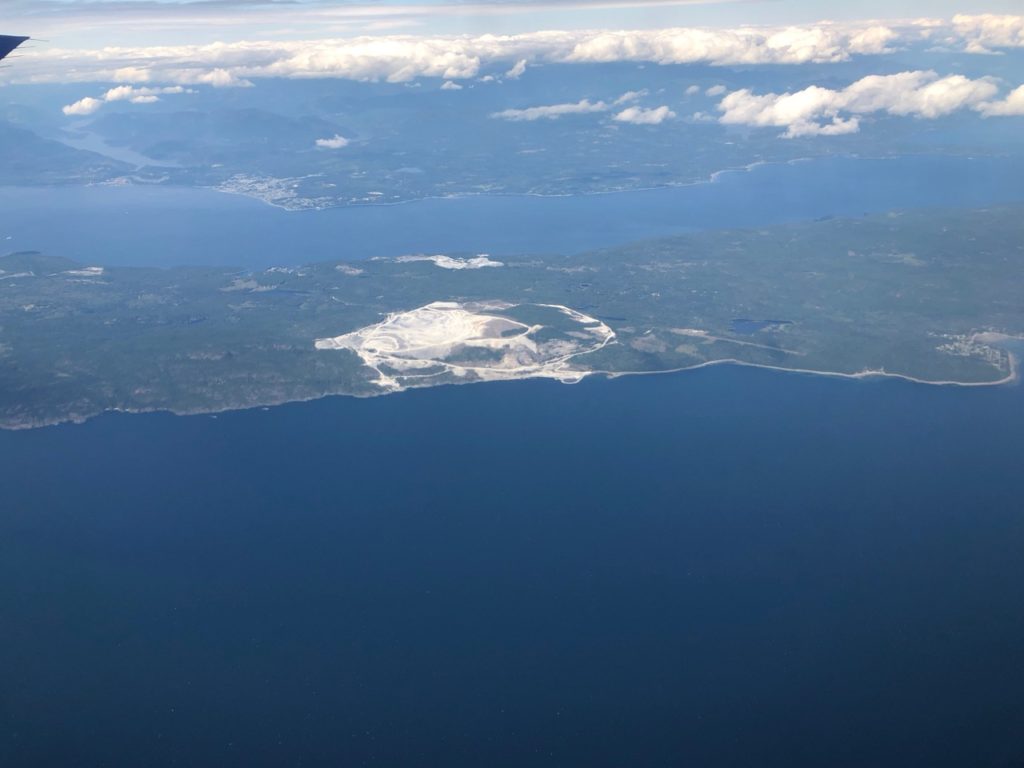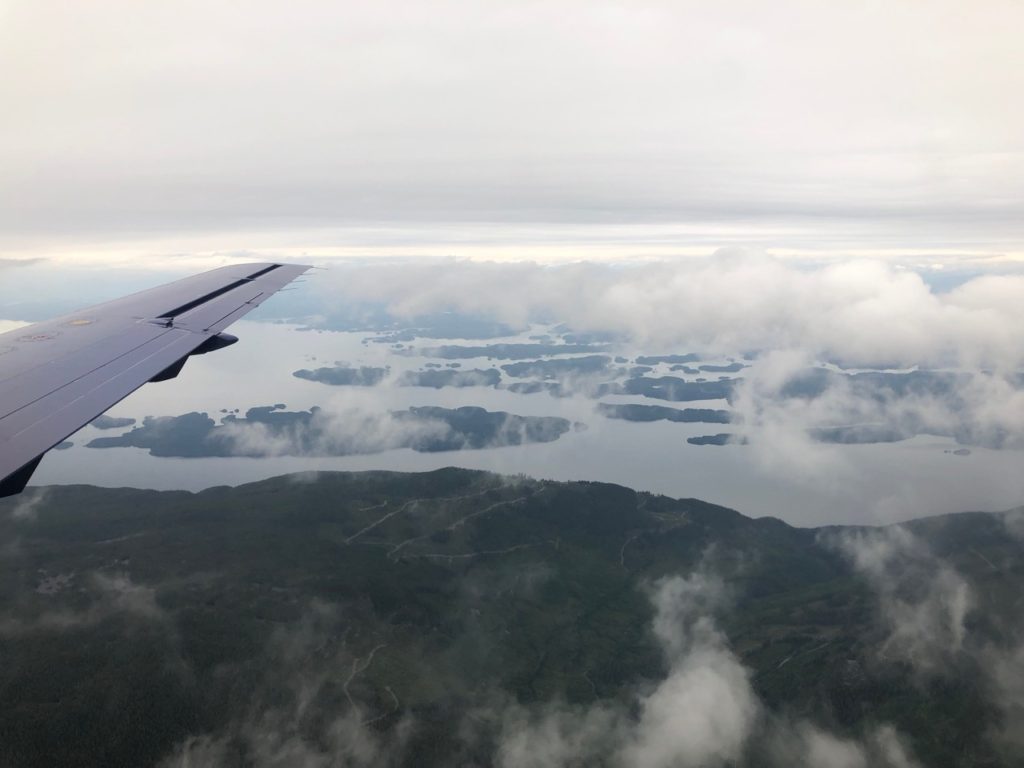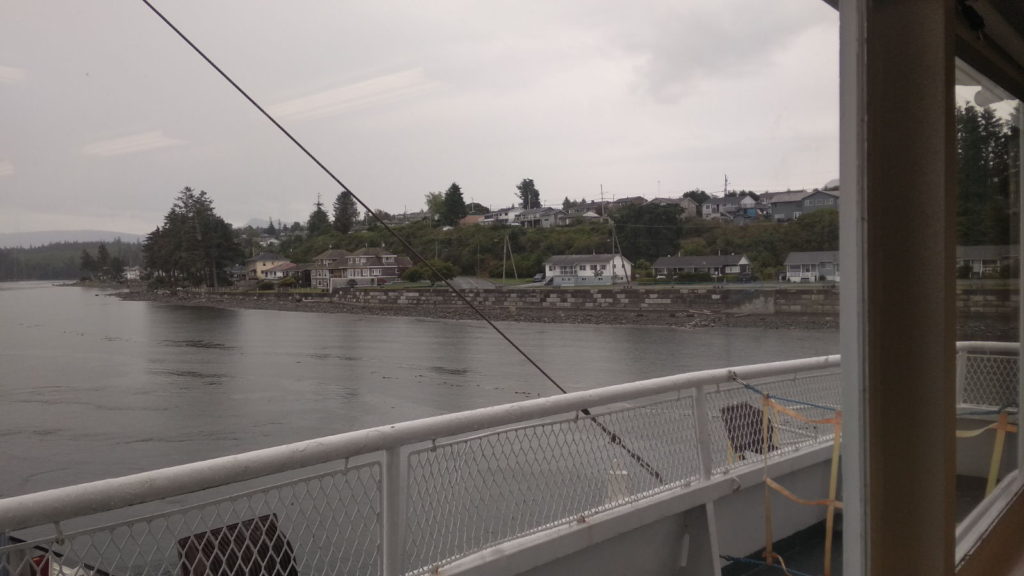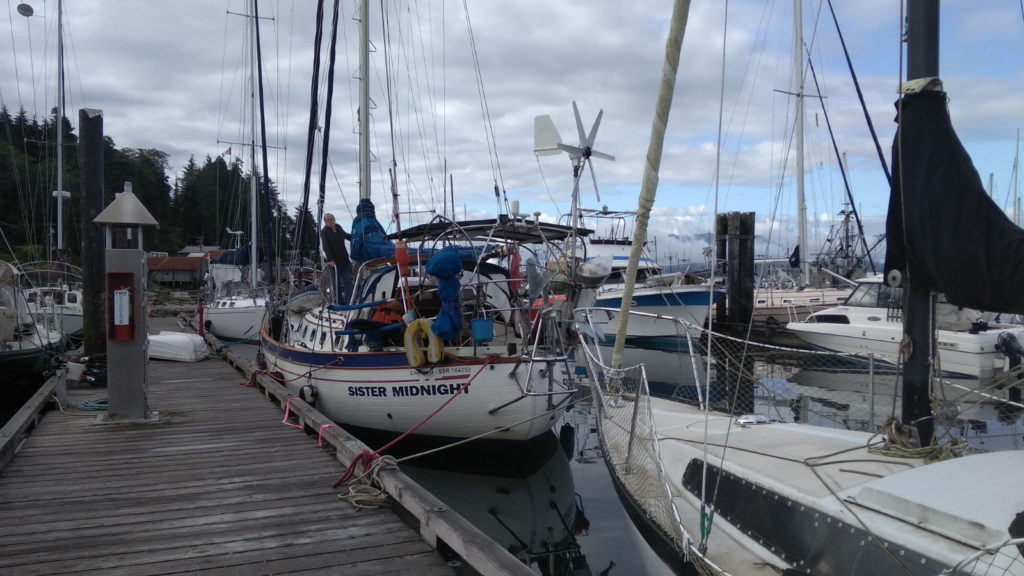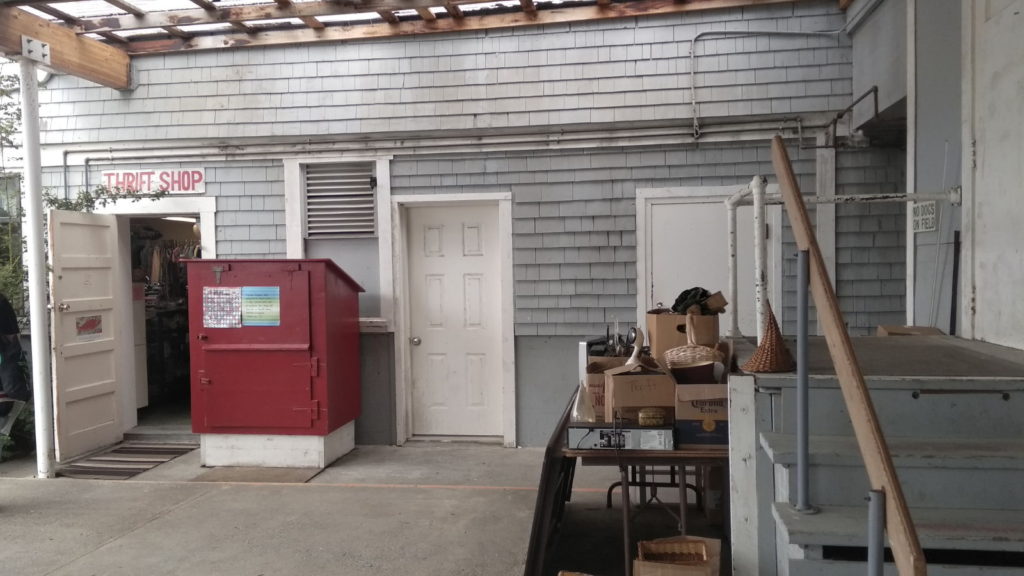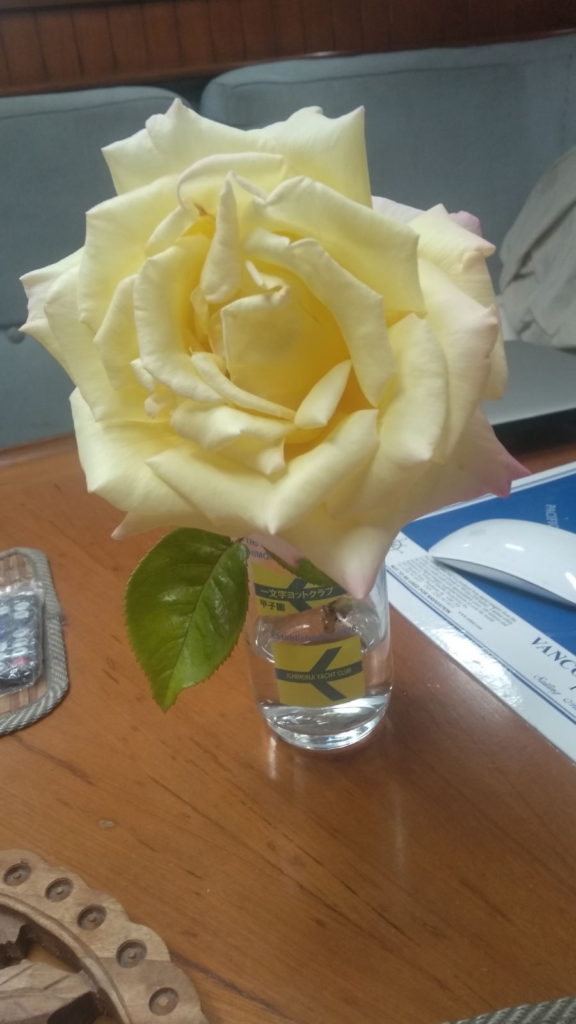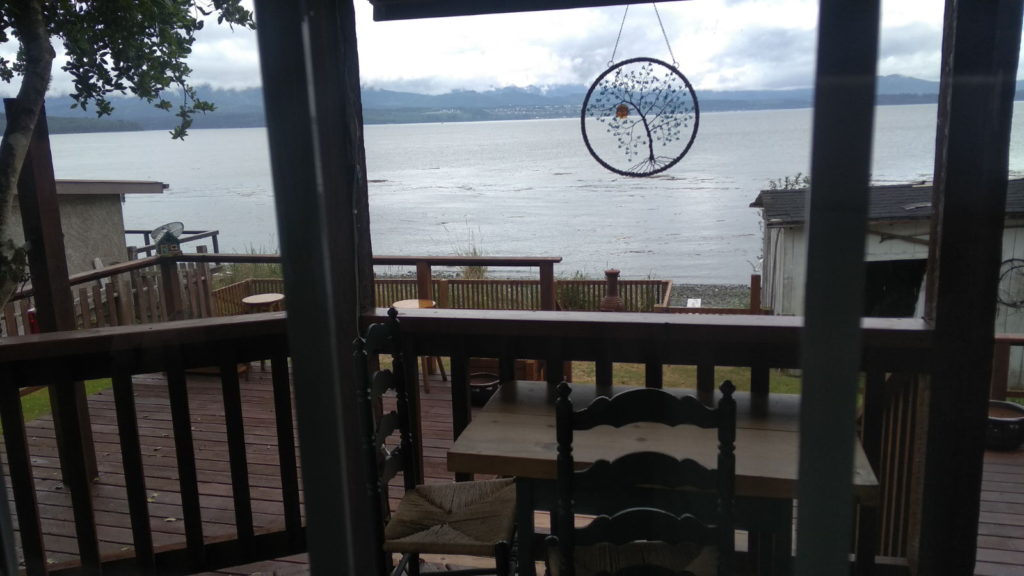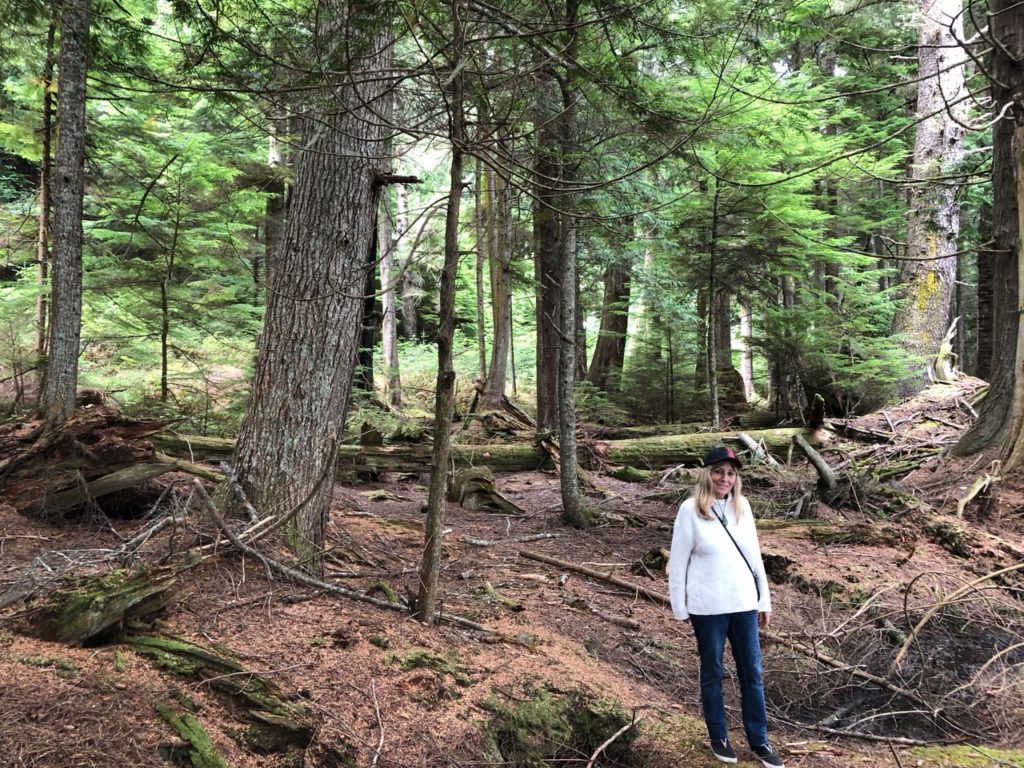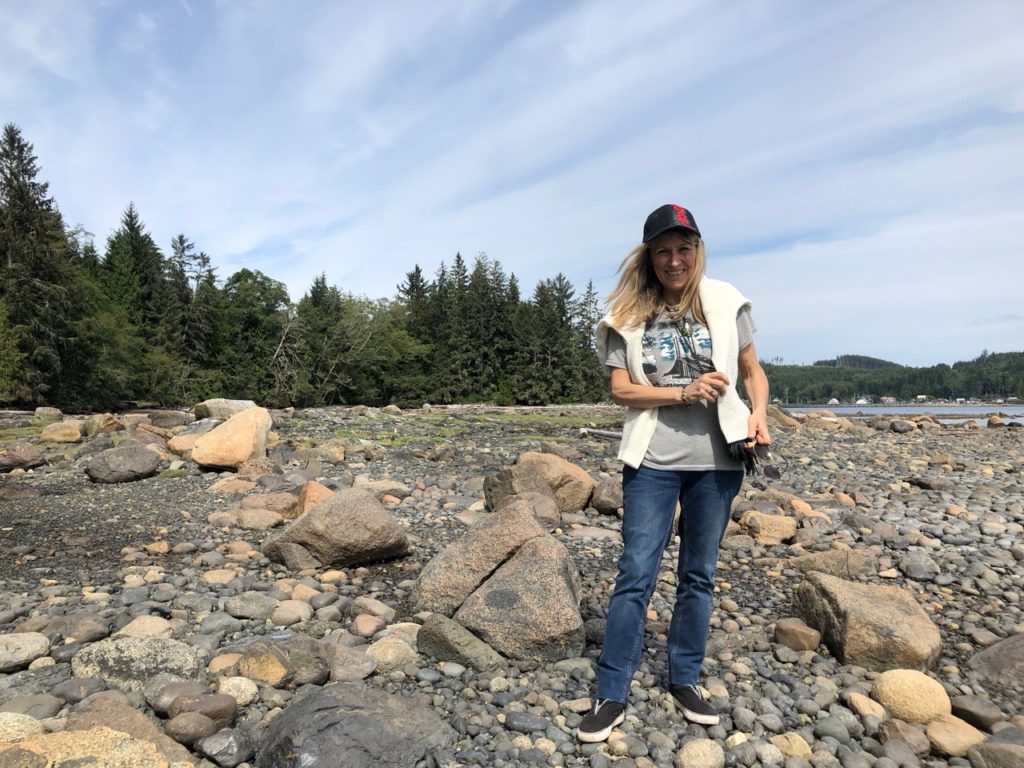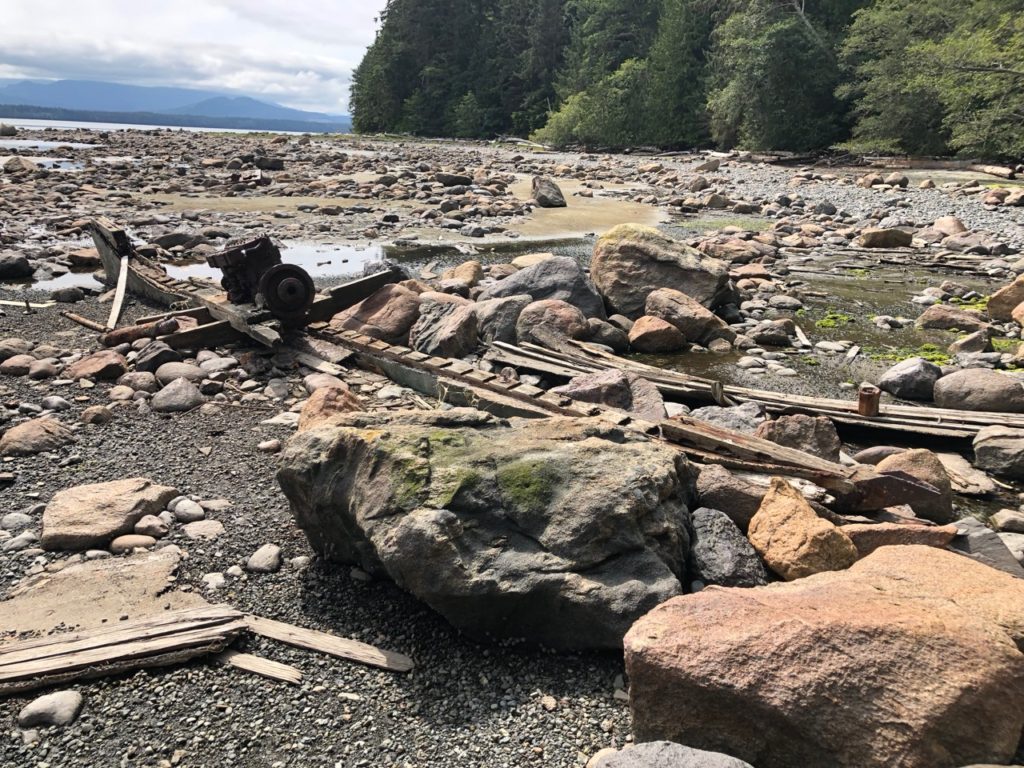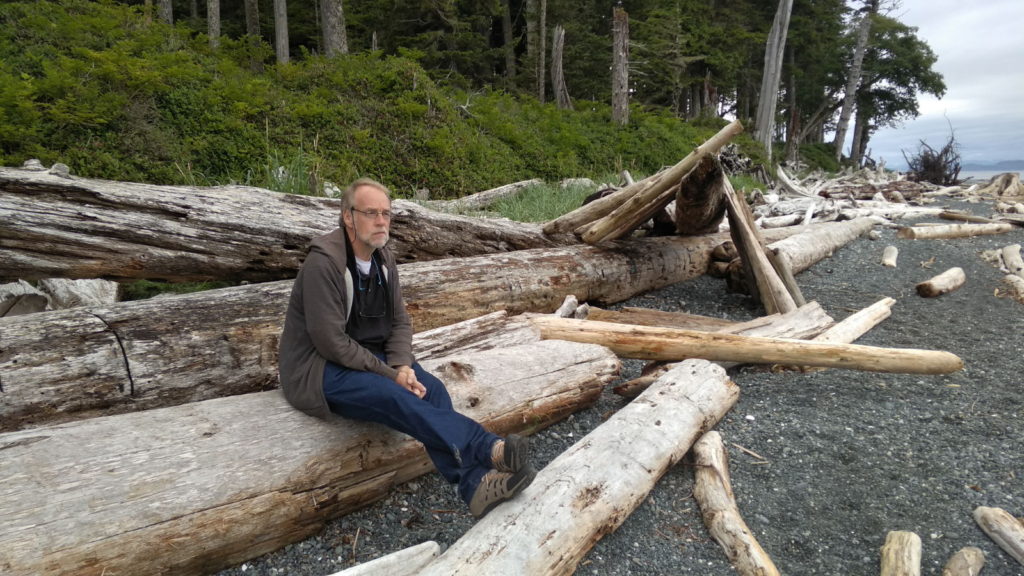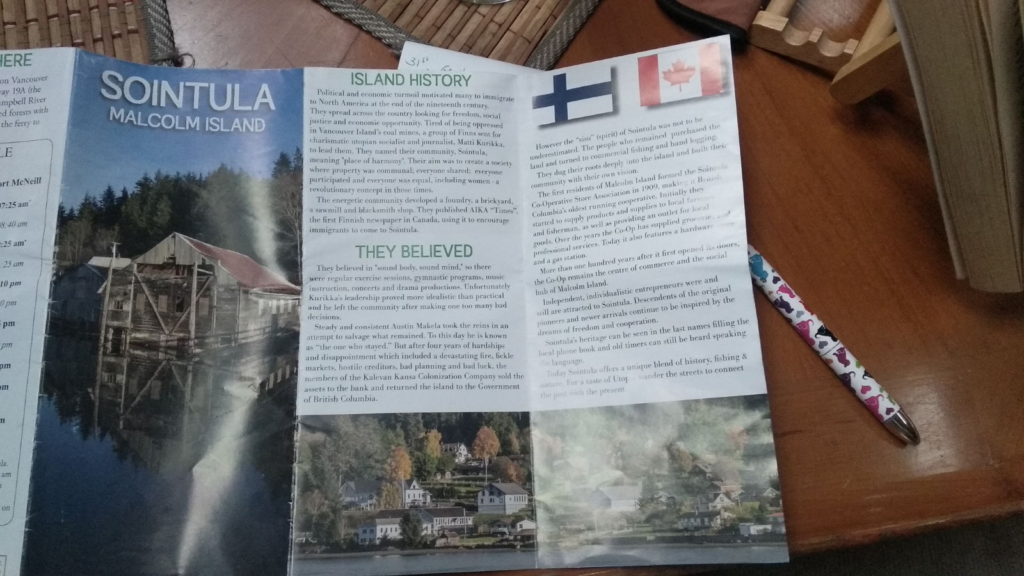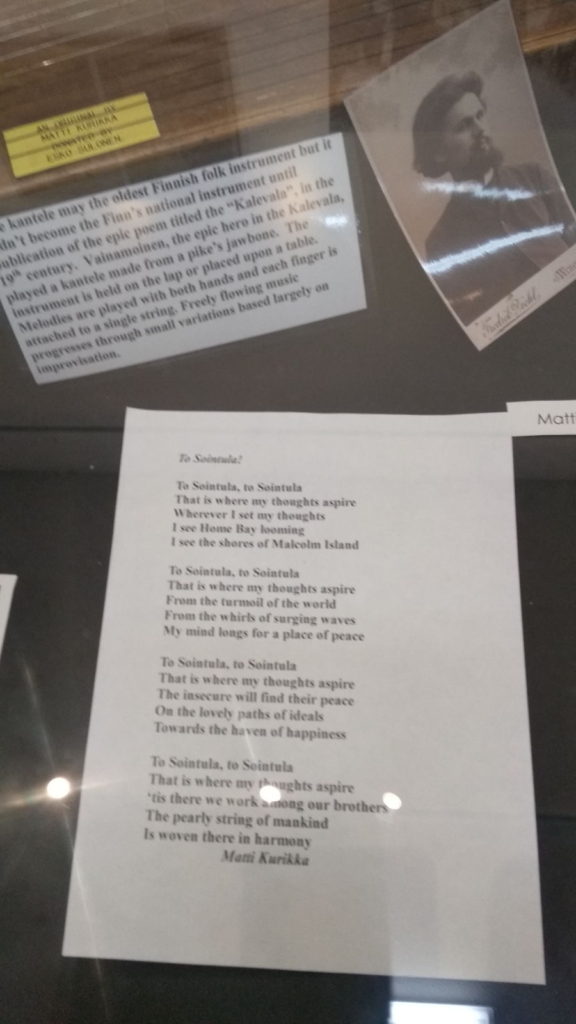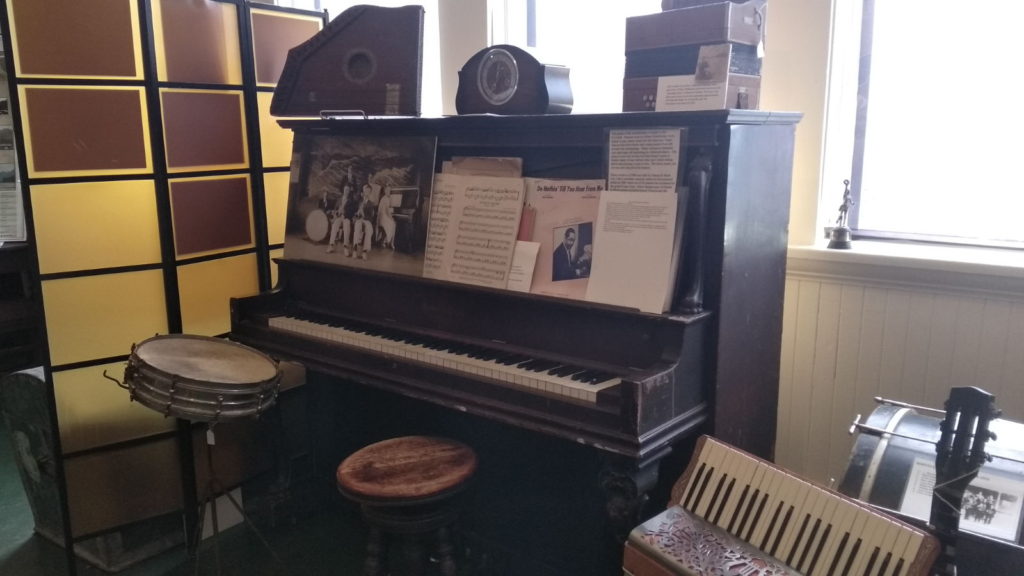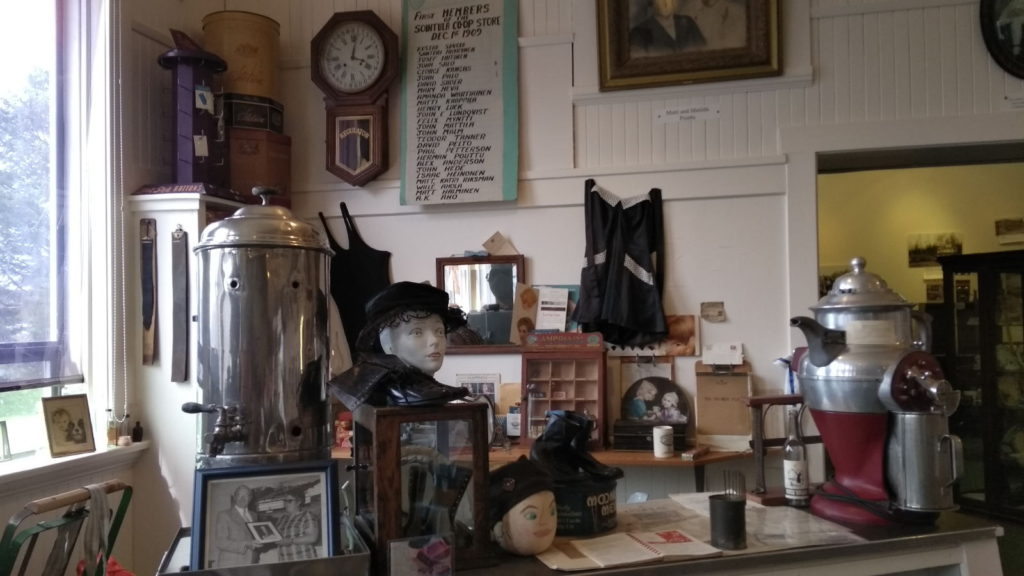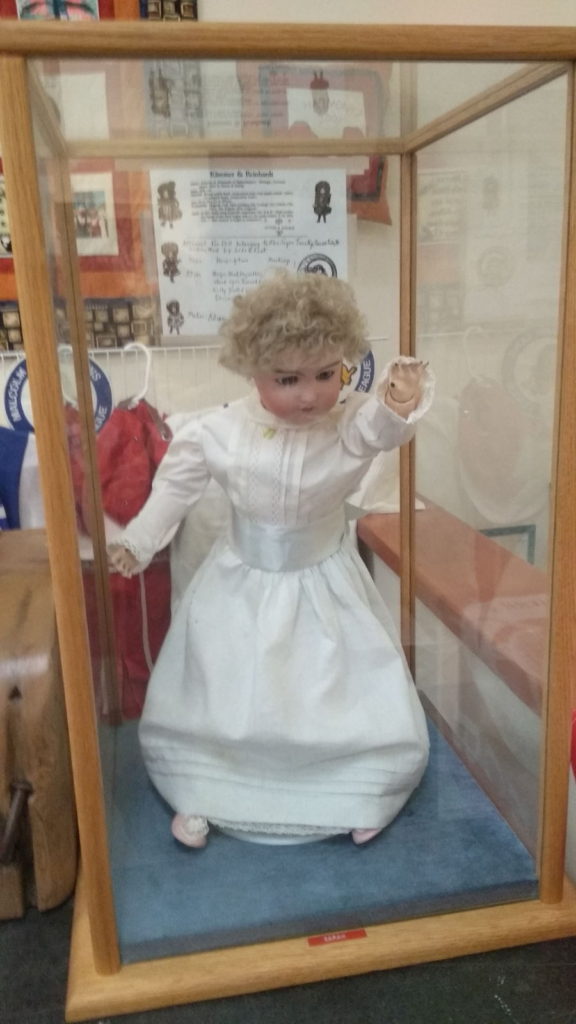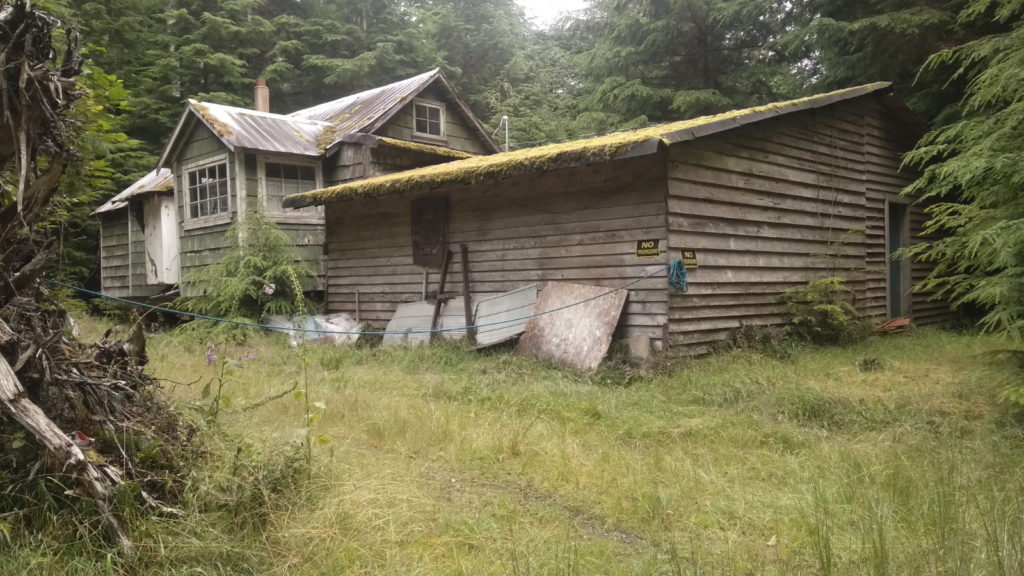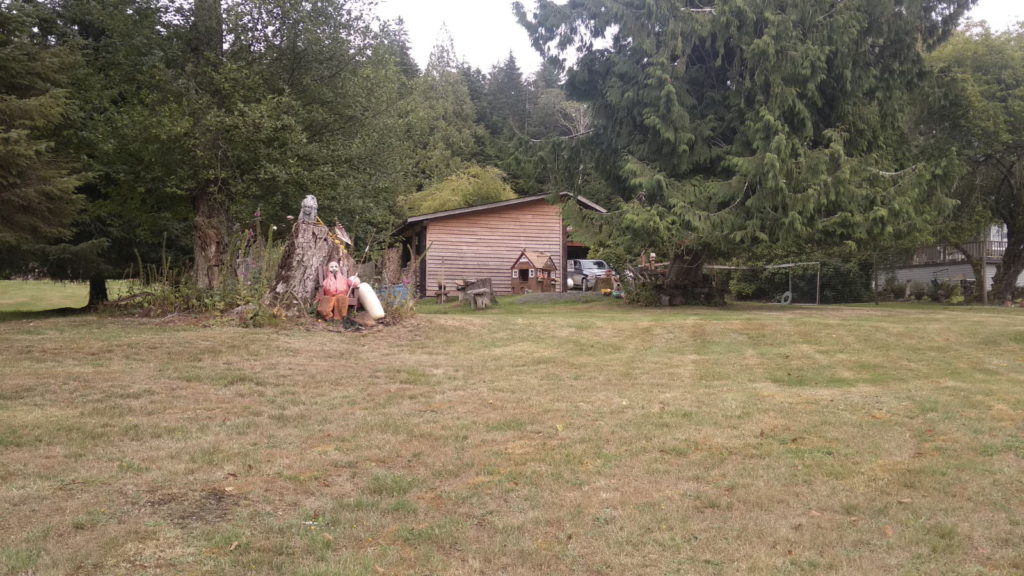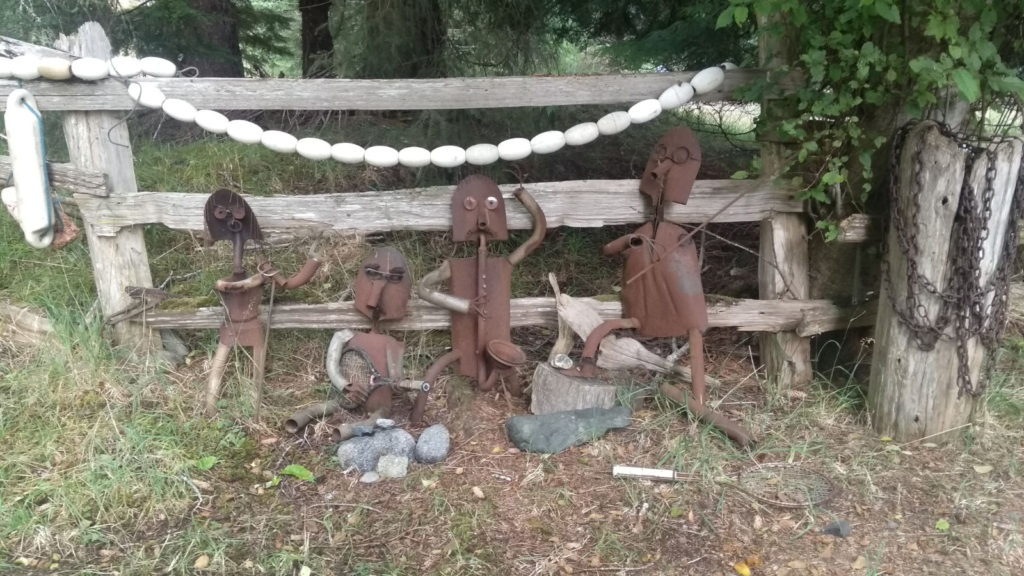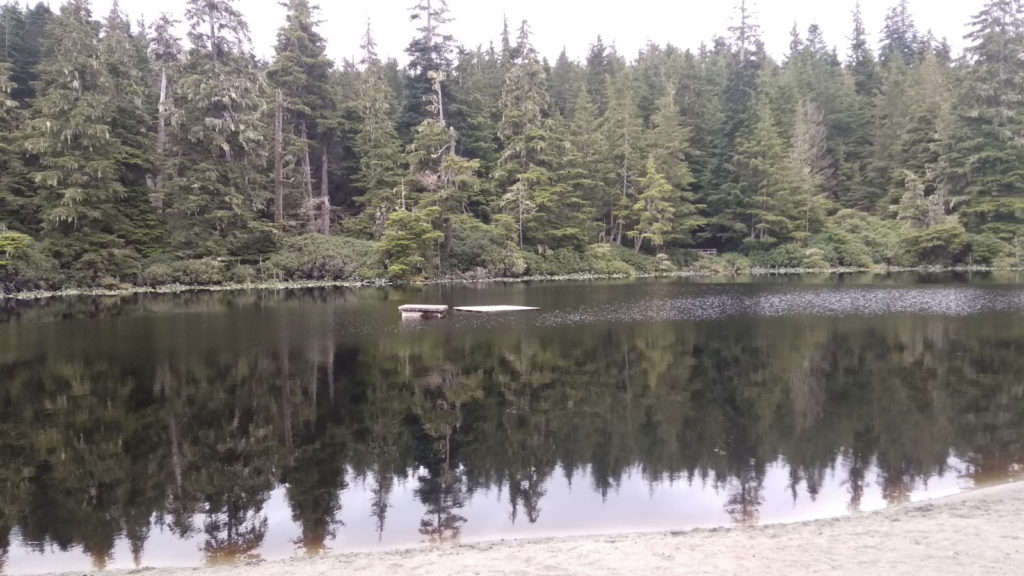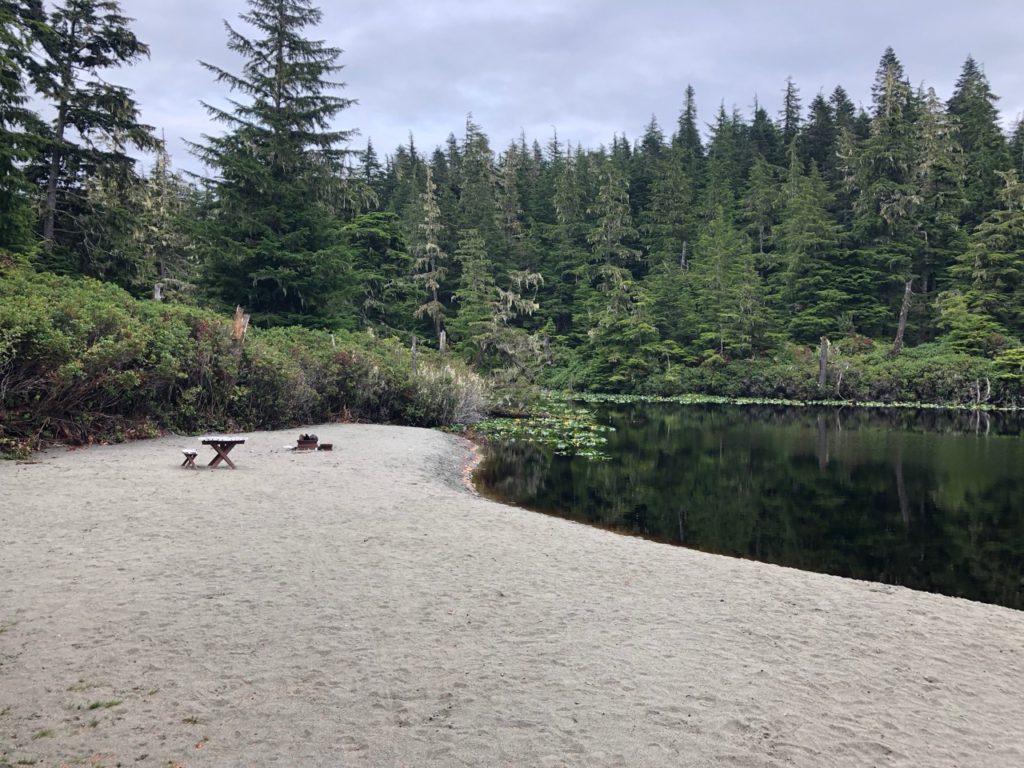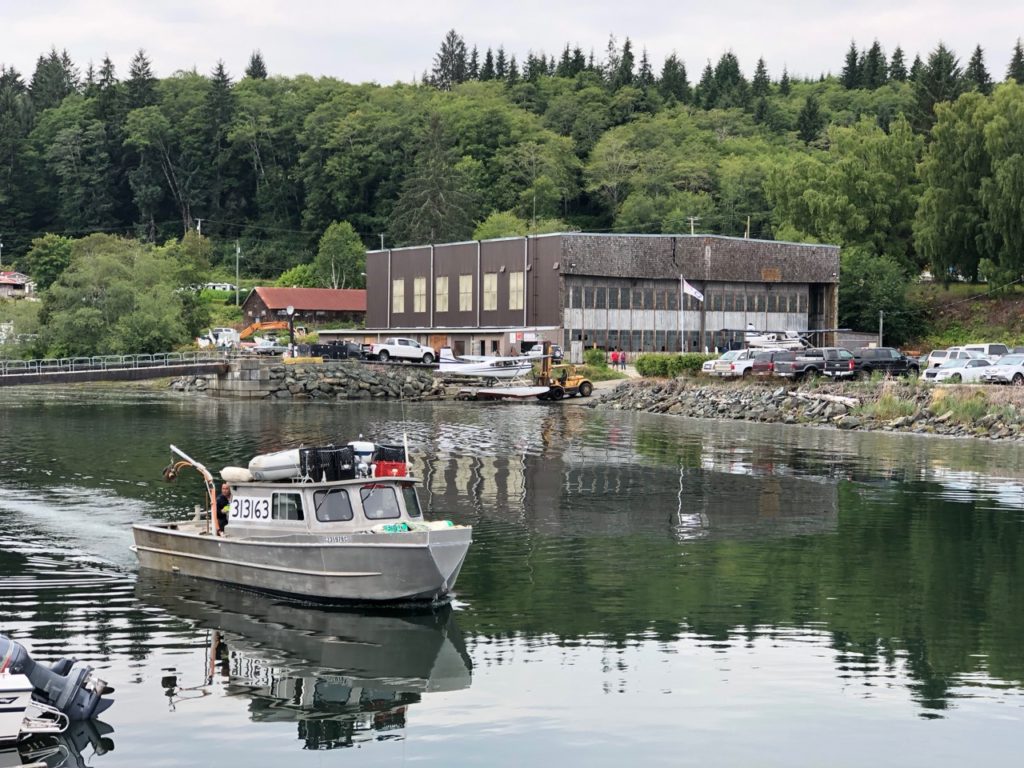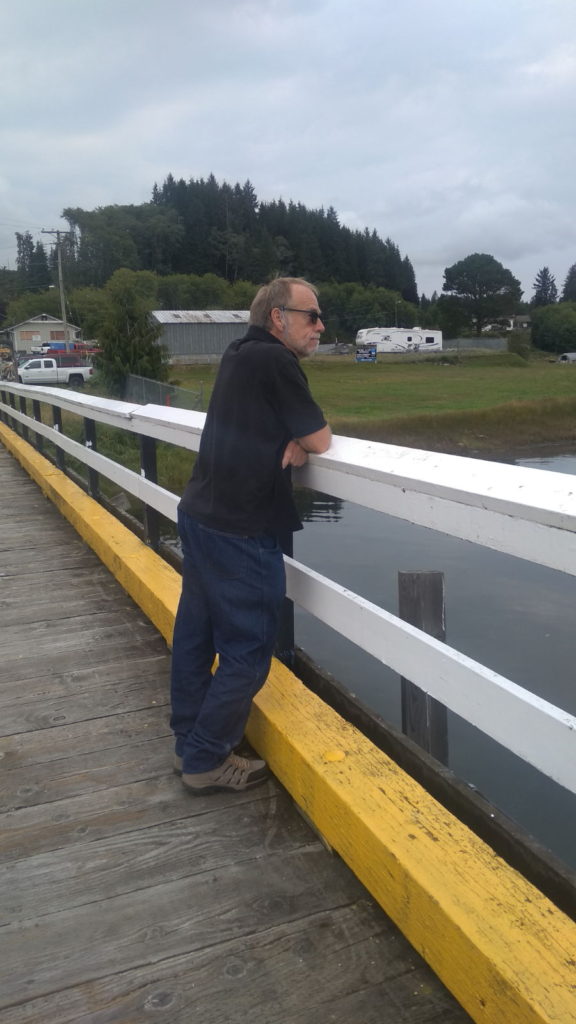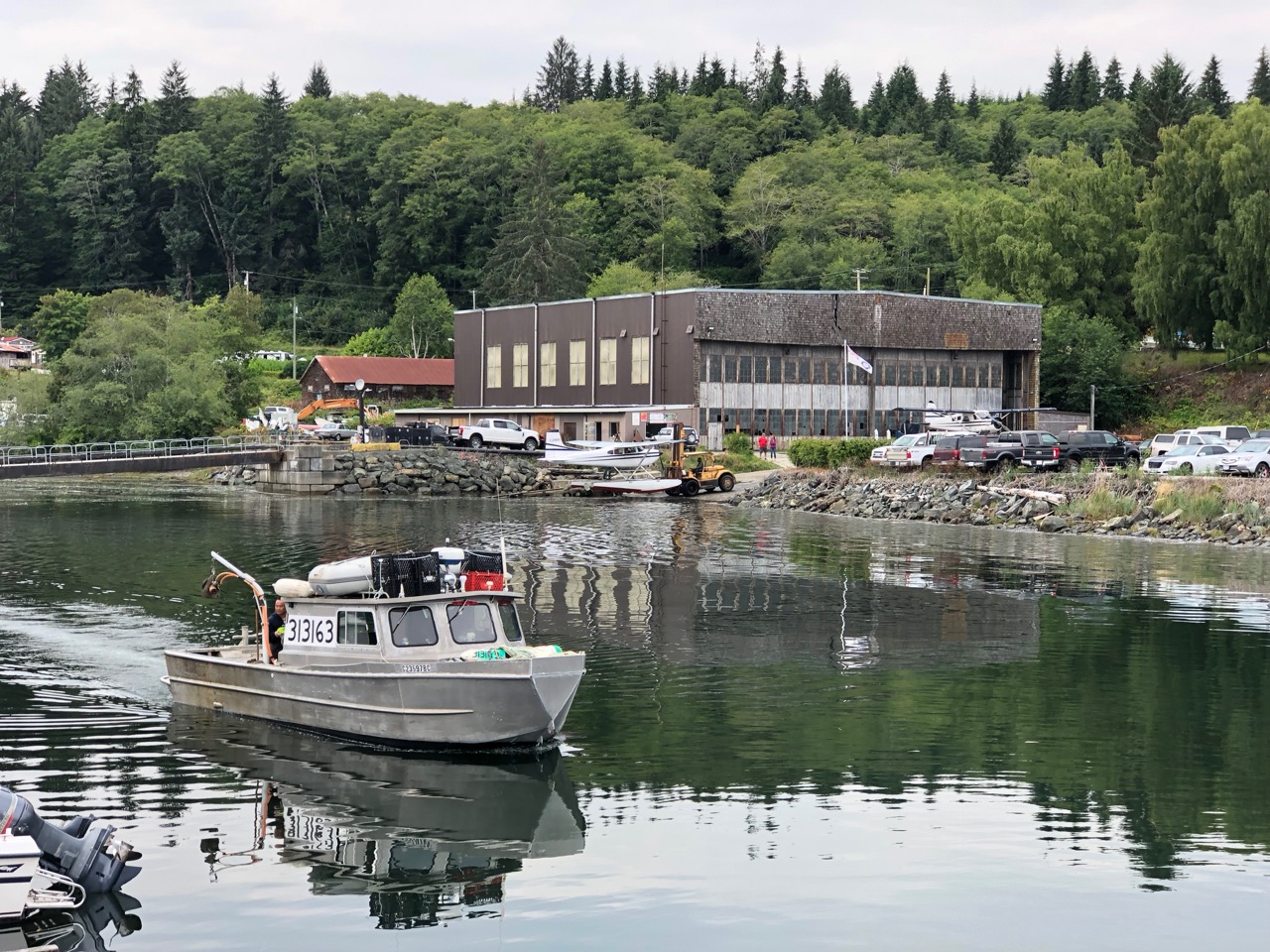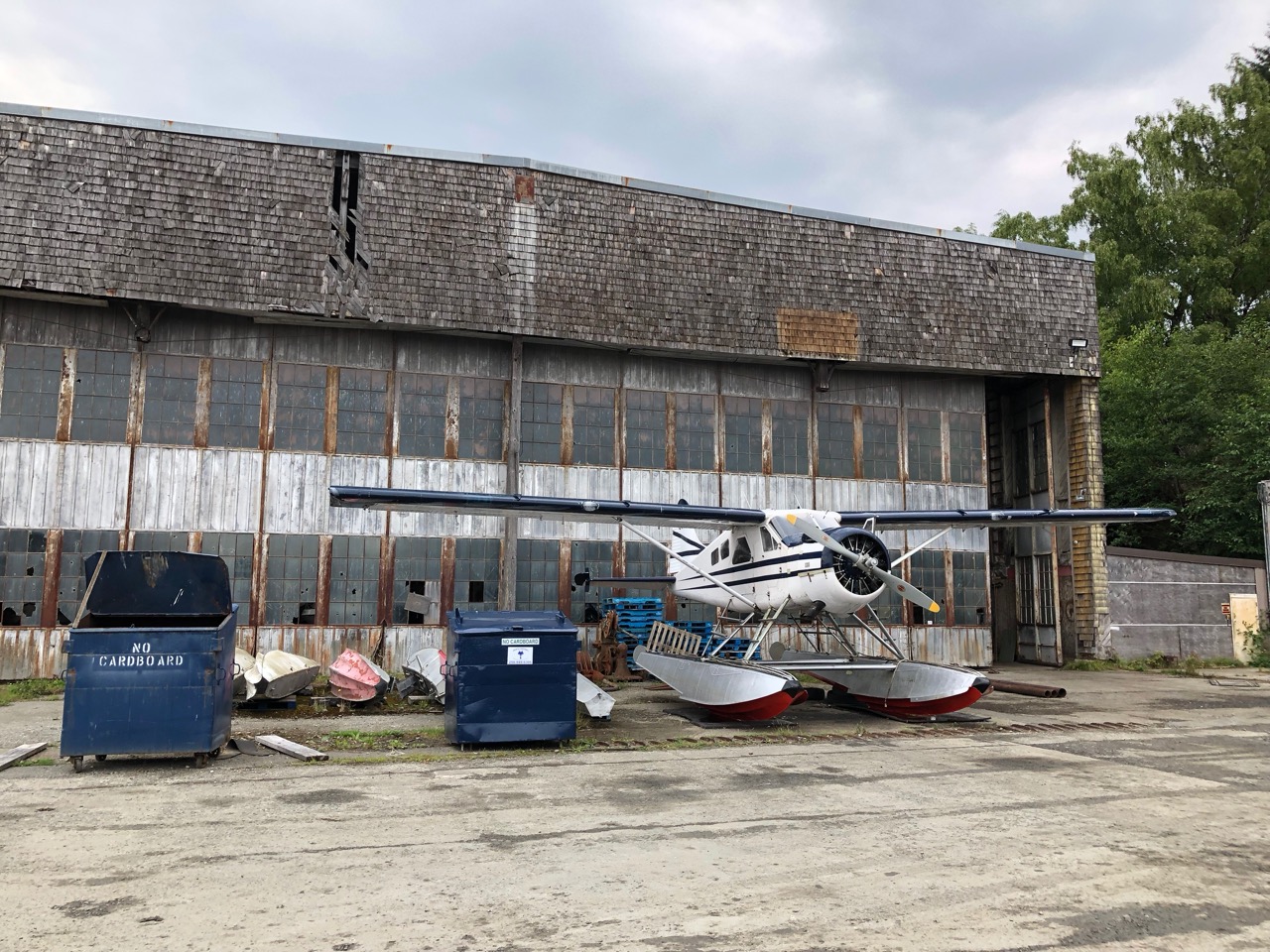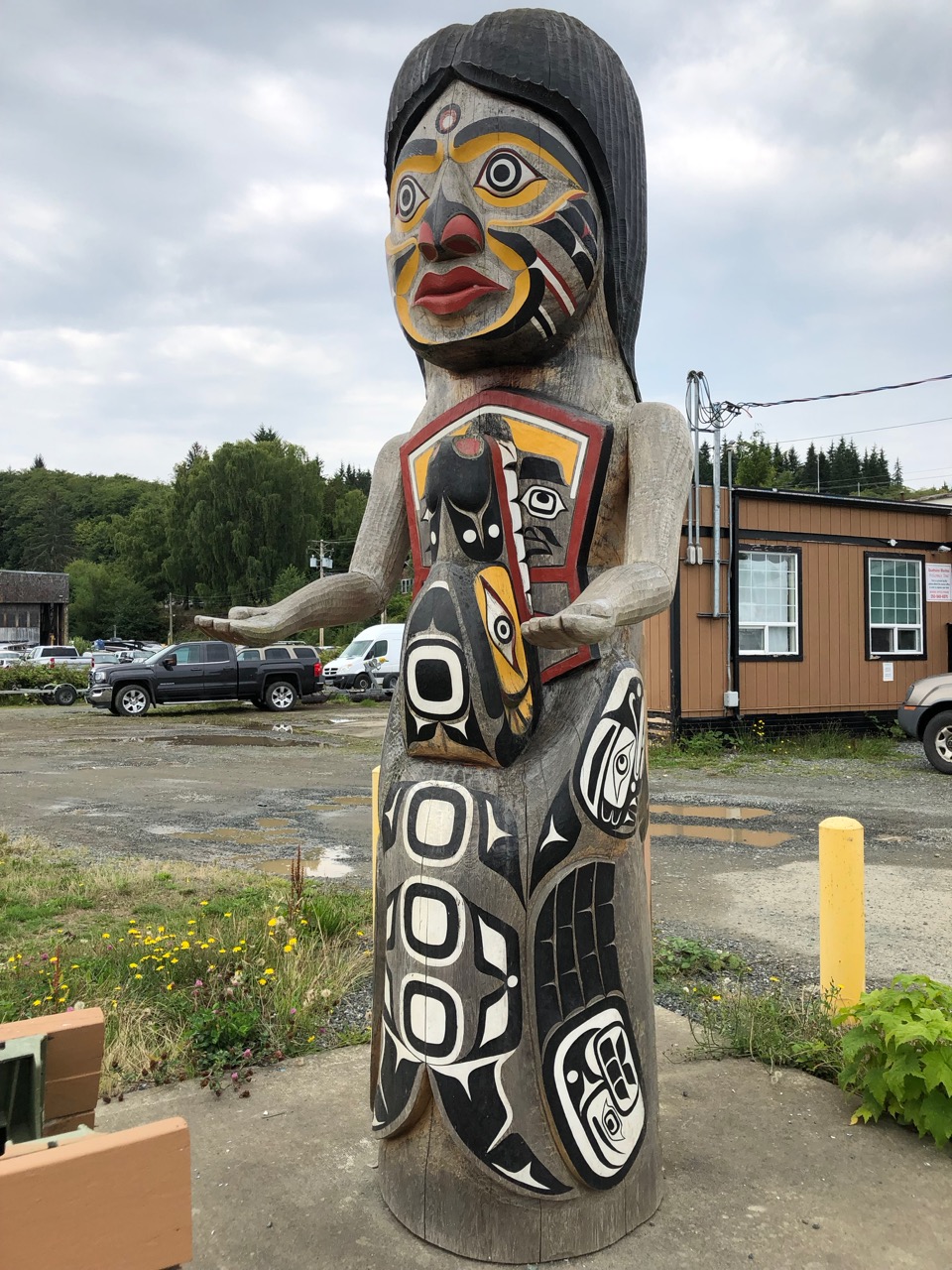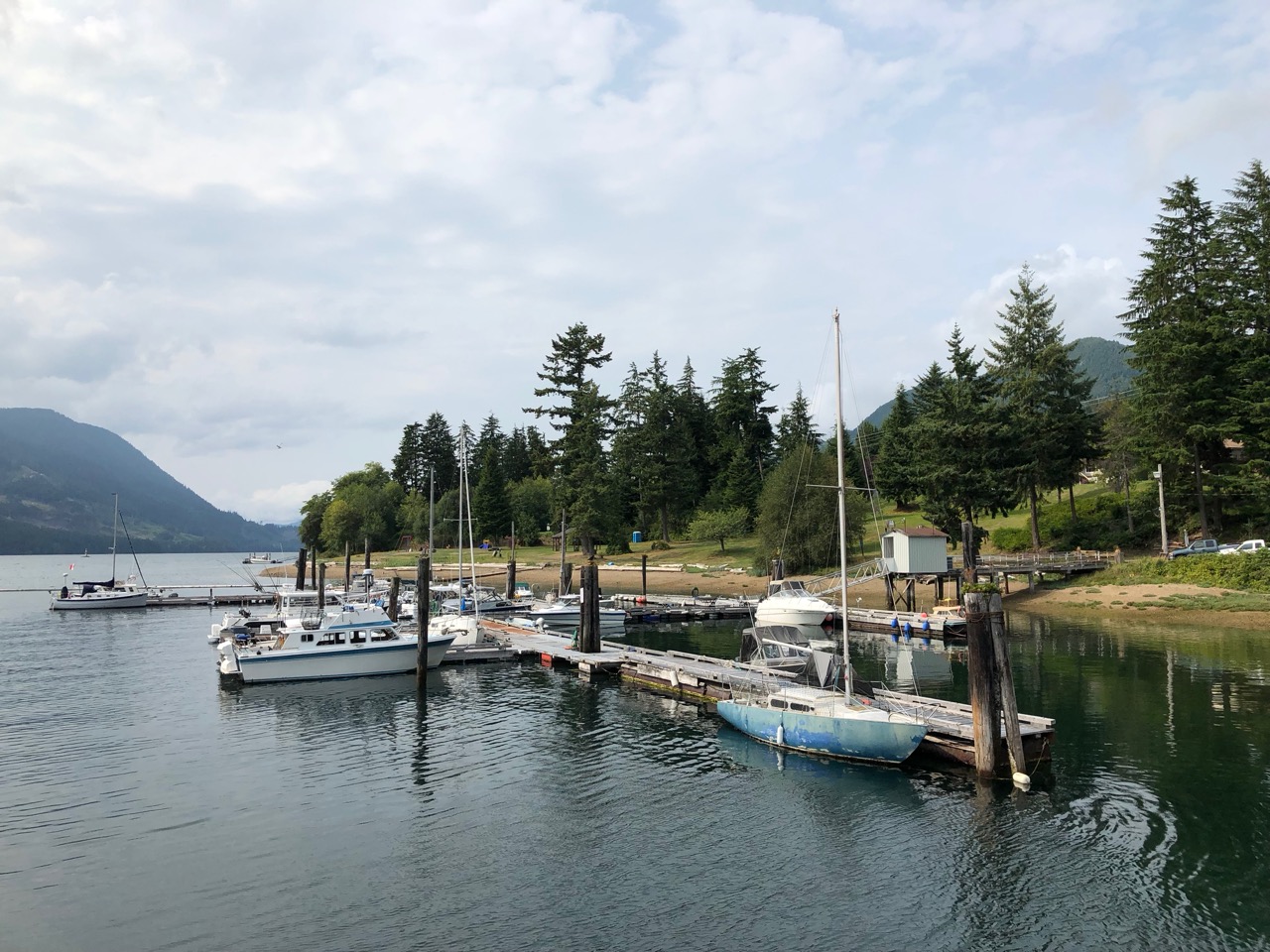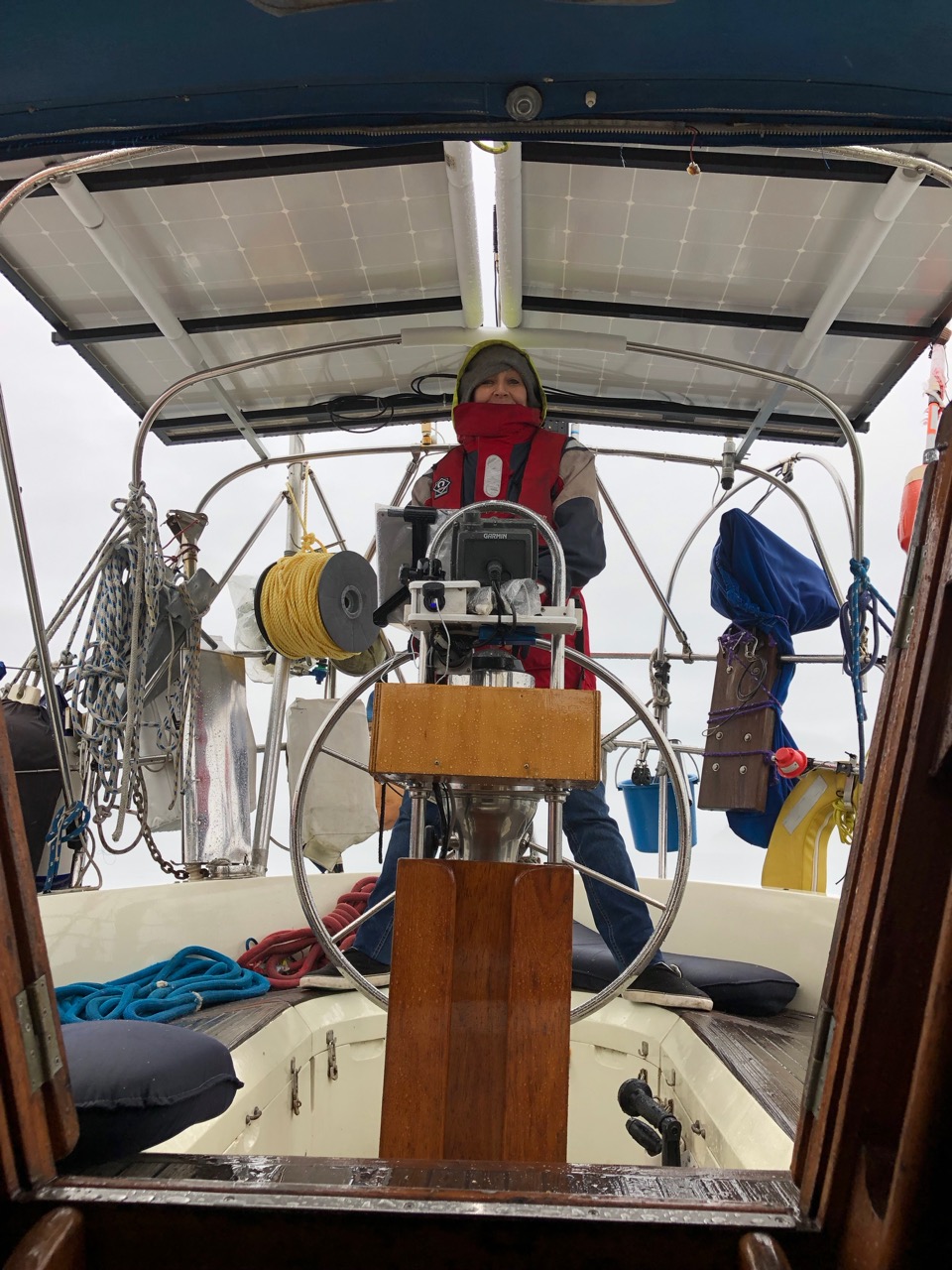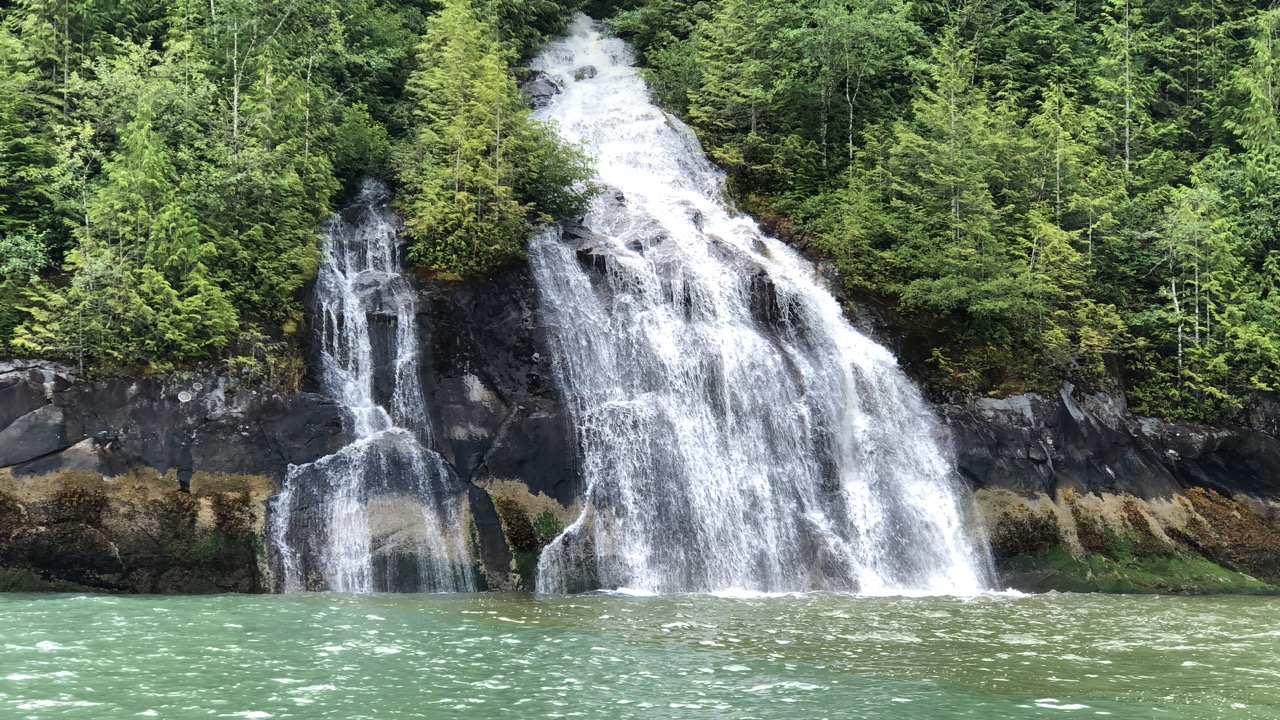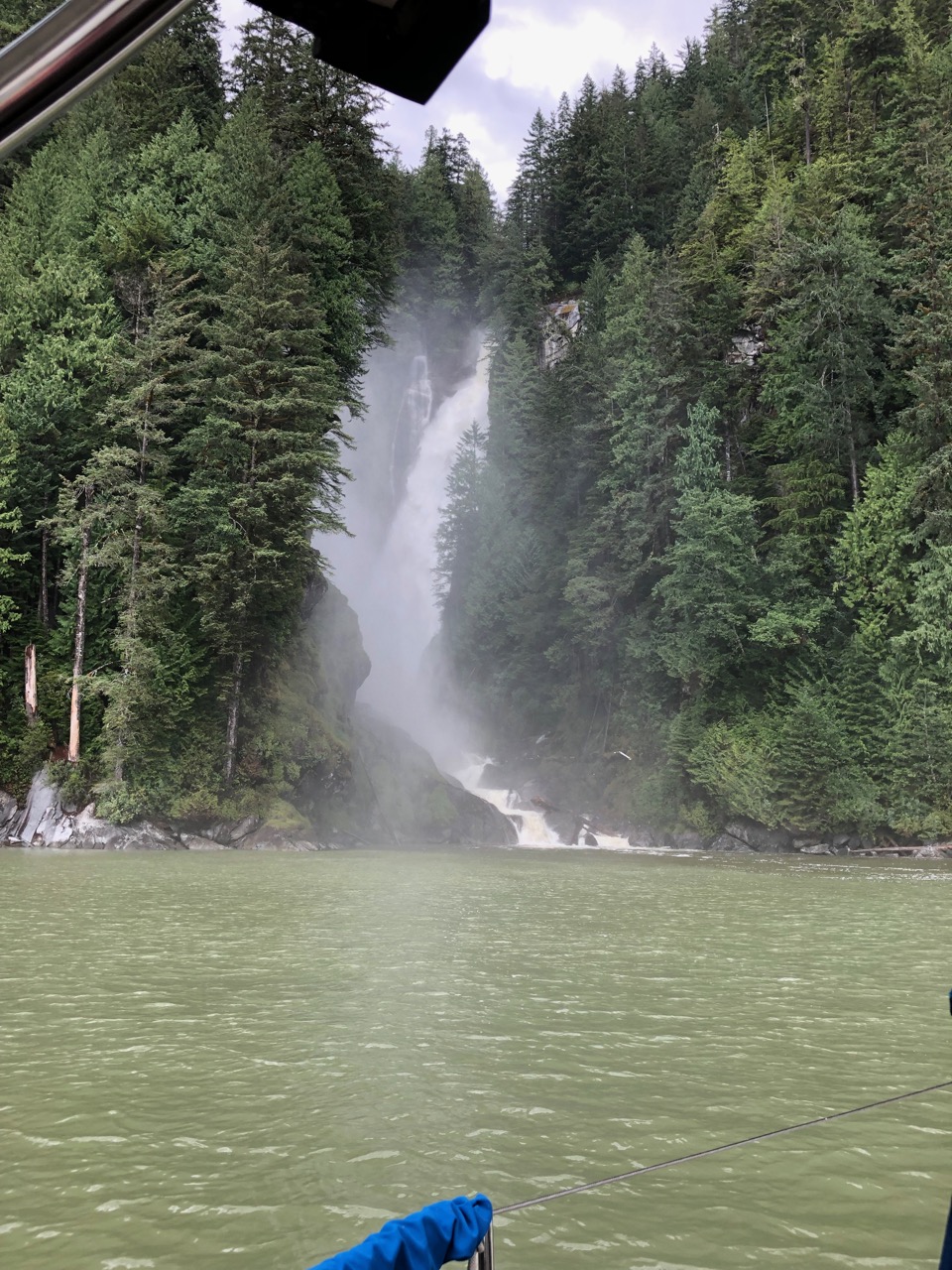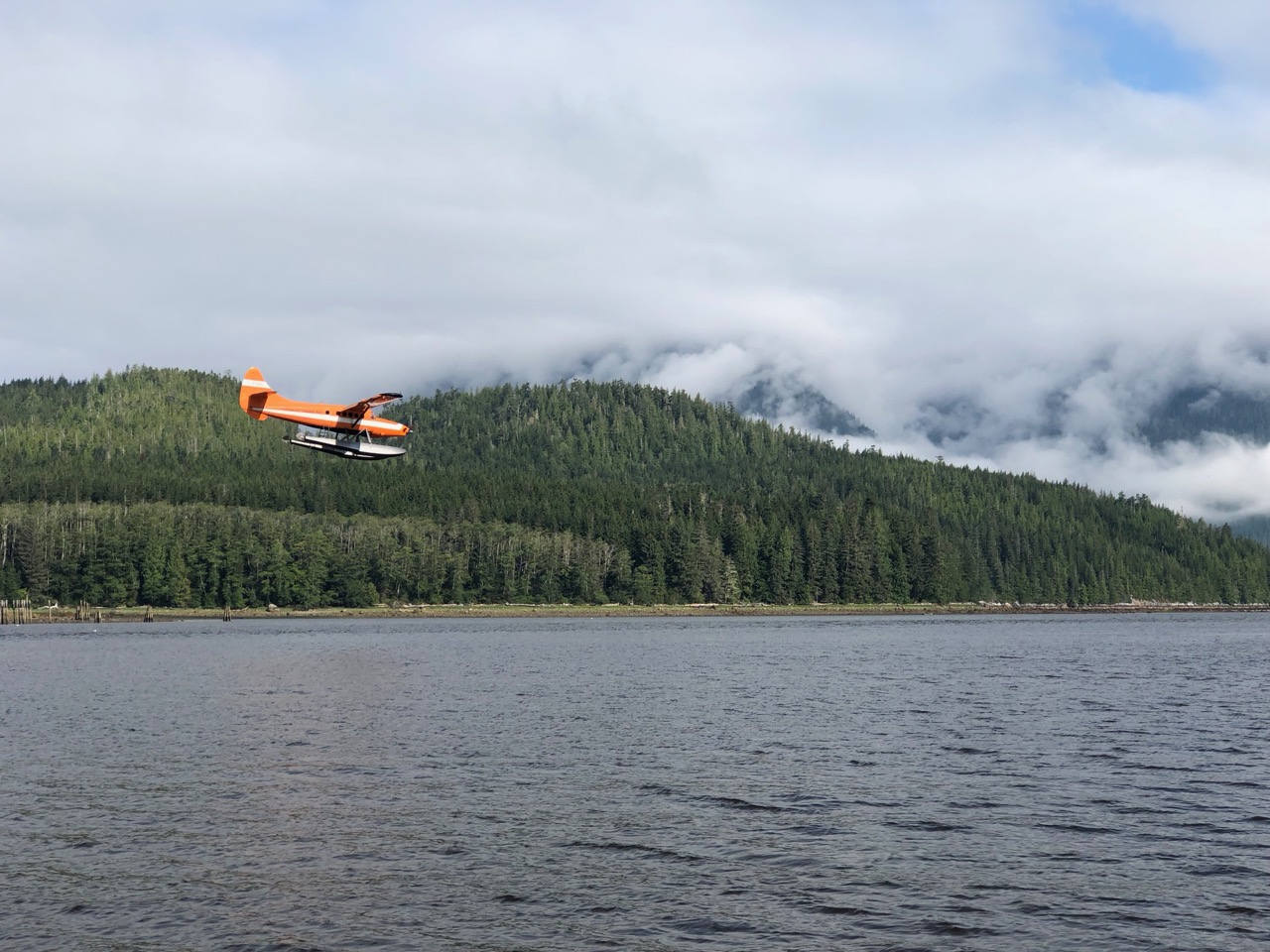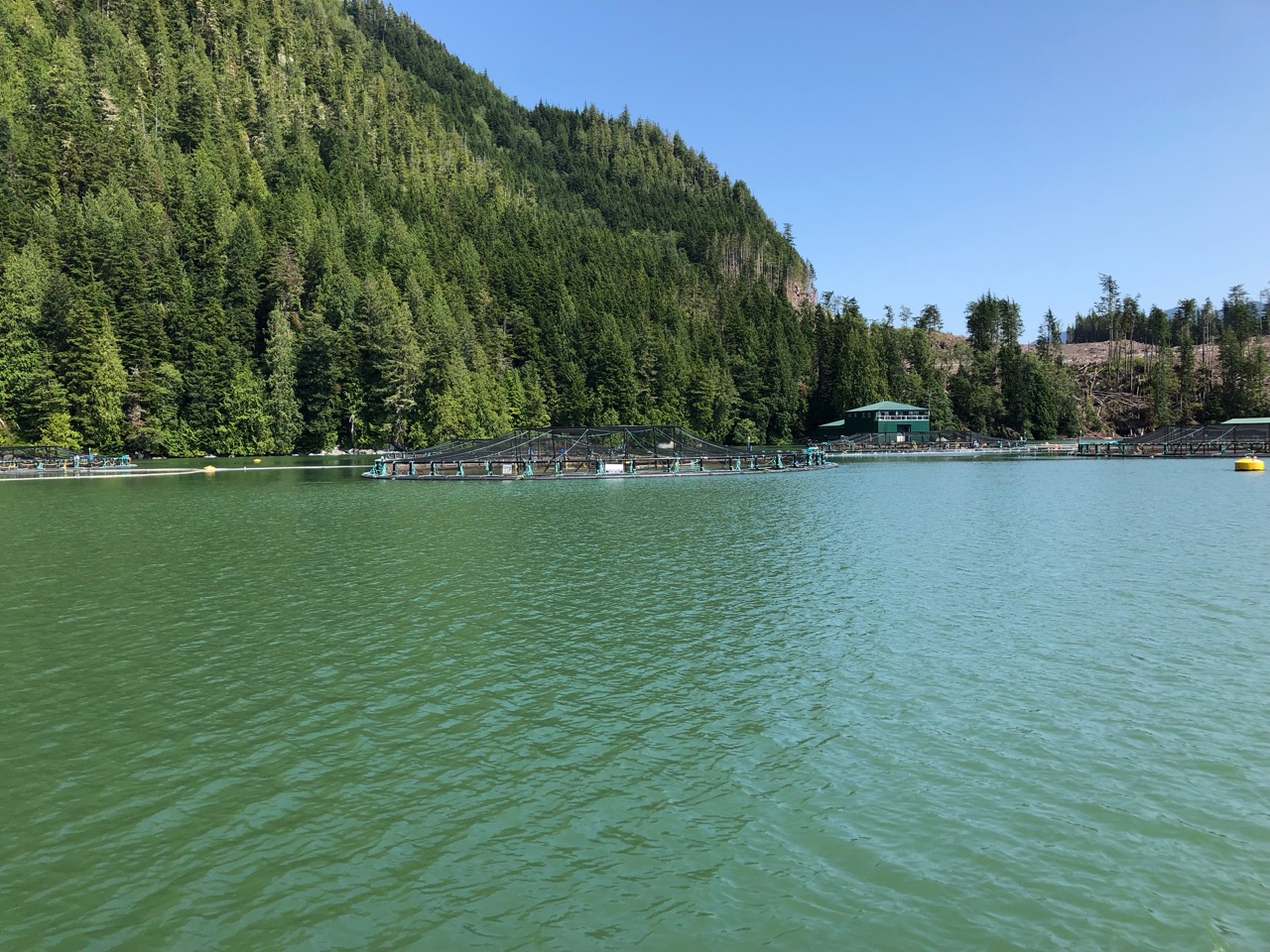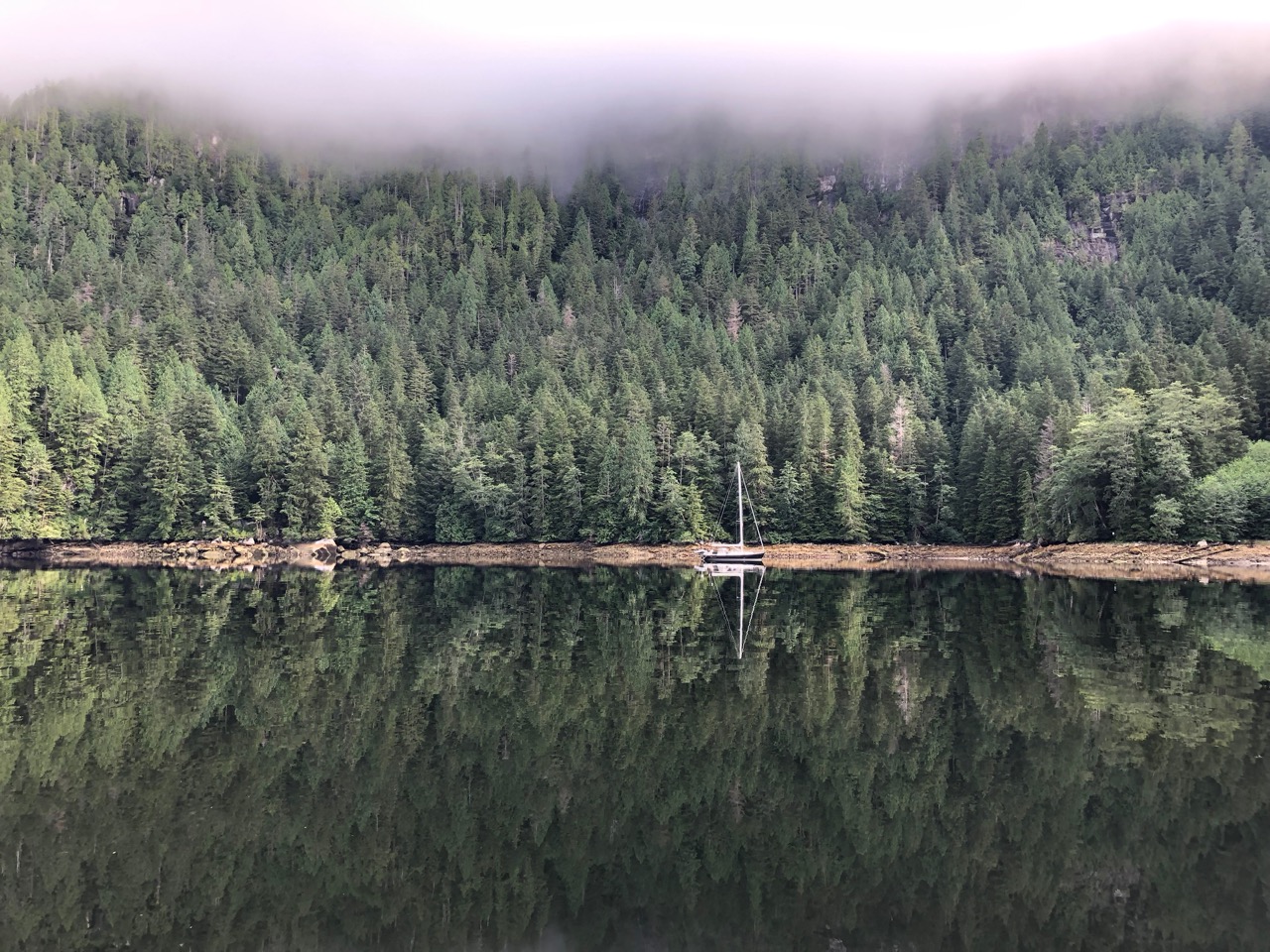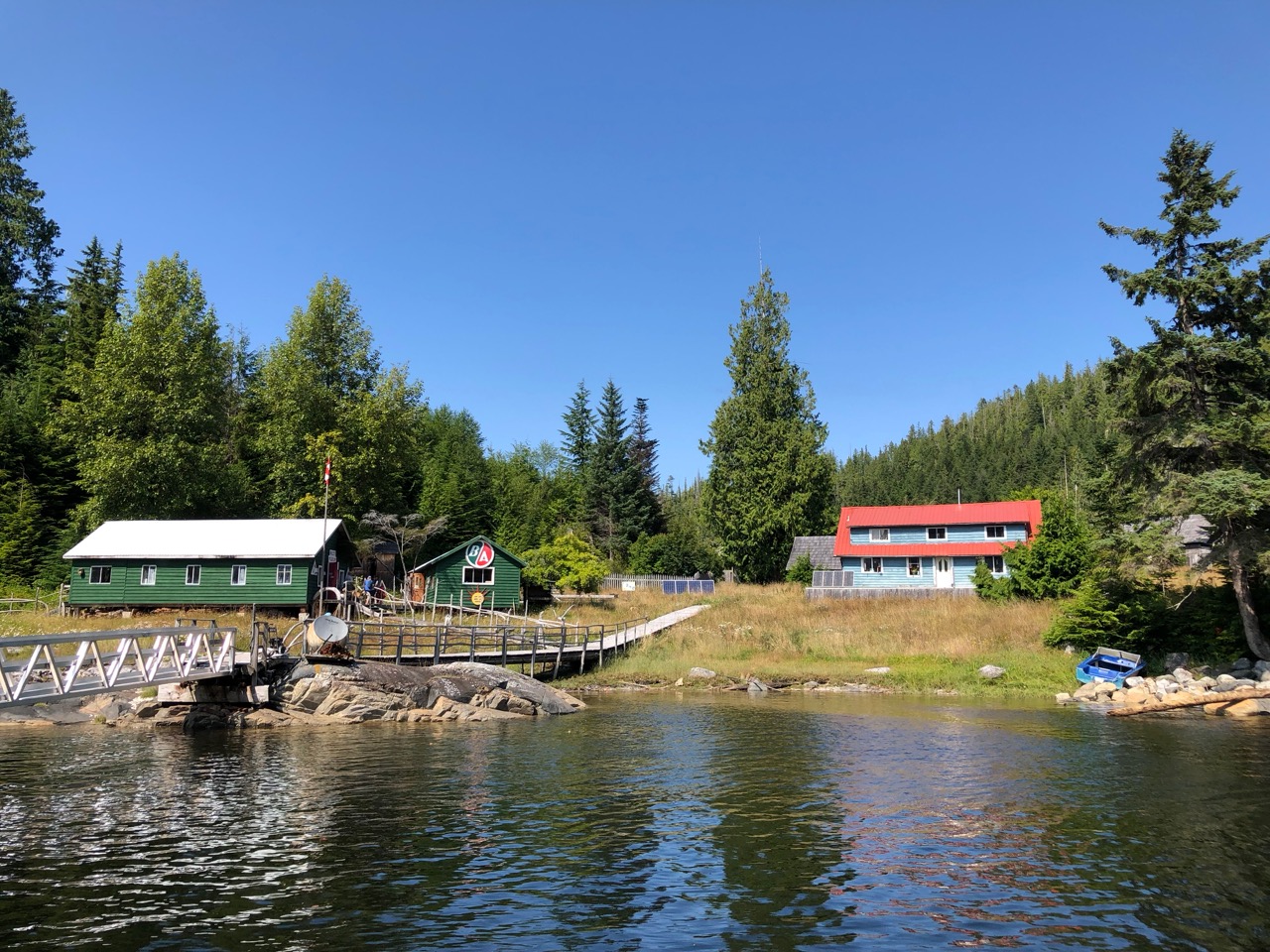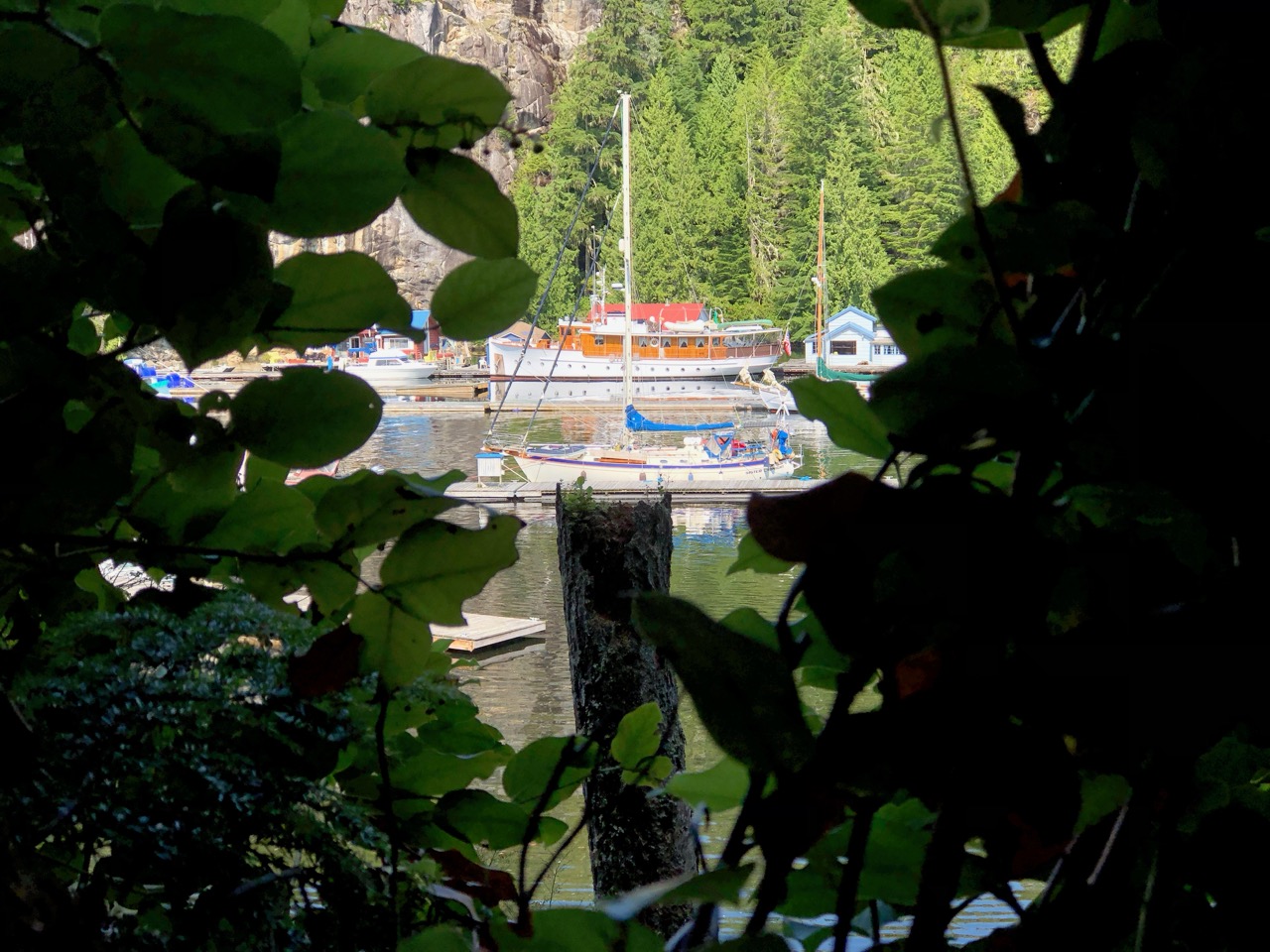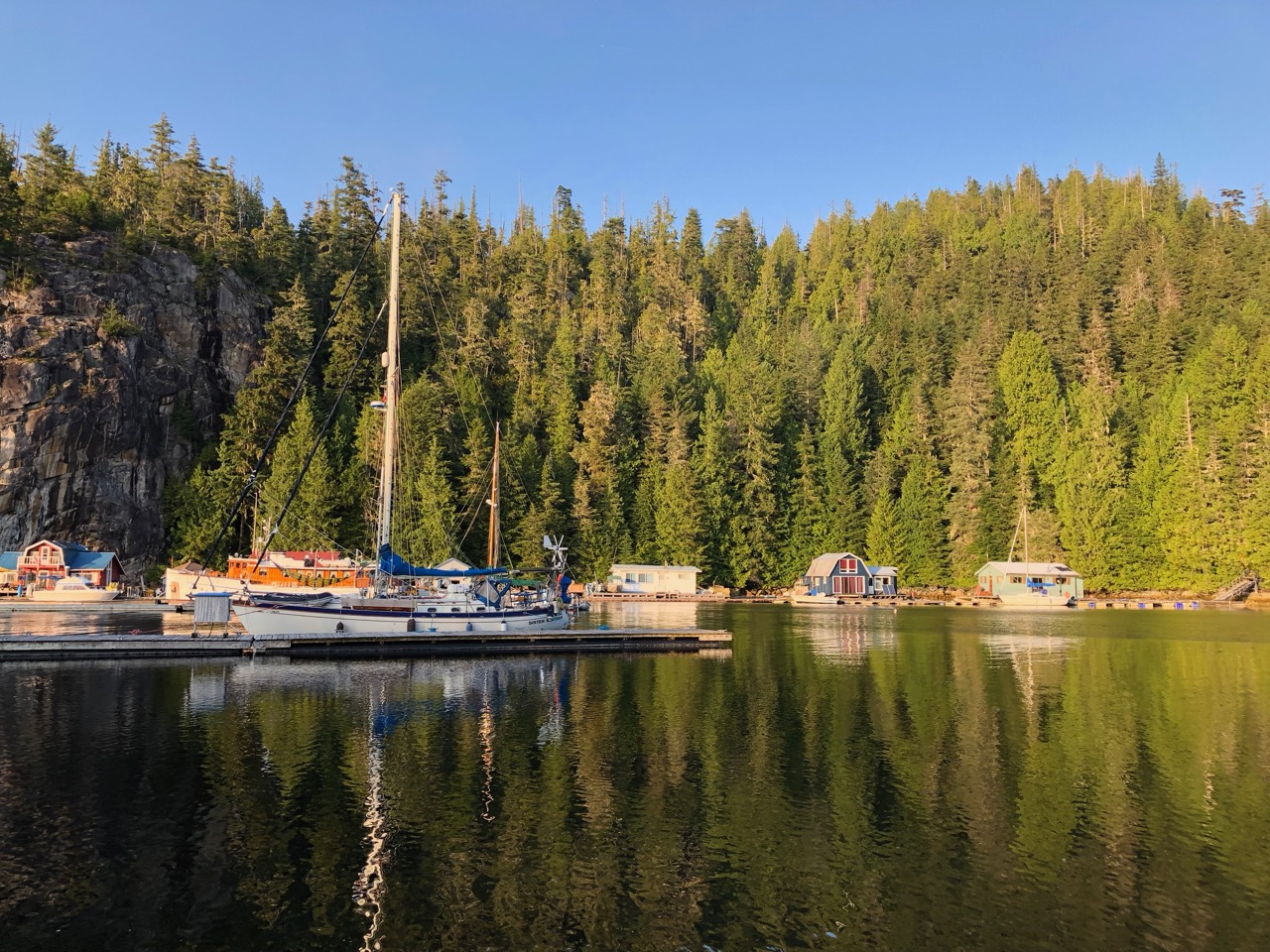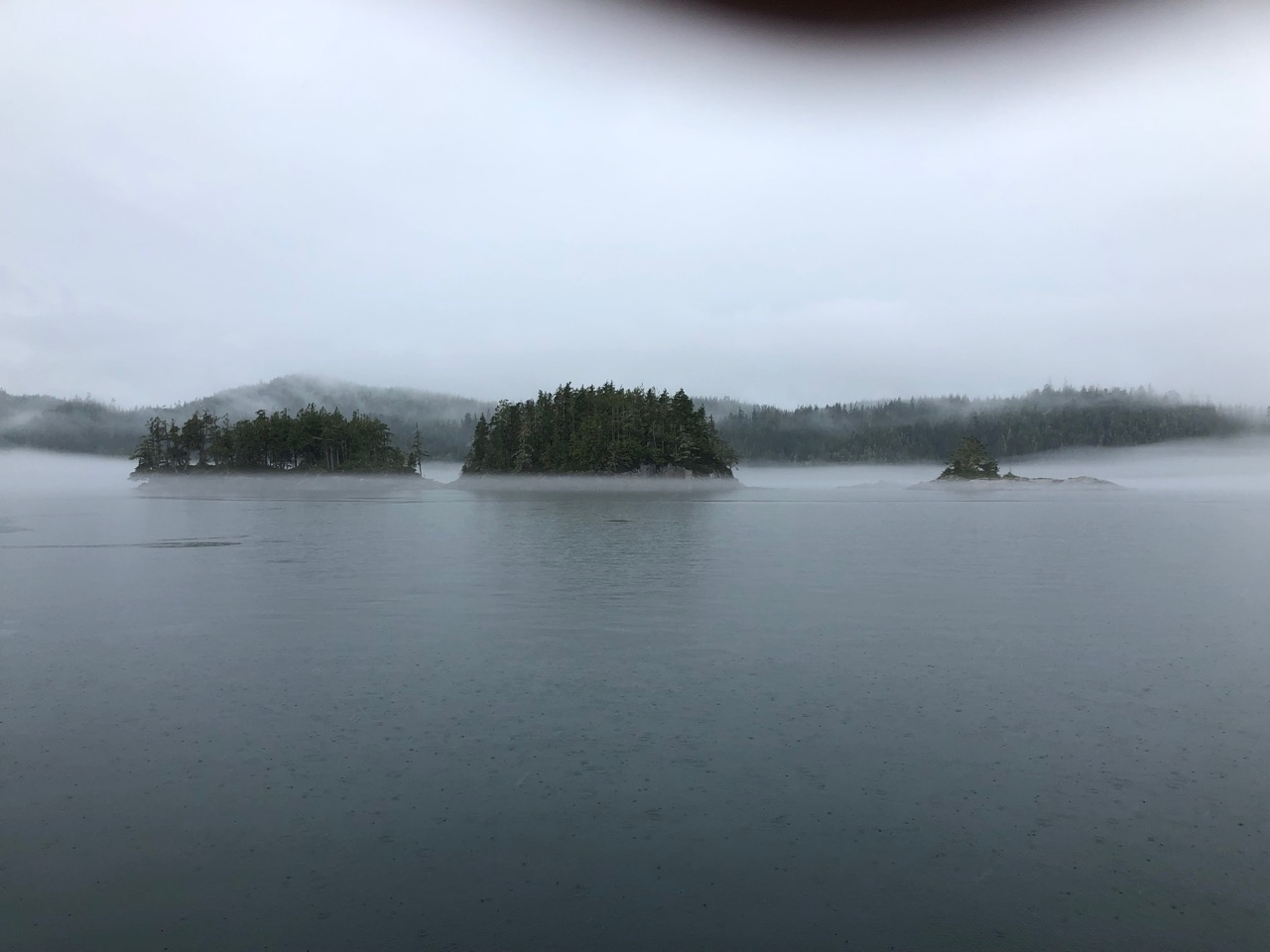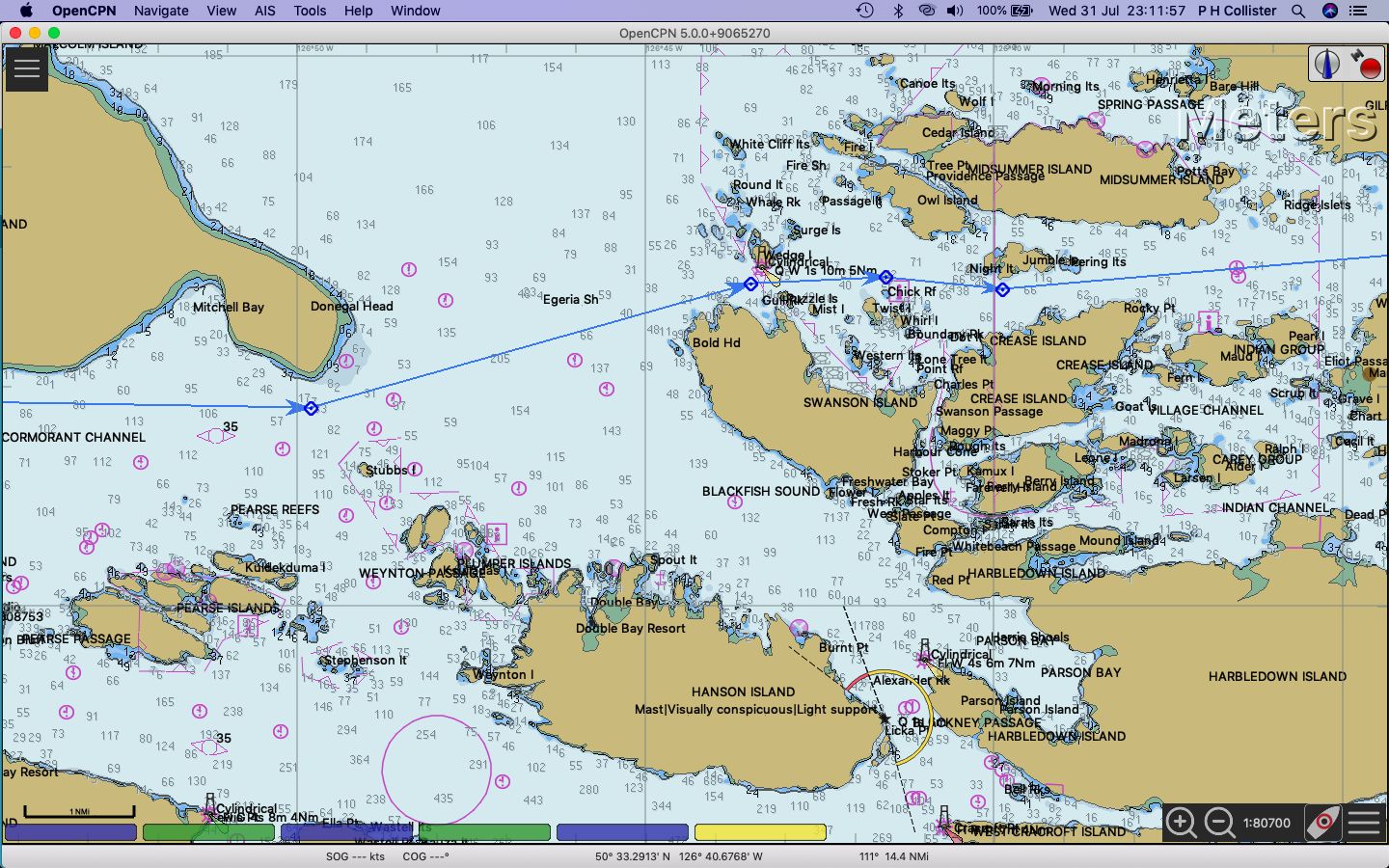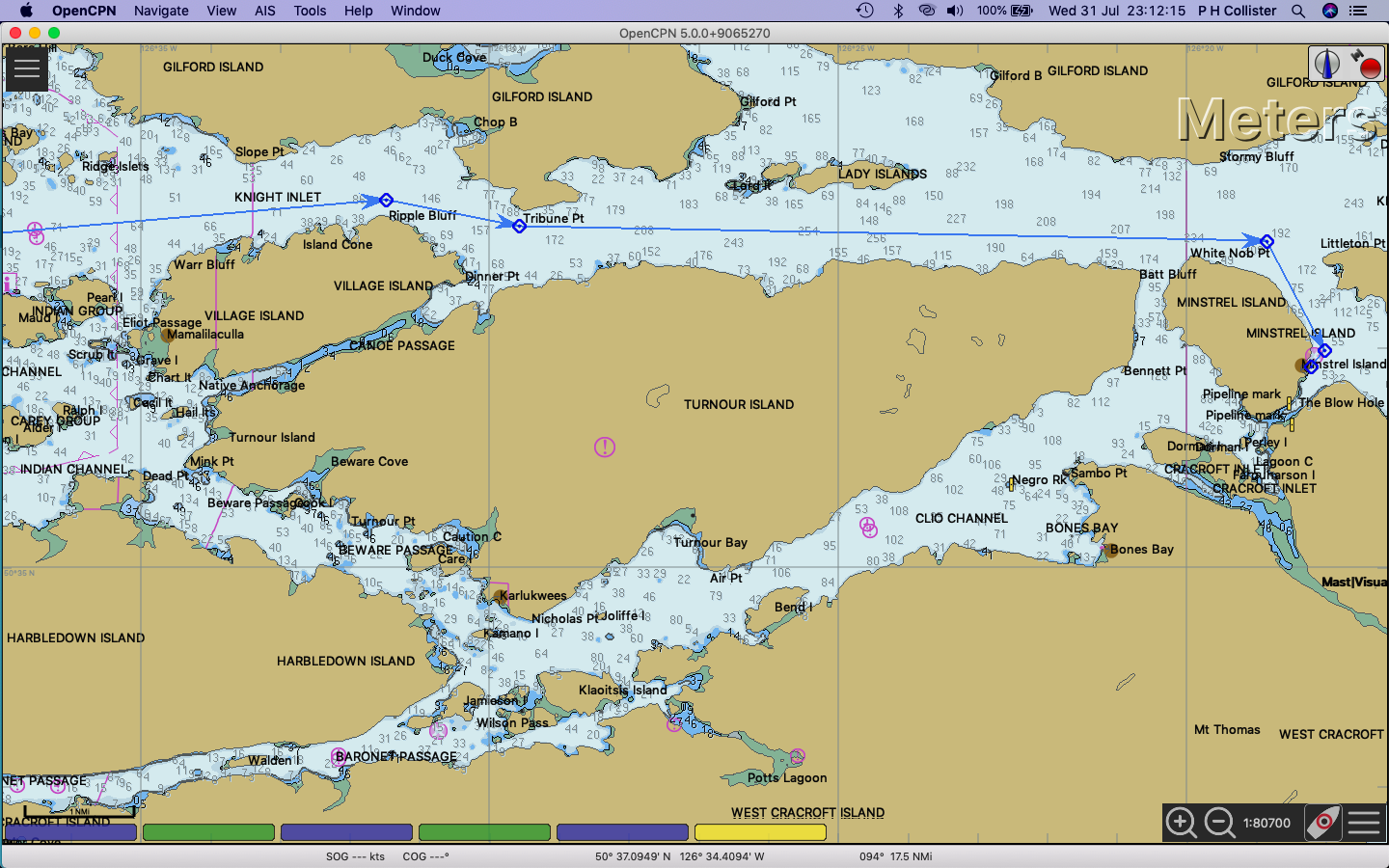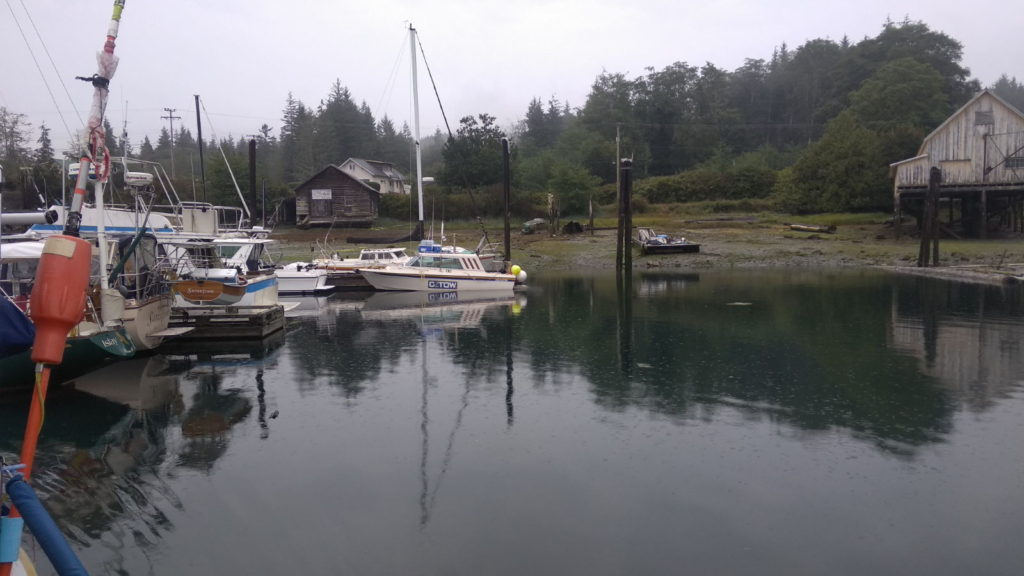
:
Fogust is the term used by Canadians for this time of year when fog is guaranteed most days. As if to prove this, the air around us was milky white when we got up on the first morning of August. It had rained heavily through the night and the temperature had dropped. After a short discussion about whether to set off or not, we came to the conclusion that we would only be hanging around the harbour on a damp, chilly day, and might just as well be going somewhere. There was every chance the fog could clear as the day went on anyway. We left Sointula at 9 30 for the 5 or 6 hour passage to Minstrel Island, a place where Grizzlies had been spotted lots of times according to reports in our nautical guides.
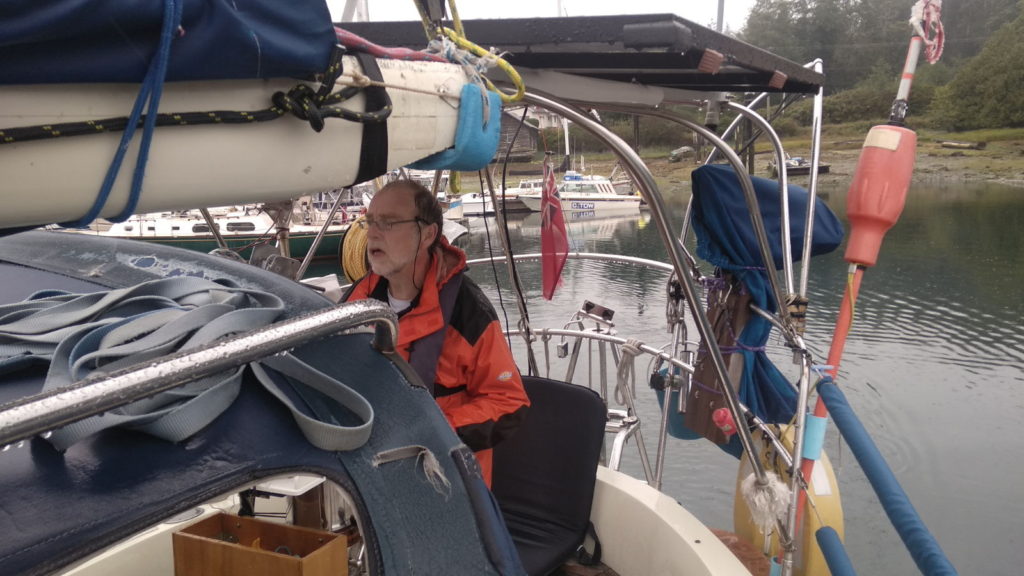
We hadn’t gone far when we discovered the autohelm wasn’t working. I knew Paul could fix it but he wasn’t going to be able to do that during this passage. The fog was fairly thick around us and it got steadily colder and wetter as drizzly rain began to fall as we progressed further out. We would need both pairs of hands and eyes in these conditions, faced as we were with hours of hand steering. This brought home to me how much I have come to take the autohelm for granted. Invariably we untie from marinas, weigh anchor or slip a mooring buoy, motor out for 5 or 10 minutes, and then switch over to autohelm and relax (most of the time). It frees us up to get on with other things. I remembered a night not long after Paul had acquired Lady Stardust in 2005 on a night passage returning to Liverpool from The Isle of Mann. It was freezing cold, pitch dark, and the sea was rough enough to lurch us from side to side. We didn’t have autohelm then and took turns hand steering for four hours each throughout the night. I can still feel how chilled through I felt, and how cold my hands and feet got, despite being encased in layers of thermal gear, a full set of oilies, woollen hats and gloves etc. Staring out at the fog and rain this morning, I comforted myself with the fact that at least it wouldn’t be that bad. Such poor visibility does make you feel vulnerable, though: it was only possible to see a couple of feet ahead. This wasn’t quite how I imagined my first day back at sea would be after nine months away from the boat.
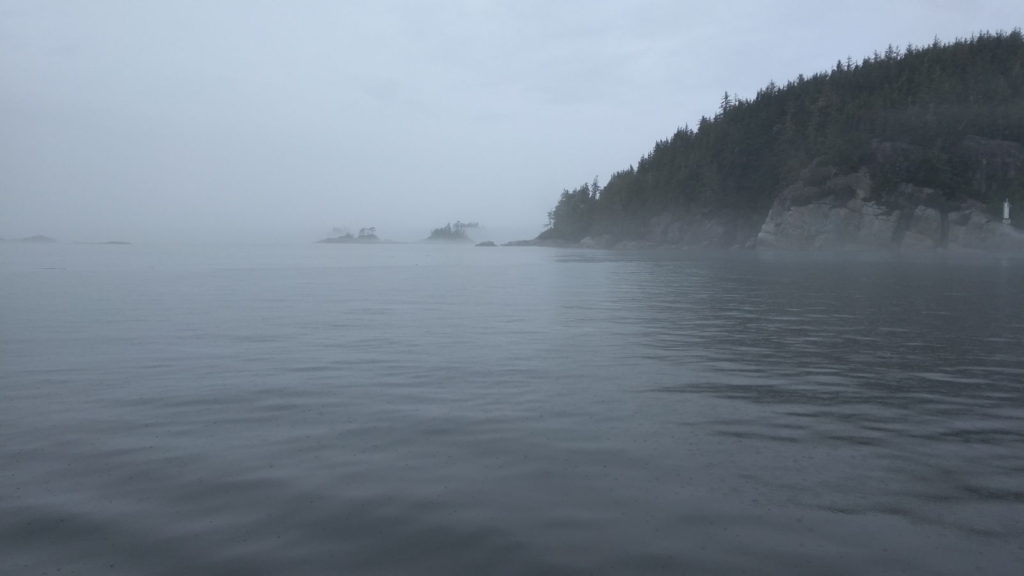
It did at least provide us with an opportunity to test out the new radar, and for me to re-familiarise myself with the AIS. I positioned myself at the chart table and studied both screens until I got the hang of how the information on the radar was displayed. Paul told me to watch for consistent shapes as opposed to ones that faded off after a couple of appearances, since that was the difference between a vessel and large pieces of debris or logs that the radar picks up. We did 90 minute alternate stints on the steering but the cold got through to me after only half an hour and I realised I’d been hasty in thinking I didn’t need to clad myself in full weatherproof gear. Being so constantly occupied and vigilant made the 5 hour journey go very fast, however, and the fog had lifted a bit by the time we approached our destination. We tied up to a pontoon that had once been part of a thriving marina but which was now abandoned. It was an eerie looking place, with only a couple of other boats taking advantage of the free berthing. Nature has already begun to claim back part of the constructions, and Paul had heard that the place was scheduled for complete demolition sometime soon. For now, though it was a welcome break from the fog and cold. We wasted no time in putting the heater on and shutting the hatches against the wind. The rain got heavier an hour or so later.
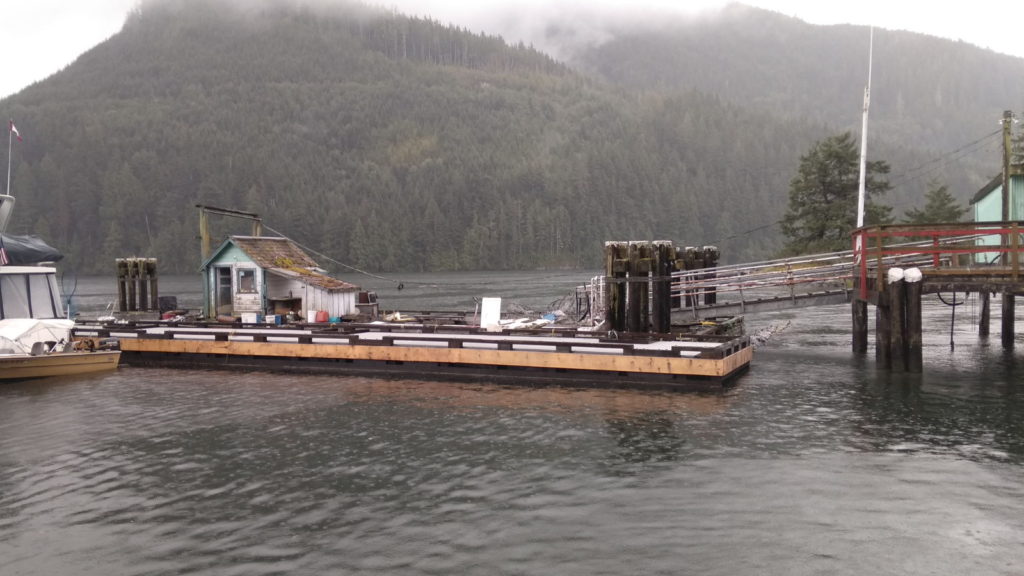
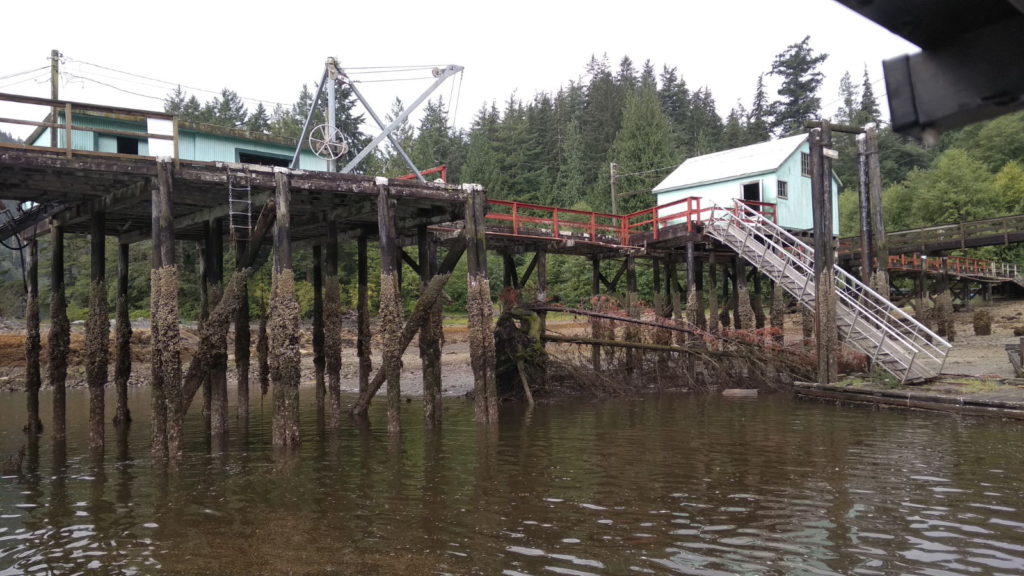
It rained heavily all night again, and a couple of times when I woke during the night I could see flashes of lightning through the V-berth’s hatch, but we slept well despite this. It was dark and peaceful and most importantly, warm in the morning. The air didn’t feel quite as icy when I stepped out into the cockpit, and the rain had stopped. I was particularly pleased by the lack of fog. Only a few wispy strands clung to the tree tops when we motored off at 9am.
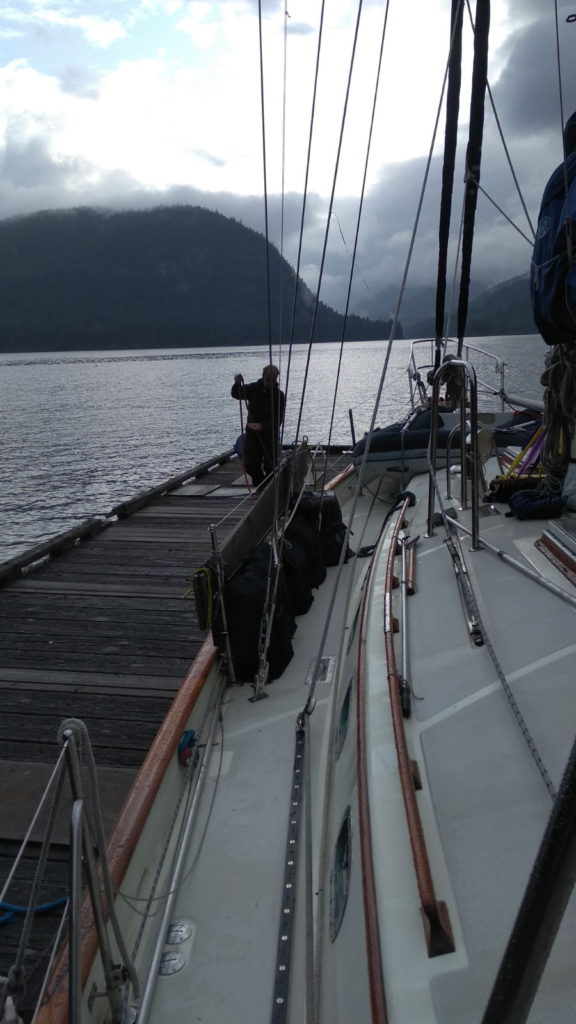
A couple of hours later it was clear, calm and dry enough for Paul to get on with the task of fixing the autohelm. Once that was working it was pleasantly mild enough to stand on deck and scour the shore for signs of life. Very few other boats were around and by 2pm we’d made such good progress Paul decided we’d motor on past our intended stop at Glendale Cove and carry on further into British Columbia’s longest fjord (70 miles long and two miles wide). This was in order to see the waterfalls that had been recommended to us. They were indeed a sight worth seeing, cascading down into the sea from mountain heights of up to 6,000 feet; a truly mesmerising sight and sound. The environment on either side of us looked ideal for bear-sightings but all we saw were hawks and eagles soaring above the water ready to pounce on their prey – a magnificent sight in itself, but I desperately wanted to see a bear.
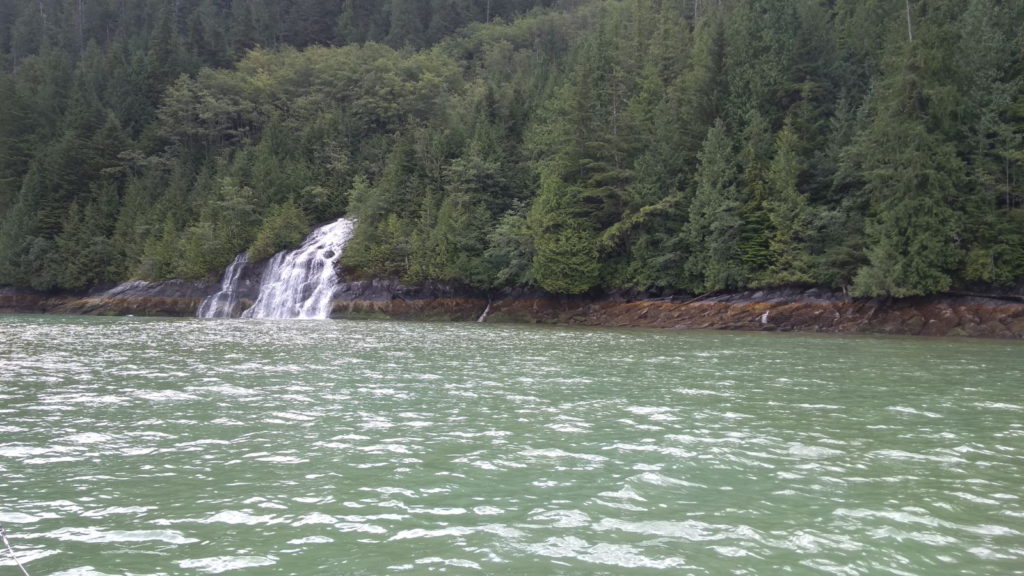
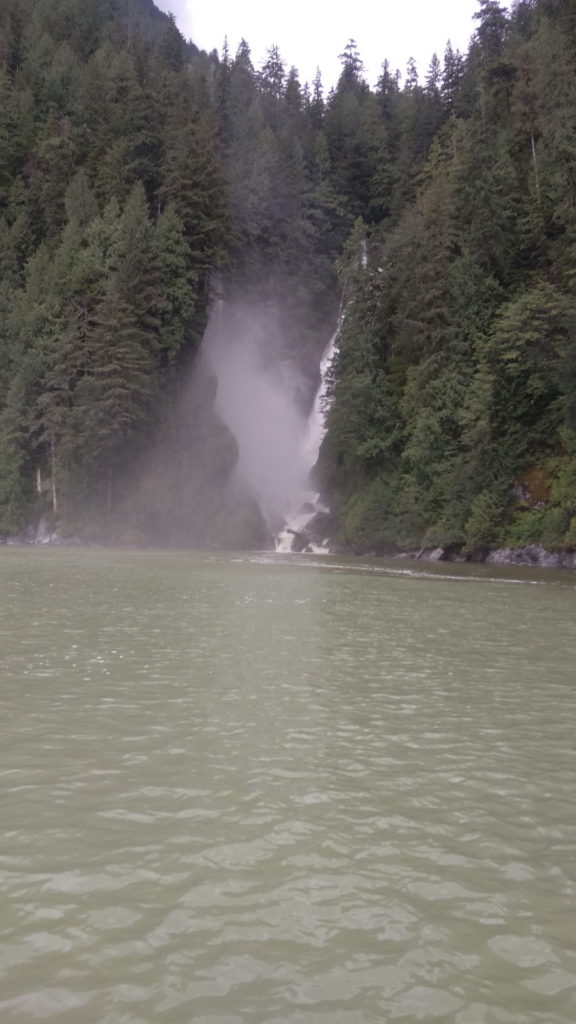
We doubled back and returned to the anchorage at Glendale. There is a lodge and accommodation on shore specifically for Grizzly bear tours so we were definitely in the right place: our nautical guide, Waggoners, the authority for cruisers in this area, claims it has the highest concentration of Grizzly bears on BC’s west coast. After anchoring we continued to scour the shore until evening fell but it remained disappointingly empty of life.
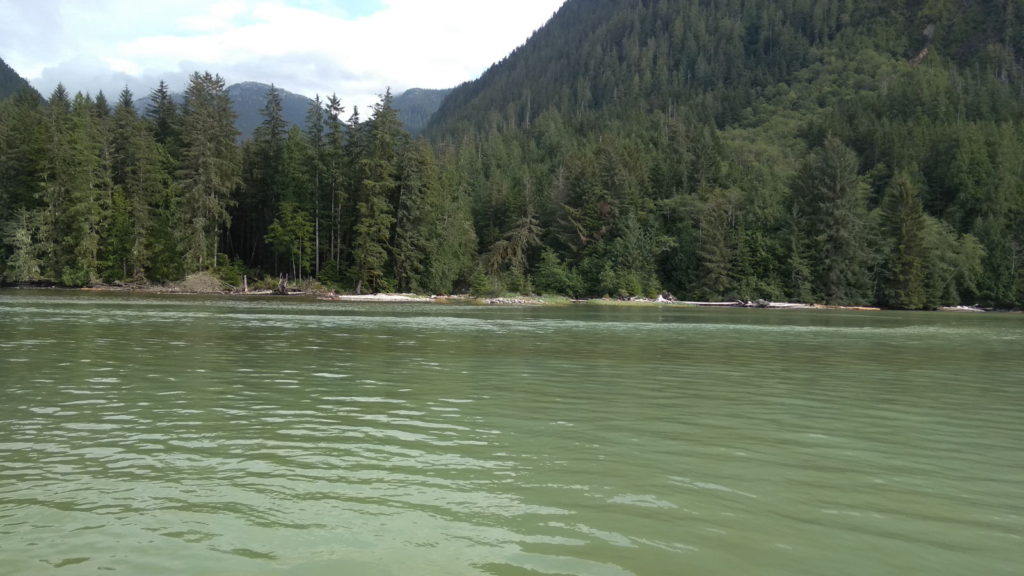
On Saturday 3rd August we were up early to check on the depth as there had been a concern about our position in the shallow part. Boats and kayaks from the lodge were out and we tuned into their radio frequency, knowing they would probably communicate sightings and locations amongst each other. One passing kayaker told Paul he’d seen three bears the previous day, and if we waited long enough we were sure to spot one. Meanwhile, there was plenty around to keep us entertained as sea birds descended for the morsels to be found in the mud from the receded tide. Gulls, herons and lots of other birds that we didn’t know the names of, flew down pecking on the beach and getting aggressive with those who tried to get too close to them. They all seemed to fear the mighty eagle, though – flying off en masse whenever it swooped near them.
Once the tide had risen again, it was time for us to be moving on. Several of the lodge boats were gathered near the shore of a beach as we began to motor out into the bay. It became clear they were watching something, so still and focused were the passengers. Paul was the first to spot that it was a bear. Grabbing the other binoculars, I could hardly contain my excitement when I saw it too. A Grizzly bear, foraging only feet from us, and not at all fazed by so many pairs of eyes staring at it. I’m not ashamed to say it brought tears to my eyes. I’ve always loved bears, and have long lamented the rough deal some of them get at the hands of humans. This one was living as it should be, going about its business undisturbed, and with cameras, not guns, aiming at it. We watched for half an hour before I could tear my eyes away. Paul got a fairly good video clip of it but mine didn’t come out as well as I’d hoped. Still, there would be more to see (hopefully).
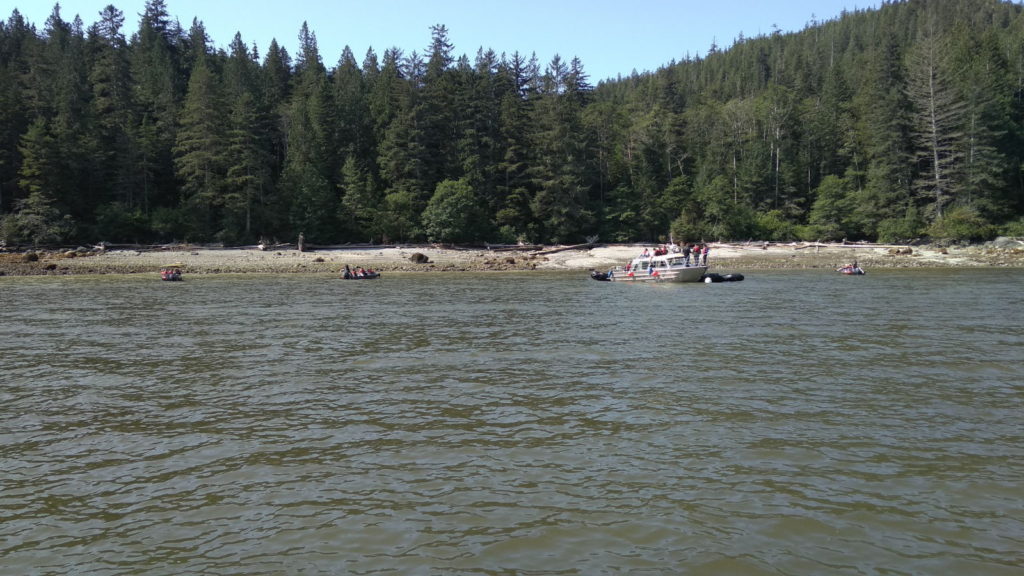
We journeyed on through steep, thickly-forested hills on calm blue water as the day grew warmer. The whole area is uninhabited by humans. We saw a solitary fish farm with two workers busy tending the huge operation, and maybe a couple of other boats but we were largely on our own for the entire passage to Kwatsi Bay. Paul had gallantly chosen this place in preference to the other option, Echo Bay, which he’d discovered holds a pig roast every Saturday evening. He thought correctly that I’d want to give that event a miss. We arrived at 5 30 and anchored in a beautiful location.
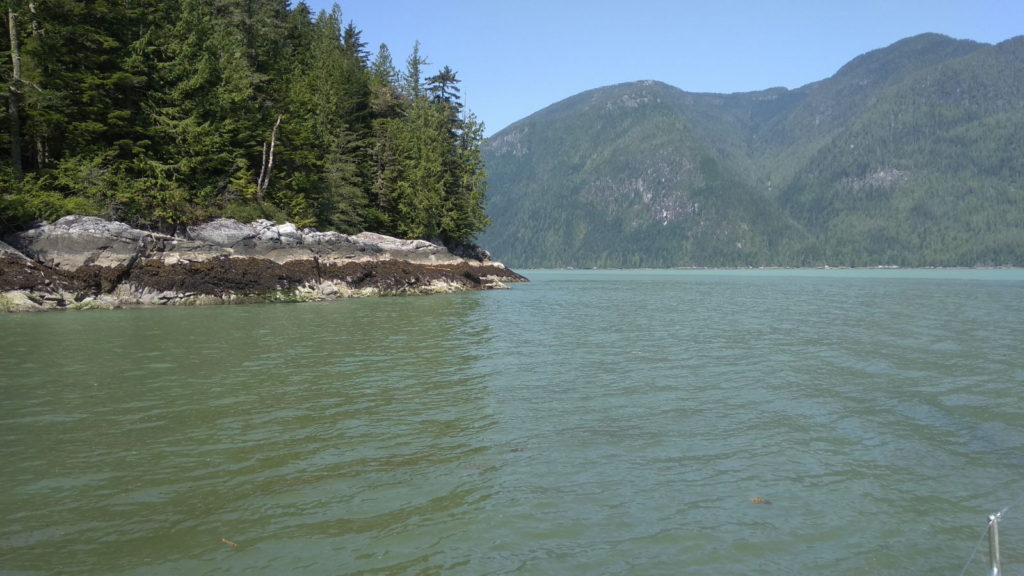
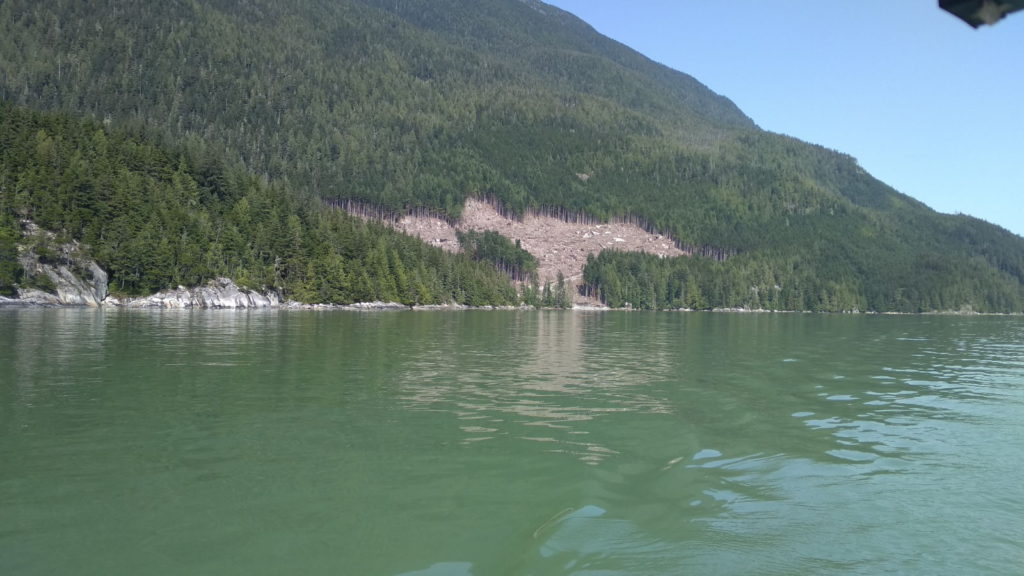
There was only one other boat nearby, but best of all there was a black bear on the beach opposite. We sat in the cockpit with binoculars practically glued to our eyes – another amazing sight to marvel at. We heard splashing close by as we watched; dolphins were diving near the bow as if to catch our attention and pull our stare towards them instead of the bear. Every time we looked back at the bear, the splashing would start up again. It was such a peaceful place; we had eagles soaring above us and the calls and squawks of other birds coming from the forest while we sat taking it all in. I kept thinking that we were only feet away from a bear when every other time I’ve been that close to one has been in a wildlife park. It was a humbling thought and I felt privileged to witness it.
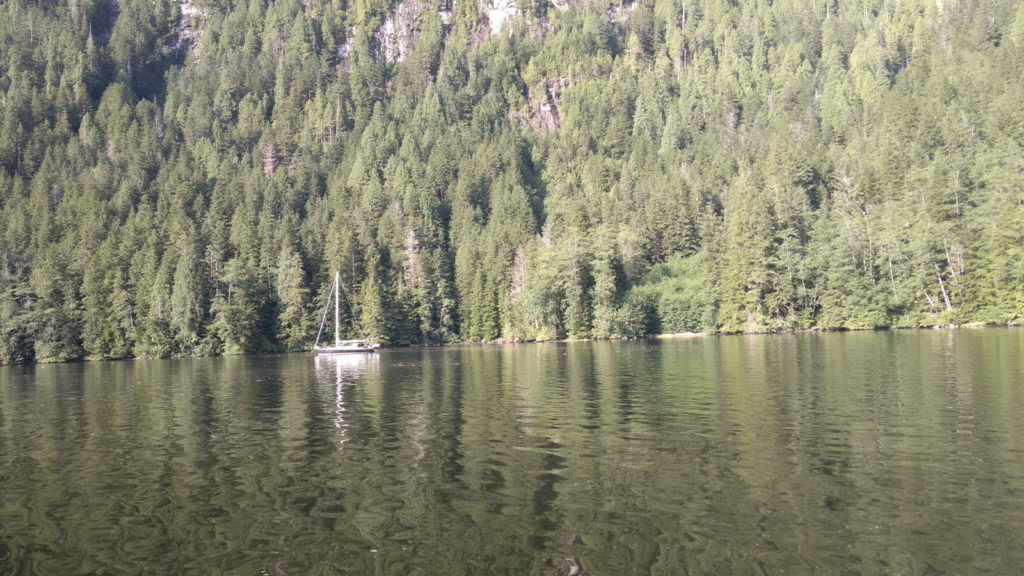
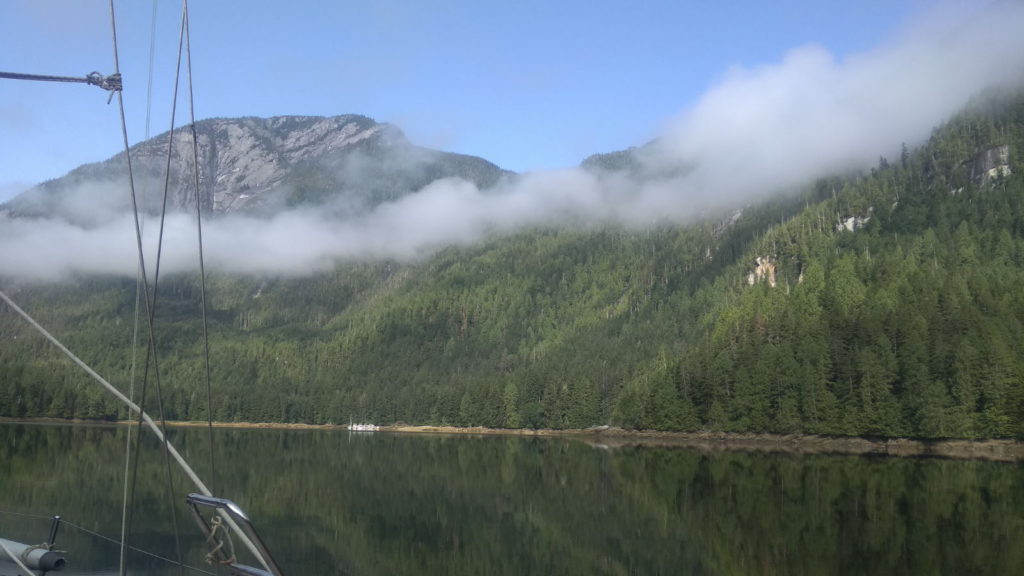
Pig roast over in Echo Bay for another week, we set off for it on Sunday 4th. It had been misty earlier in the morning creating a picturesque image as it swirled around the trees. The skies were clear by 11, leaving us with a chilly wind but calm waters for the short hop to Echo Bay. We secured a berth there and were tied up in a charming little marina by 1 30. Keen not to miss the museum we’d come to see, we checked in at the office cum shop and asked for directions to it. Billy Proctor is a well-known character around these parts. Well into his 80s, he has filled the museum with artefacts from a lifetime in the islands. The 20 minute walk took us through a steep woodland trail which brought back memories of millipede-laden paths in Asia that had rendered me rigid with fear. No millipedes here. Instead, there were huge green slugs that looked like snakes! Despite this and the heat from the afternoon sun it was a nice walk to Billy’s dwelling.
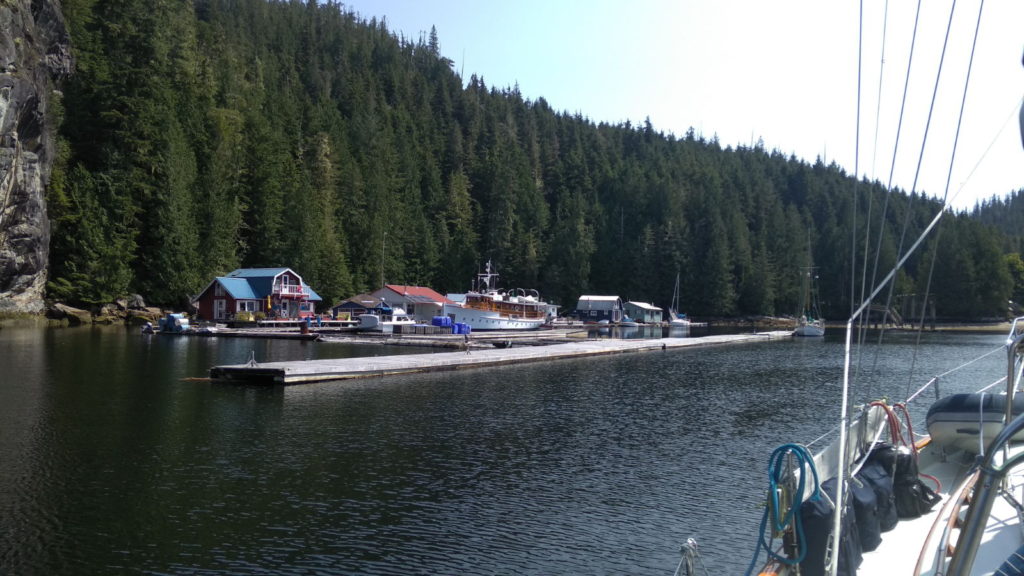
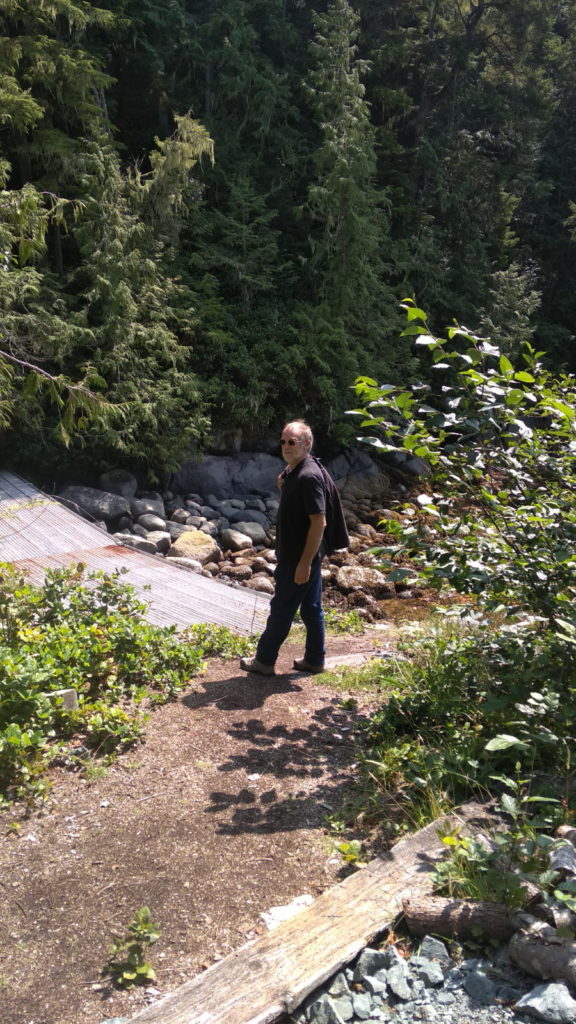
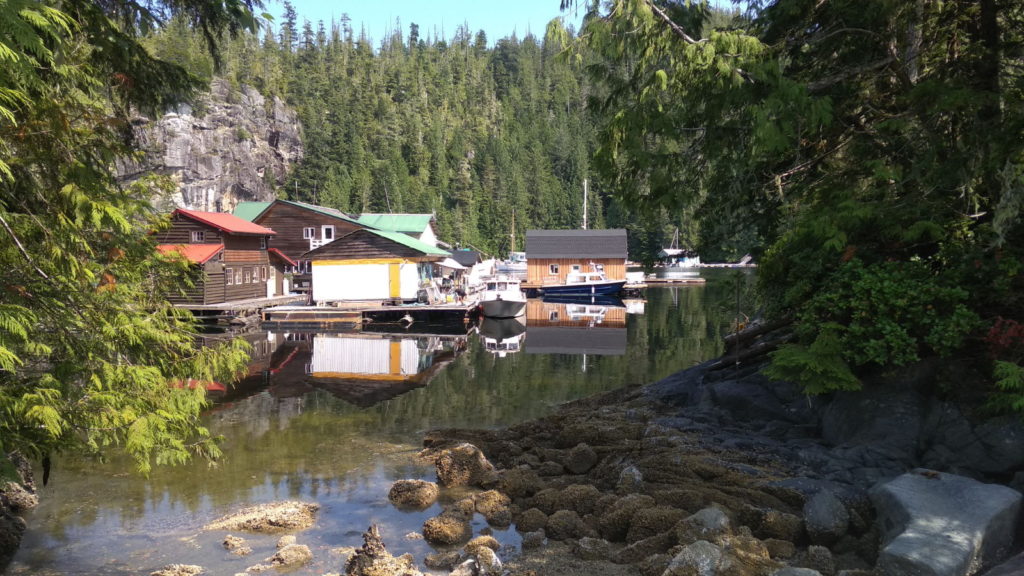
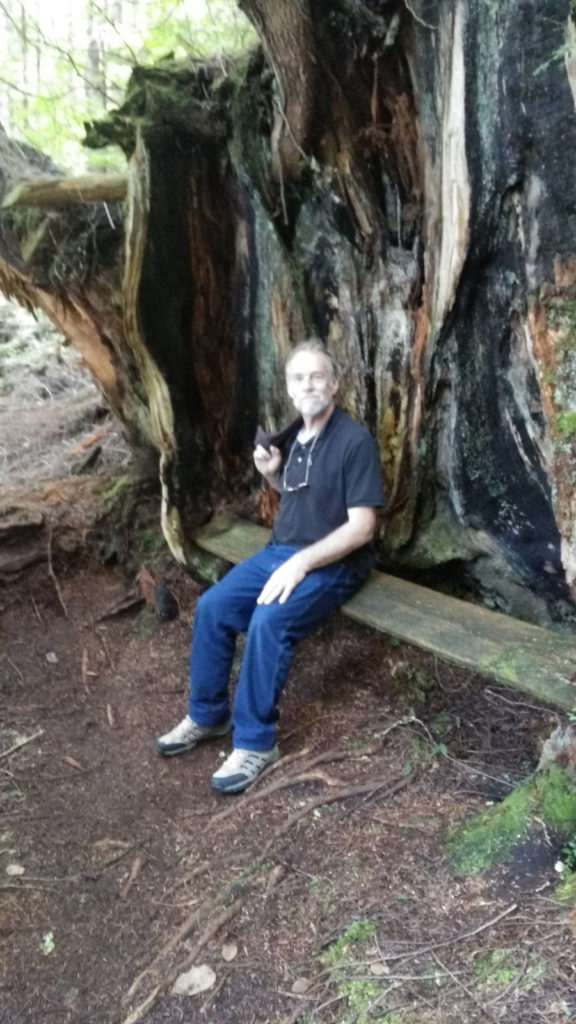
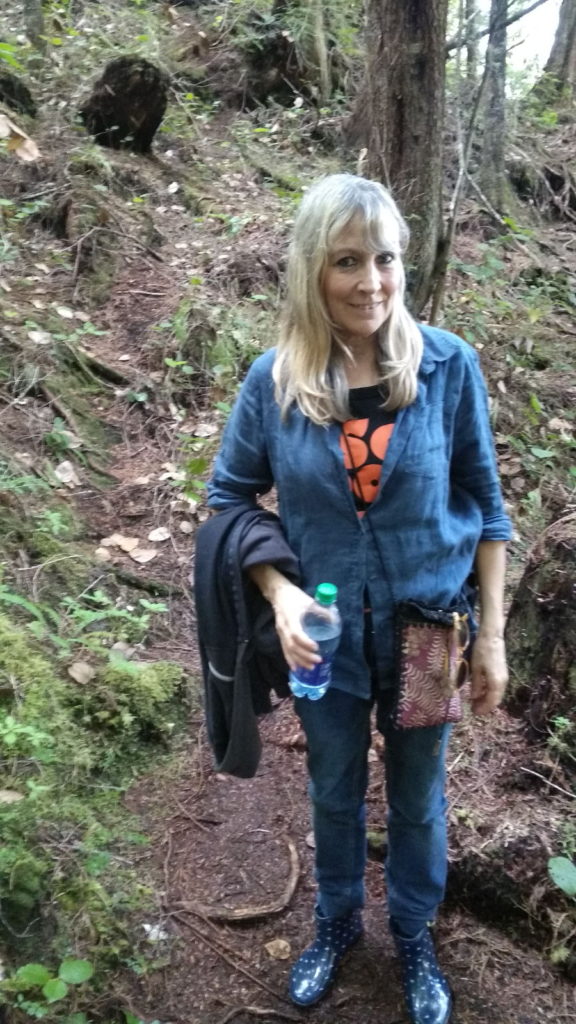
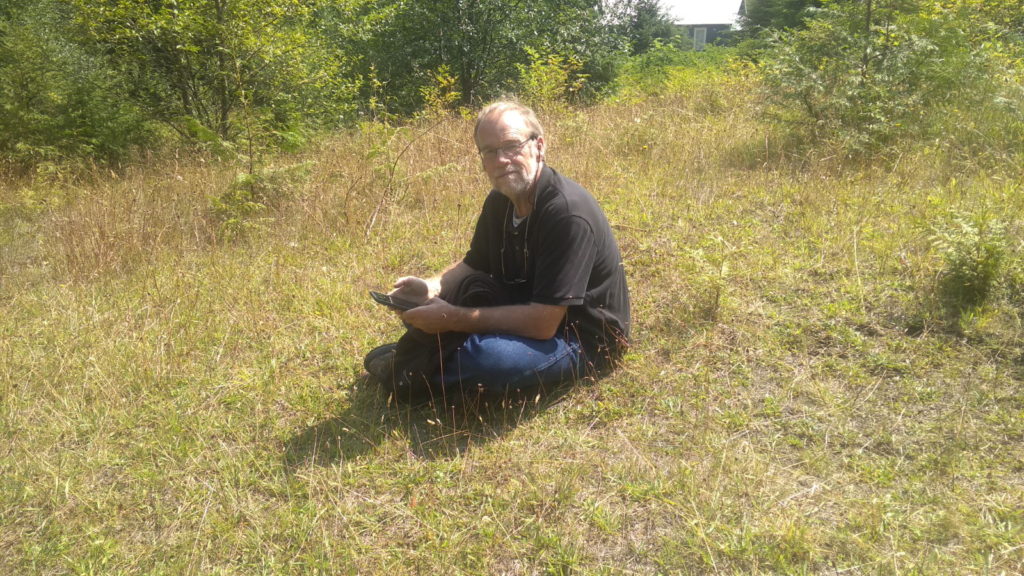
The man himself was sitting on a bench outside chatting with two other guys when we got there. The exhibits were contained in a large shed-like building which Billy had built from lumber he’d milled himself. It seemed he had kept pretty much every item he’d grown fond of over the years from his childhood onwards. I spotted several things familiar to me from the 60s and 70s, such as egg cups, picture books and old kitchen appliances. There were hundreds of coca cola and other soft drink bottles and cans, fishing equipment, old sporting programmes, cameras, toys and far too many other miscellaneous items to mention. Billy ambled in to inform us that he’d collected a lot of stuff over the years. We nodded our agreement and praised his preservation and arrangement of so many things. He told us he’d built a log cabin out of just one whole tree, and to be sure to visit the small replica school house he’d built next to the museum which he’d filled with items from the original Echo bay schoolhouse that had closed in 2008. It was a fascinating place, a real out-of-the-way sanctuary overlooking a small dock where his and other boats were tied.
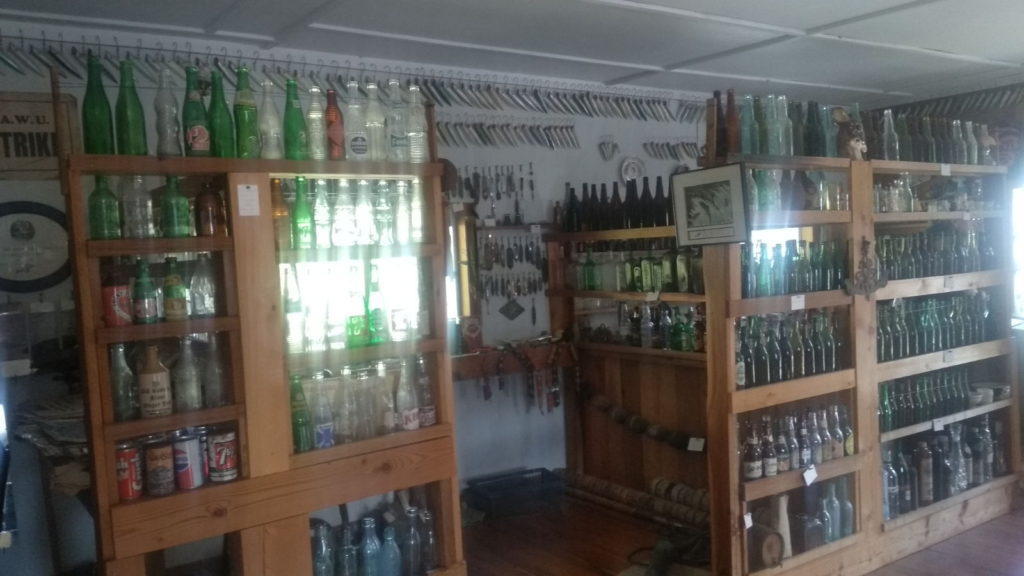
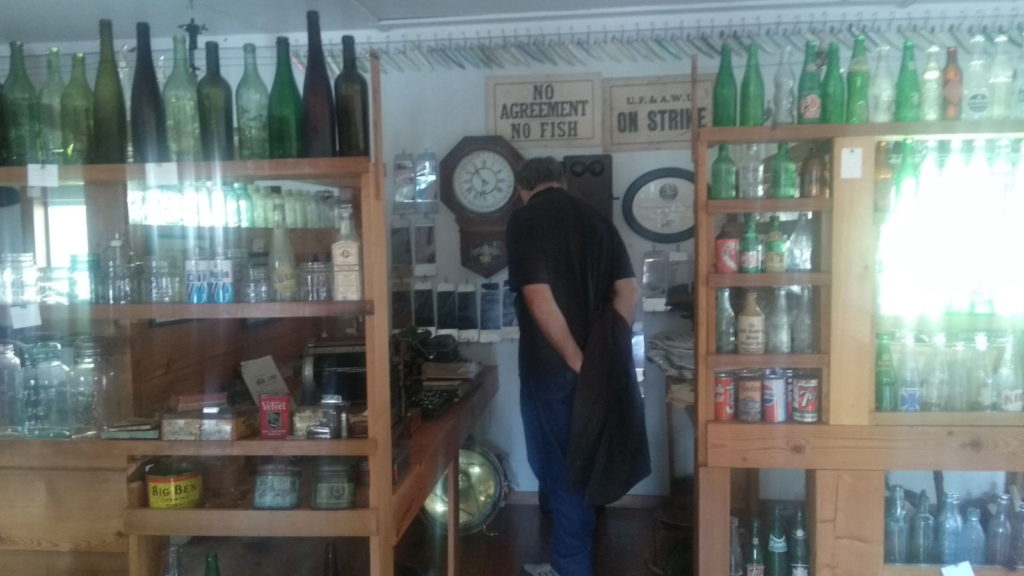
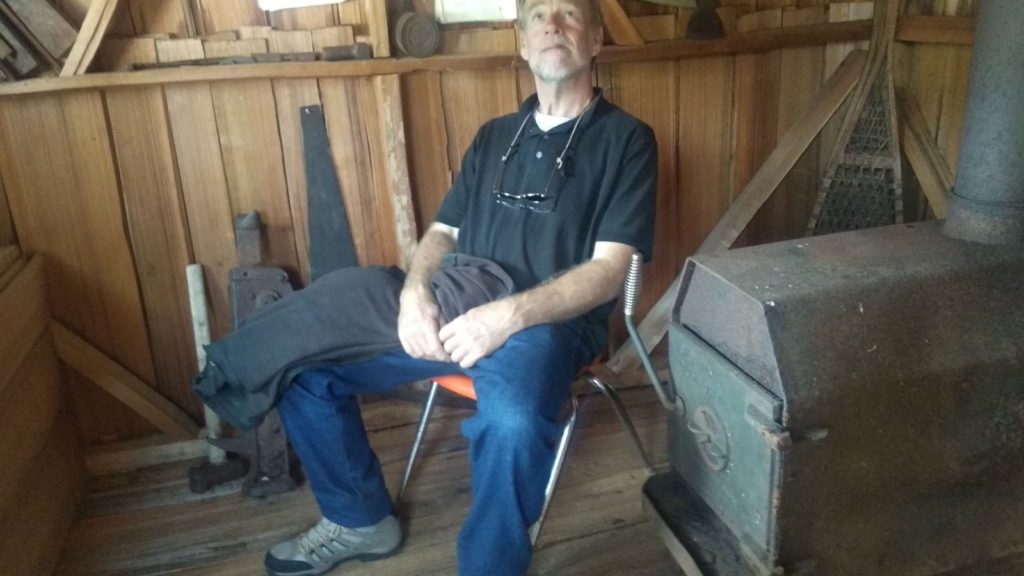
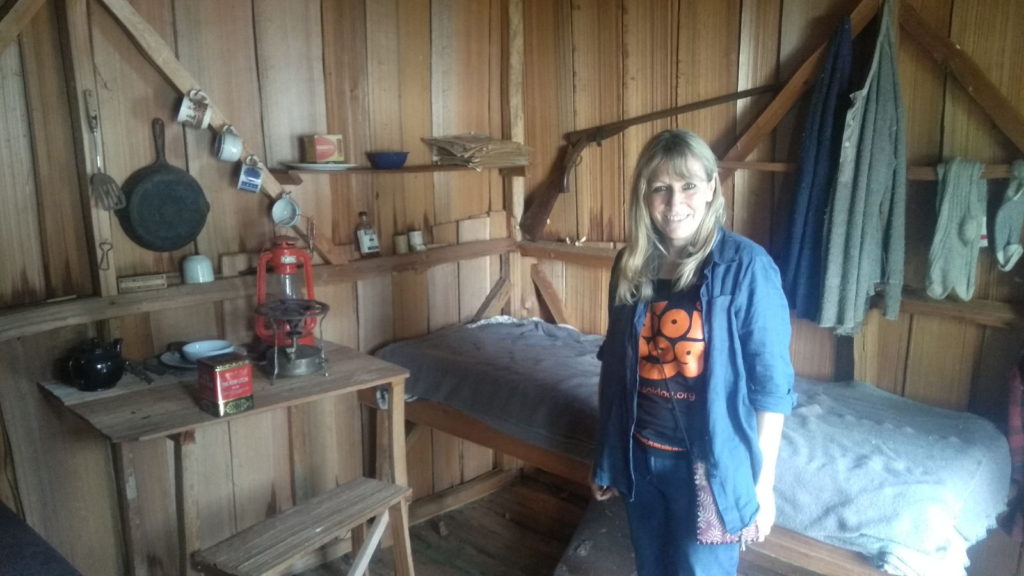
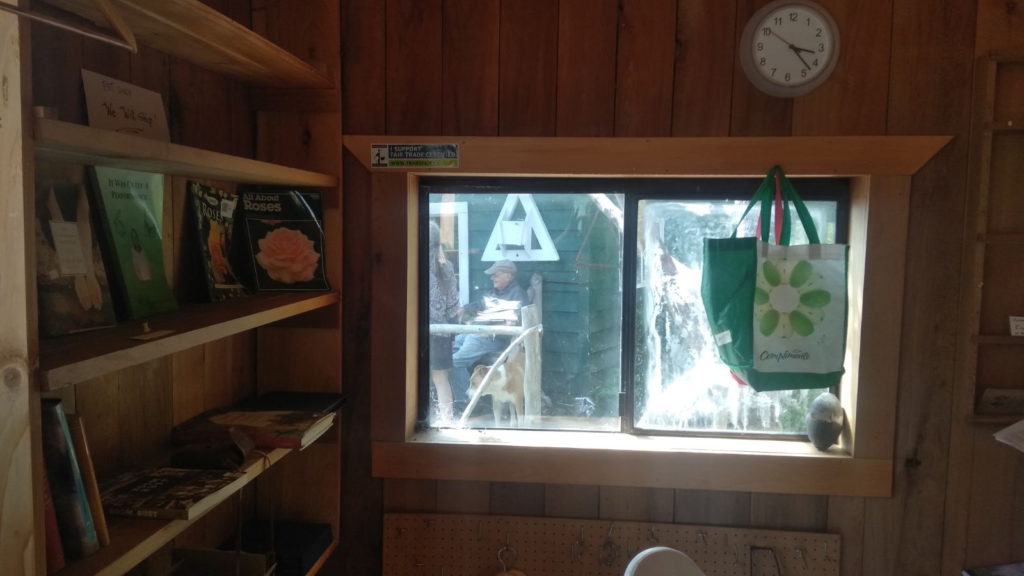
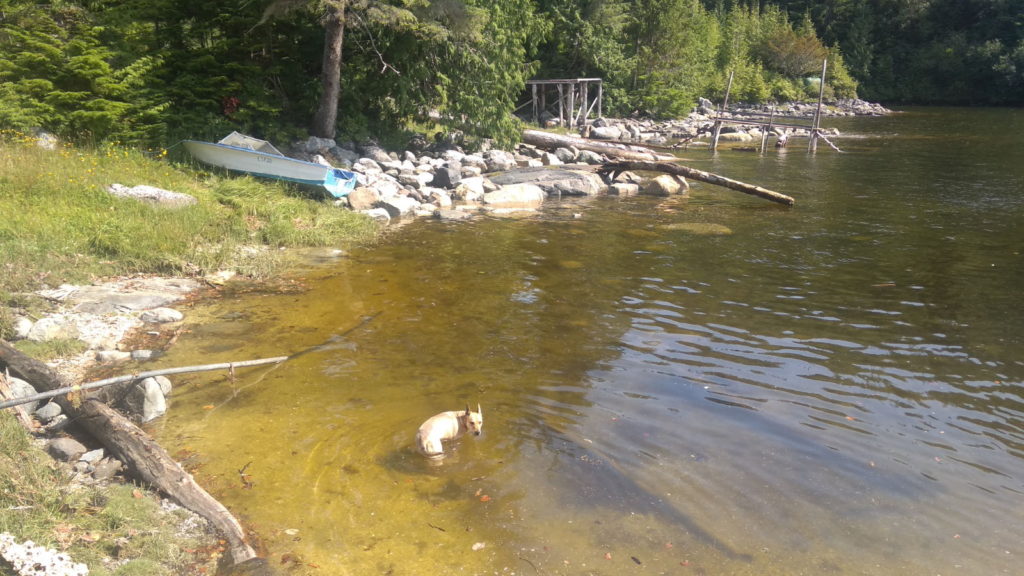
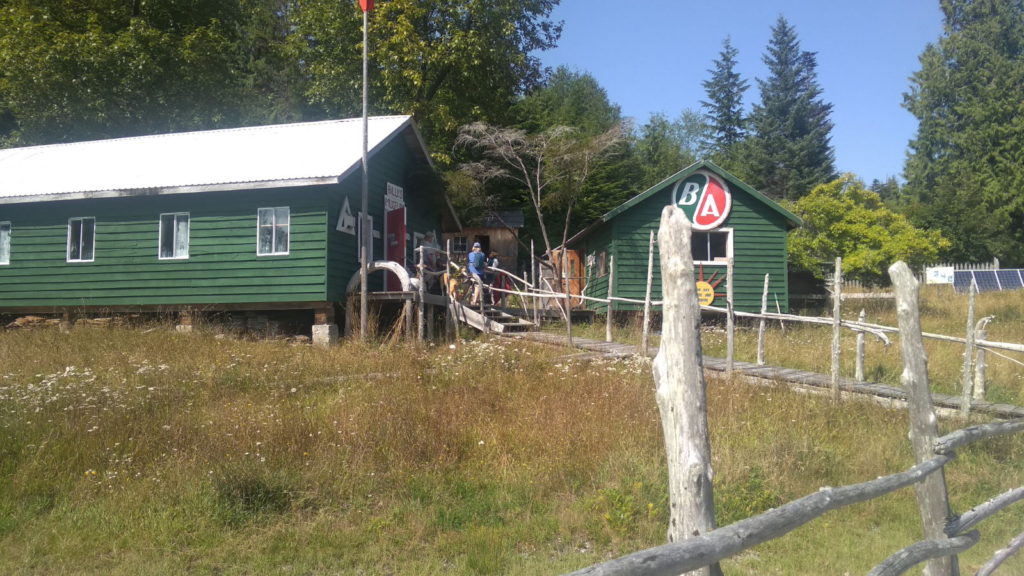
More thick fog greeted us early in the morning as we prepared to depart for the trip to Port Hardy. This would be a longer passage and we began it surrounded by swirling white mist – like being surrounded by steam in a hot bathroom, but more eerie. We had to set forth into it hoping we were not too near other vessels, rocks or logs. Once out of the marina it grew ever more disconcerting. I likened it to driving with a blindfold on and felt happier sitting at the chart table scrutinising the radar and AIS screens while Paul hand steered in the chilly cockpit.
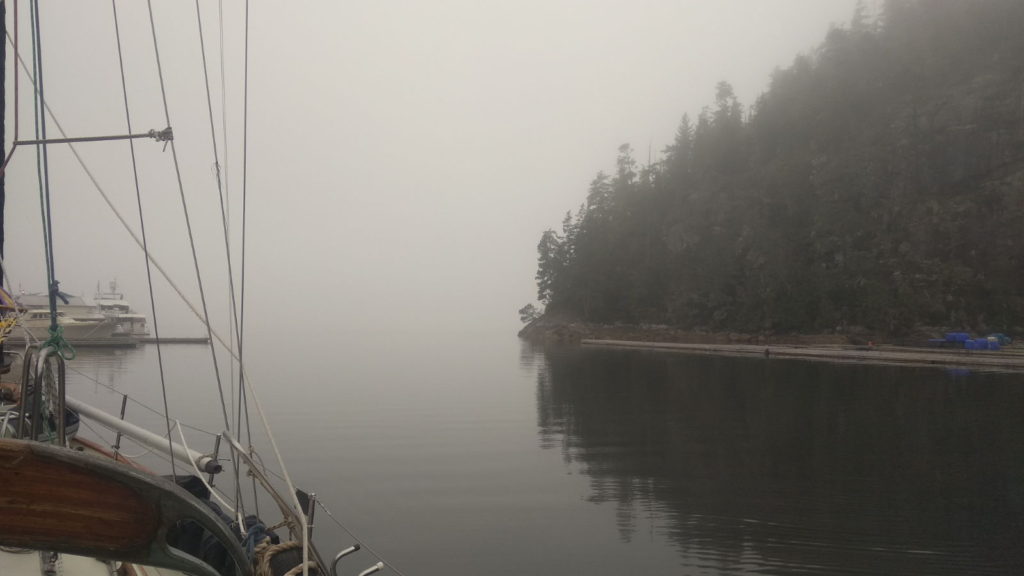
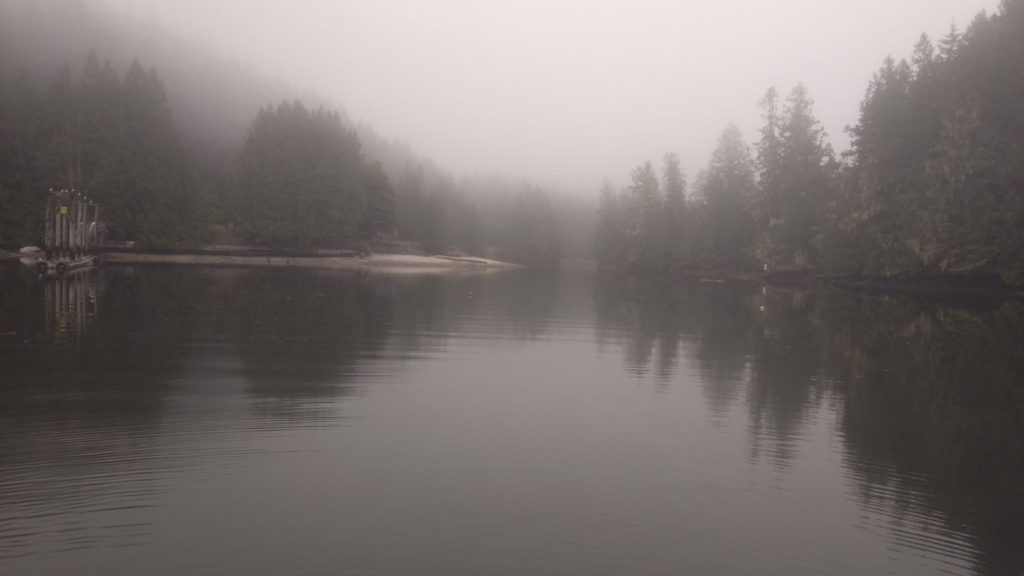
As soon as we had cleared all the land masses the autohelm took over and I prepared some vegetables for soup that evening. The fog lingered until well after lunchtime, only clearing as we tied up in Port Hardy at 2pm. This was where we had begun our Canadian travels ten months earlier after our five week crossing from Japan. It felt good to be back in the familiar and friendly Fisherman’s Wharf. We rafted up to a boat that looked as if it had been there a while – space is always tight here – and took a walk into the centre to provision for the next week or more, as shops were likely to be scarce from now on.
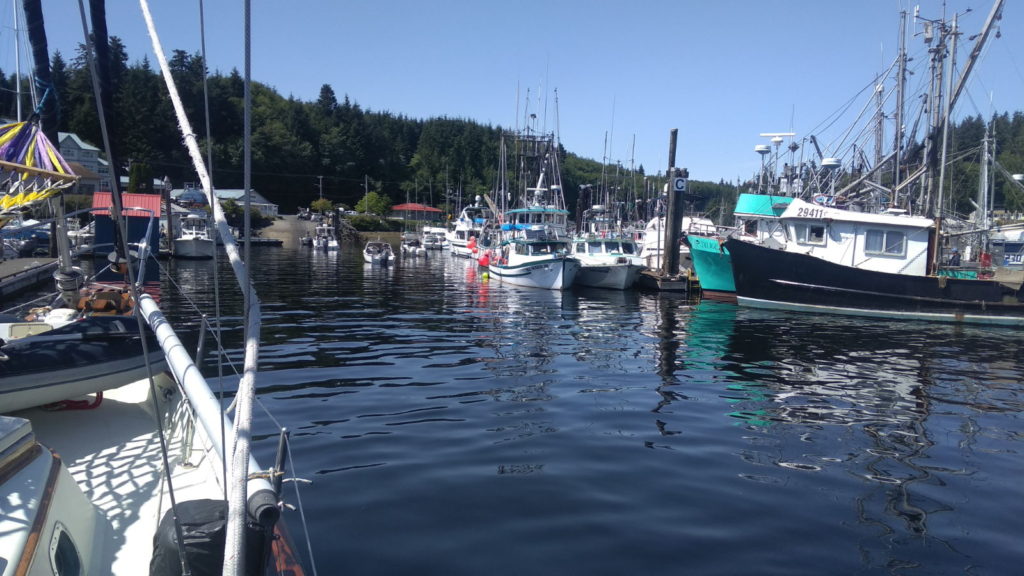
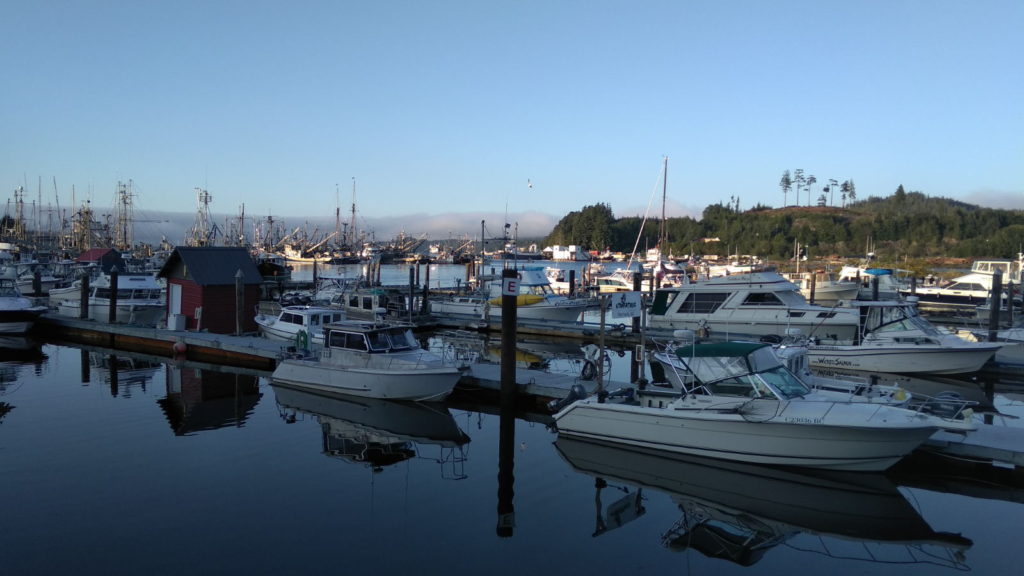
After spending a lazy day in Port Hardy catching up on various tasks and internet stuff we untied from the boat we’d rafted on to early on Wednesday 7th August. The fog had cleared by 10 o’clock and it looked like a warm day ahead. Bull Harbour was our destination and we arrived there at 12 30. Only First Nation people are permitted ashore here unless you have special permission. There were two motor boats tied on to the visitor pontoon but we chose to anchor further out in 5 metres of water. No phone coverage or internet here, and it was too chilly to be outside so we stayed in with the heating on listening to classical music while I made pastry for vegetable pasties.
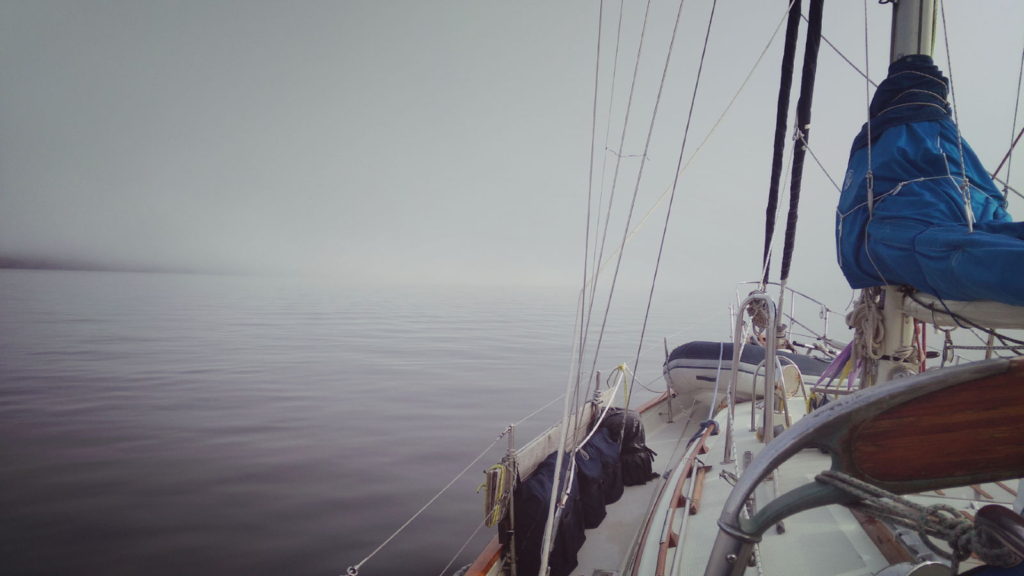
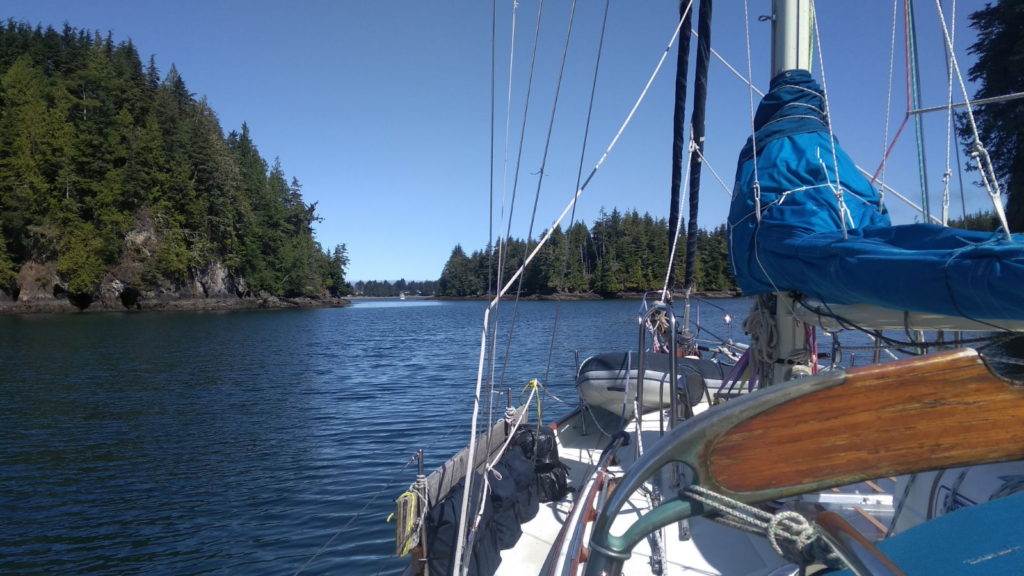
I hoped Sea Otter Cove, our next port of call would live up to its name, unlike Bull Harbour where I didn’t even spot one bull. I saw a sea otter as we drifted away next overcast morning – convinced it was the same one who’d popped its head up when we arrived. The boat seems to startle them – they stare at it momentarily before flipping over to display their seal-like body and diving under the water. This passage would take us round Cape Scott. Waggoners was full of dire warnings about it, devoting almost a full page to its hazards and historical tales of disaster. It ends with this grave statement; ‘a careful skipper, fully aware that the safety of his vessel and crew truly are at risk at Cape Scott, must judge conditions and make the right choices’. Sister Midnight’s skipper insisted it would be ‘no big deal’. He did say we would be exposed to the elements once we had cleared it as we’d be in The Pacific with no shelter from islands. I set about stowing things safely, just in case.
When we arrived in Canada just over a year ago, sea otters were the first living things we’d seen for five weeks. They were in huge groups off the coast of Port Hardy and we were only able to view them through binoculars. The ones we’d spotted so far on this trip were lone, or in couples, and much closer to the boat. I soon learned to discern between them and birds or debris on the water. Their distinctive black flippers poking up are often the first thing I see, and a huge fluffy head bobbing opposite their feet as they lie in repose, looking for all the world like someone relaxing on an air bed. I don’t think I will ever tire of looking at them. Once we were safely anchored in the cove I sat with the binoculars staring out to my heart’s content. I told Paul I’d been watching a sea otter and a seal playing together. He said they were more likely to have been fighting over a fish – such is the difference in our perception of things ;-). Later that evening, Rob and Vanessa came over in their dinghy from ‘For Good’ for a drink and a chat. They are on a worthwhile mission to spread awareness about environmental and conservation issues while sailing and living aboard their boat.
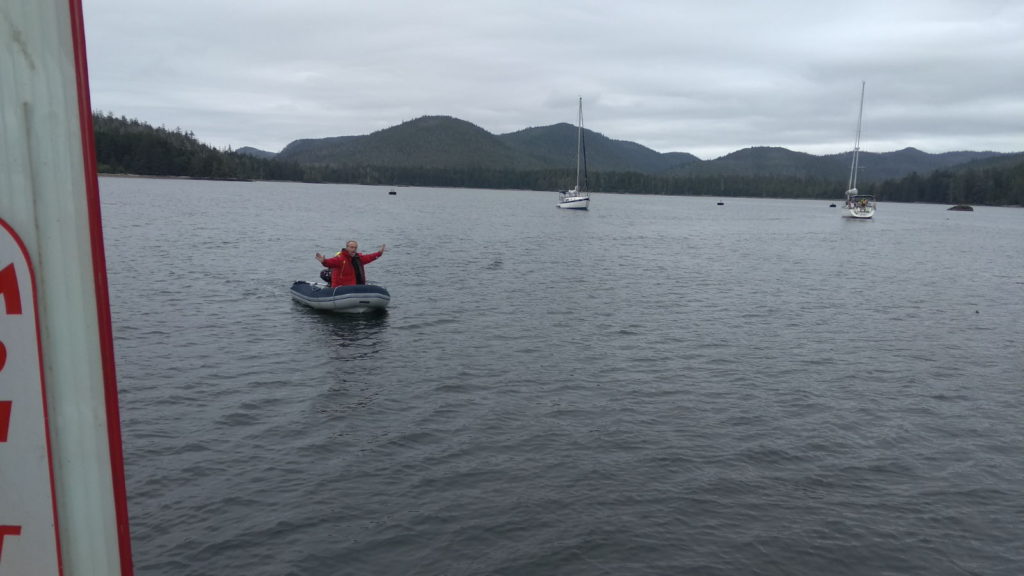
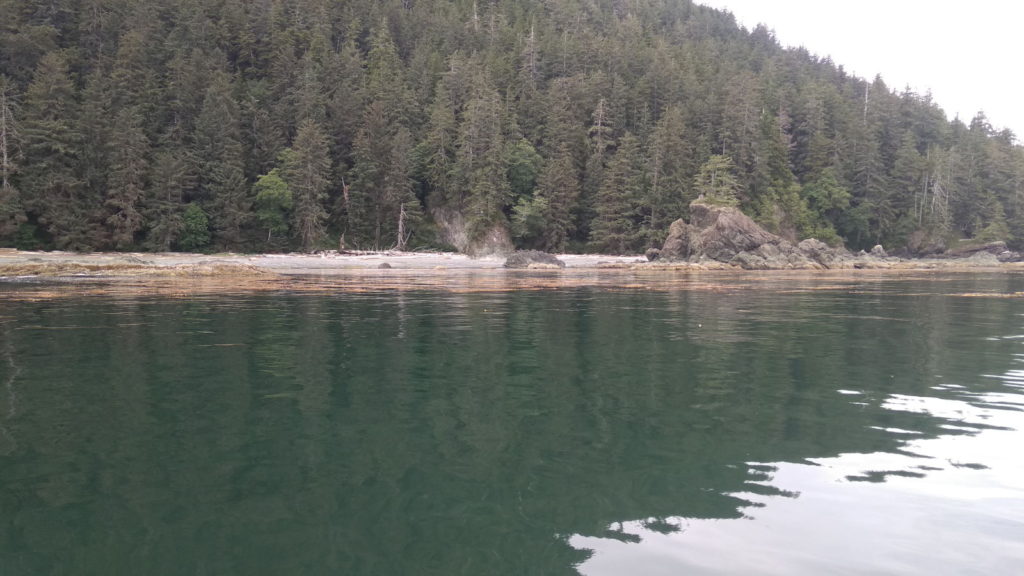
Winter Harbour, where we tied on to the public dock on Friday 9th August is a small, friendly place which was formerly a commercial fishing outpost. When that closed, the docks and fuel facility were taken over by the main general store, ‘The Outpost’ and that’s where we headed to replenish our supplies of soda water and bread.
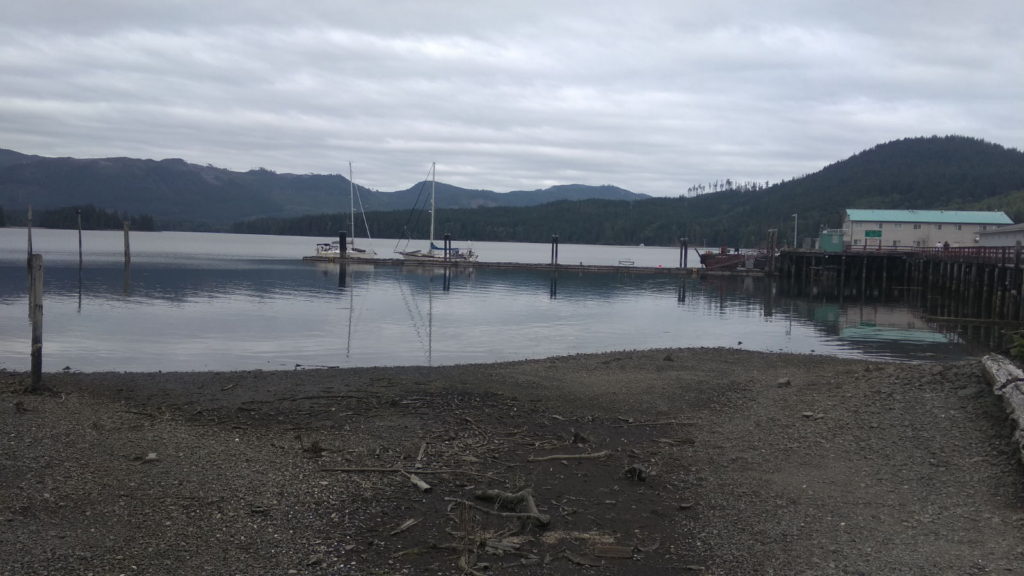

We also bought some internet, choosing the ‘48 hour for two devices’ option. Unfortunately, my phone greedily sucked up a good deal of the allowance by updating apps as soon as it connected until Paul found out how to turn it off. We sat outside the shop on the steps catching up on internet things enjoying the sun and making a fuss of the friendly black Labrador, Keeper (pictured below with Paul).
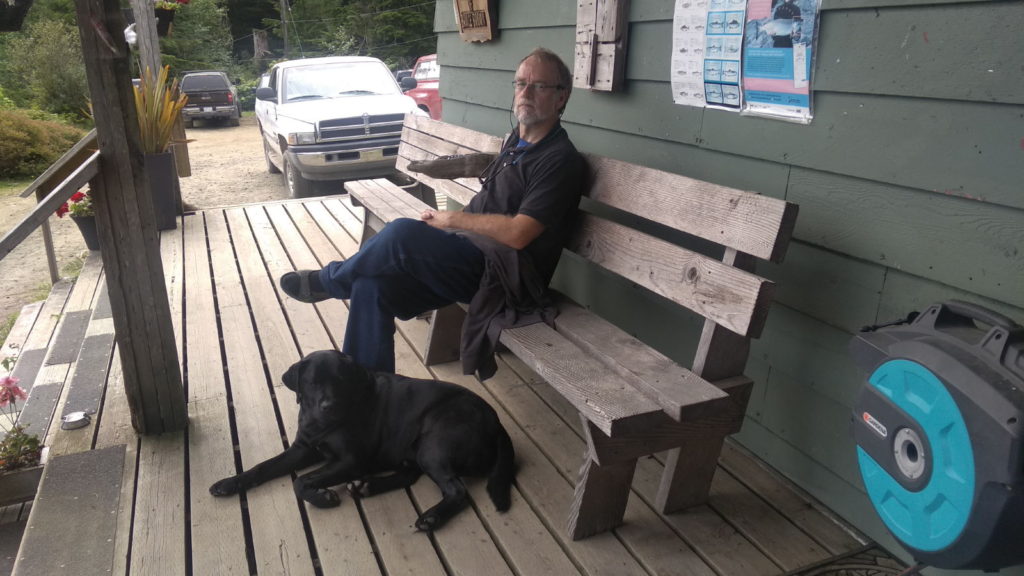
Back on the boat, we discovered that some huge mosquitoes had taken up residence in the cabin, so though I hate to kill anything, they had to be disposed of if we wanted to avoid irritating itchy bites. Out on the pontoon, Paul got chatting with two police officers who were interested in our plans and about where we had been. Learning that we would probably go to Hot Springs Cove later in the month, one of them recommended a restaurant run by his sister. Even more productive was his chat with two fishermen who had just returned from a successful afternoon’s fishing. Not only did they present him with a huge salmon that would provide him with five meals, they also gave him some fishing equipment and tips on how to catch them (watch this space ;-).
We spent another full day at Winter Harbour just taking it easy, going for short walks and taking some pictures and planning future stops along the coast. There were some great-looking dwellings on the outskirts of the forest behind the harbour. They had the look of holiday caravans and chalets but could possibly have been permanent. Just imagine spending the winter away from it all in one of those…
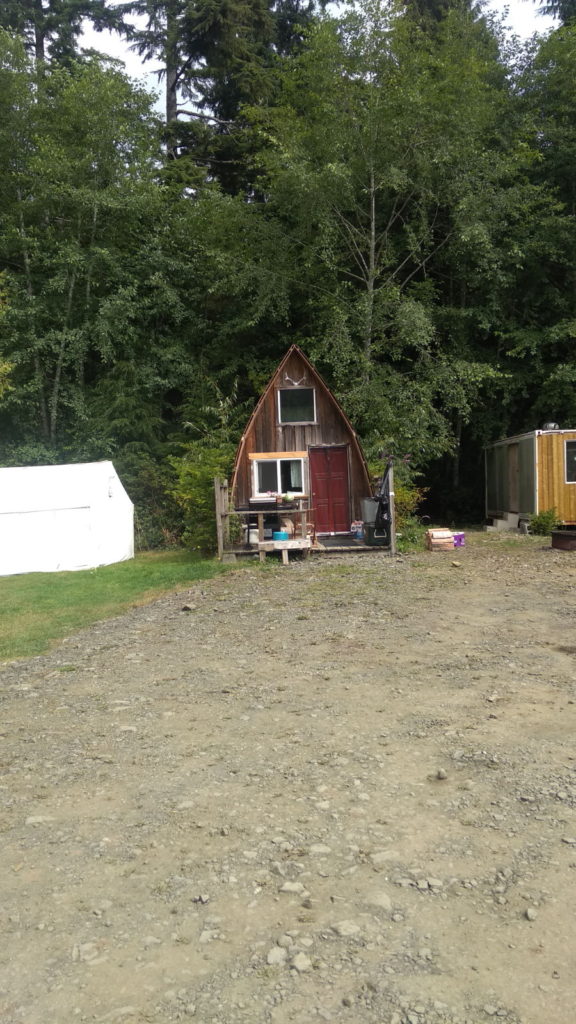
Robert and Vanessa arrived and berthed behind us. Their knowledge and tips about spotting wildlife is proving to be invaluable. Robert spotted a black bear on the shore opposite to us and after a while looking through the binoculars, Paul and I got in the dinghy and went over for a closer look. To my excitement and delight, two cubs came into view along with what was obviously the mother bear. I almost squealed but we let the dinghy drift closer so as not to disturb them. I was waiting for the best opportunity to take a picture but before that could happen, a fishing boat that must have spotted us staring at the spot, motored over downwind of the bears and the mother caught their scent immediately. She stood up straight, an amazing sight in itself, and the trio rushed back into the foliage behind them. They didn’t reappear unfortunately. Robert told us afterwards that the trick is to not make it too obvious that you are looking at a certain spot as it’s likely to attract attention from others.
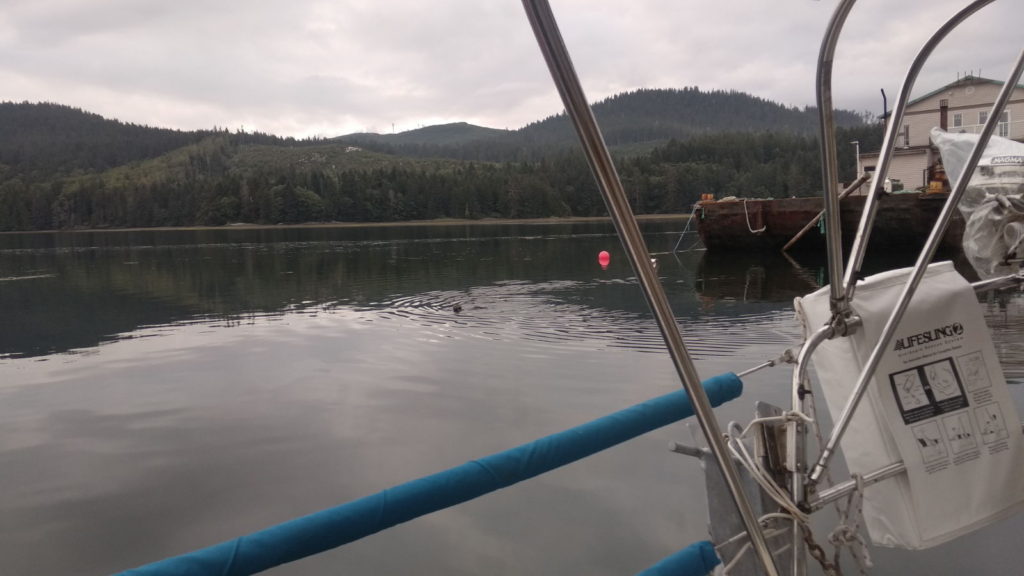
The weather finally had finally begun to feel more summer-like so early in the morning of Sunday 11th August, as I was making coffee, I heard loud splashing near the boat and ventured out into the cockpit to see what it was. A sea otter was just behind the stern crunching and munching on shellfish. It sounded like somebody noisily eating a packet of crisps. I tried to video it on my phone but it didn’t come out – hopefully there will be other chances. By 9am we had untied and were on our way to Klaskish in the sunshine and with fewer layers of clothing on. There was enough breeze to put the mainsail up so for a short while we were able to enjoy the silence without the drone of the engine. We were both thrilled further along to see a baby sea otter on the tummy of its mum.
Klaskish Basin is reached, in the words of Waggoners, ‘through a knockout, must-see narrow gorge with vertical rock sides overhung with dense forest’ and ‘you will be separated from the rest of the world’ once you are through. It felt like a pretty accurate description once we were safely anchored: very peaceful and unspoilt with wild nature all around us. ‘For Good’ was anchored not too far from us and although the weather had been a bit unsettled, we took the dinghies over to the shore in the early evening sun and anchored them together to sit and share a bottle of wine. They had spotted a bear in the area earlier in the day but unfortunately none came out to show themselves. It was great to sit chatting and drinking in such a stunning setting until rain and a chilly wind after an hour or so forced us back into our respective cosy cabins.
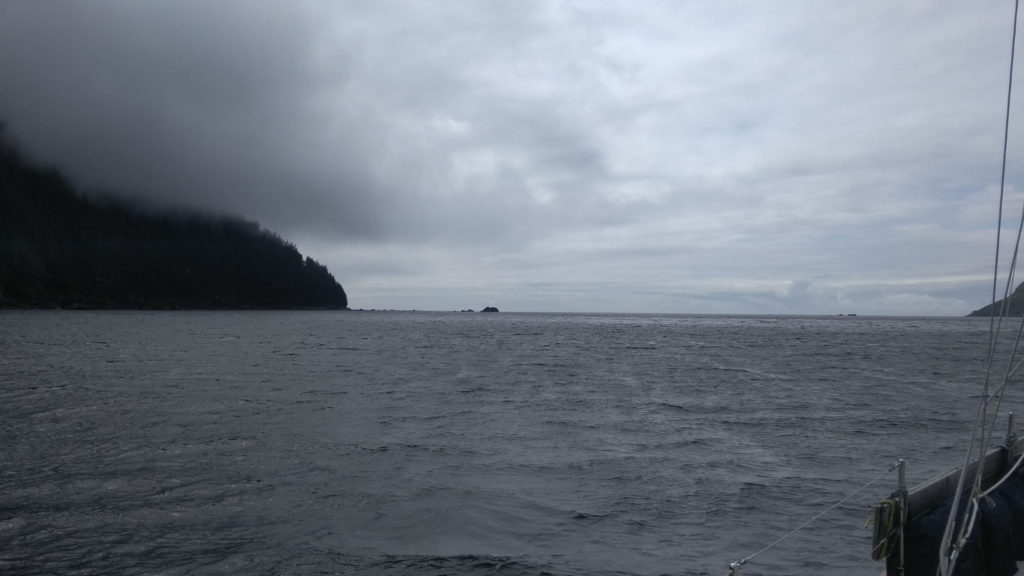
It rained throughout the night. I heard it battering the roof at various times when I woke up and that continued until 8am. It was very foggy too and we debated what to do, since we would have to navigate round the notorious Brooks Peninsula on the next leg. It was decided we would leave at 10 and stick together as boat buddies. Waggoners doesn’t mince words describing Brooks Peninsula; it is, along with Cape Scott and the waters off Cape Cook, the most hostile area on the west coast of Vancouver Island, and marks a milestone in circumnavigation. Here is their take on it:
The peninsula itself is a mountainous, rectangular promontory that extends 6 miles out from Vancouver Island, like a growth on the side of an otherwise handsome face. Rocks and reefs guard much of the shoreline. Tangles of driftwood make beaches impassable. Cliffs rise from the beaches. At the tops of the cliffs is wilderness. (Waggoners, p. 366)
More alarmingly, its cape (Cape Cook) and the Solander Island area have been known to sink boats when conflicting currents meet accelerating wind and the cape ‘should be given the greatest respect’. Paul’s response to such caution was to state that it would be no problem on a day like today. So off we went. It looked fairly innocuous as we drew nearer to it. We were keen to see the puffins and sea lions that are reported to inhabit the rocks around the area but we only saw one as we were moving away from one of the huge rocks. It was so camouflaged by the rock and so huge, that it was only as it moved its massive head that I could tell it was a sea lion. The sea was getting rougher now and with ‘For Good’ still behind we ploughed on through the choppy waters for the next headland, Clerke Point. Waggoners reported that the pyramid-shaped waves that had been battled at Solander disappeared at Clerke Point. I hoped this would be the case as it was getting decidedly bouncy down below and I did a quick check on the stowing. It didn’t exactly get calm as the afternoon wore on but thankfully it got no worse than bouncy. Paul hand steered for a bit and then put the sails up to give us more balance.
As we approached the anchorage, (having gone through the snigger-inducing ‘Gay Passage), more rocky islands and solitary rocks appeared and I watched the numbers displayed on the depth sounder carefully. Robert and Vanessa went off to anchor in a cove between two islands while we scouted around for a suitable spot some distance away in a larger bay. We should have followed them. With Paul joking about ‘any advance on 2 metres’ as my voice grew more panicked about the rapidly dropping depth, the awful noise of ‘keel scraping bottom’ reached our ears and indeed jolted us sideways. It was so loud I was convinced it had broken through and we would see water flooding the floor. I don’t think I will ever hear that sound and think all will be well. It was of course. We tried to get off the rock by using the bow thruster and even putting our joint weight on the other side of the boat by leaning over but we ended up having to wait an hour or so for the tide to float us off. Then we anchored properly and all was well 🙂
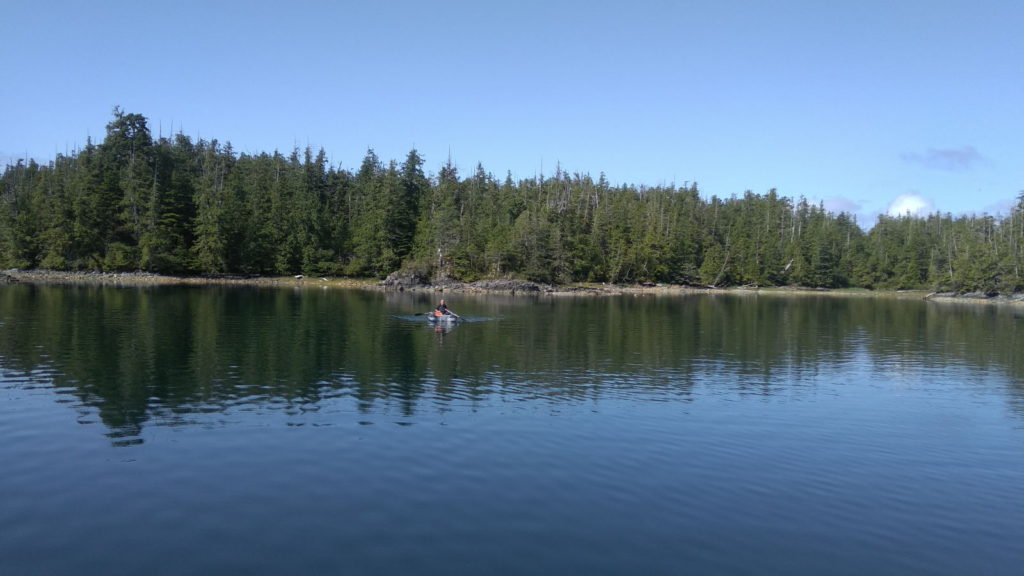
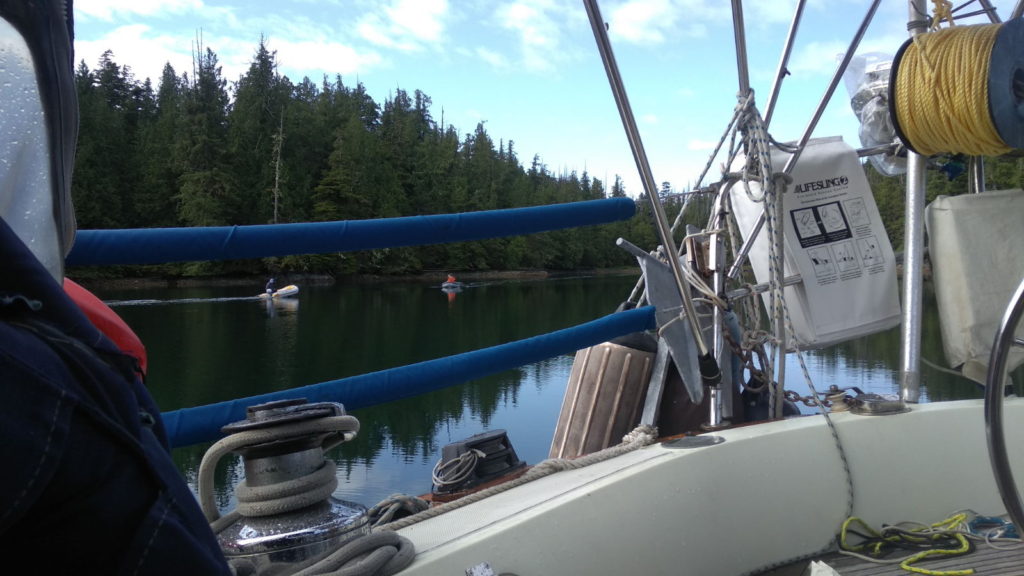
We were in The Bunsby islands, or more specifically, West Nook. It had been grey and drizzly when we arrived and the following morning dawned with a promise of much the same. We planned to stay for another day before moving on and were faced with a whole day to kill; the heavy showers threatening to curtail any exploring. Paul decided not to let the rain put him off and set out for a row in the dinghy. He was soon joined by Robert and while they were chatting the weather changed into a warm and sunny early afternoon, bringing out the true beauty of the place. The pictures below show this, taken when Paul and I went for a dinghy ride that lasted for two hours. We parked the dinghy a few times to beachcomb and to go for short exploratory walks inland. It’s my favourite part of anchoring, doing this when the weather allows.
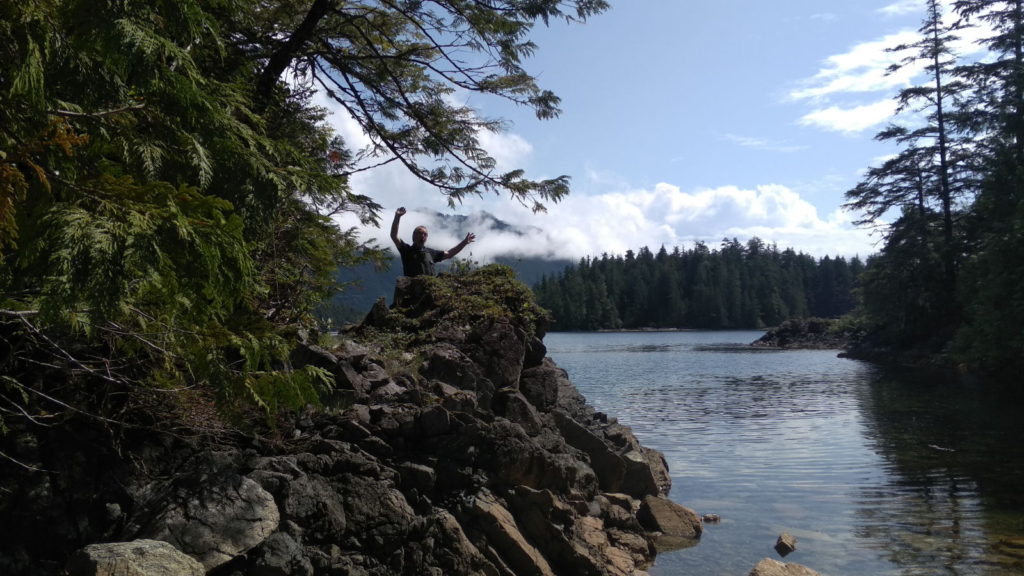
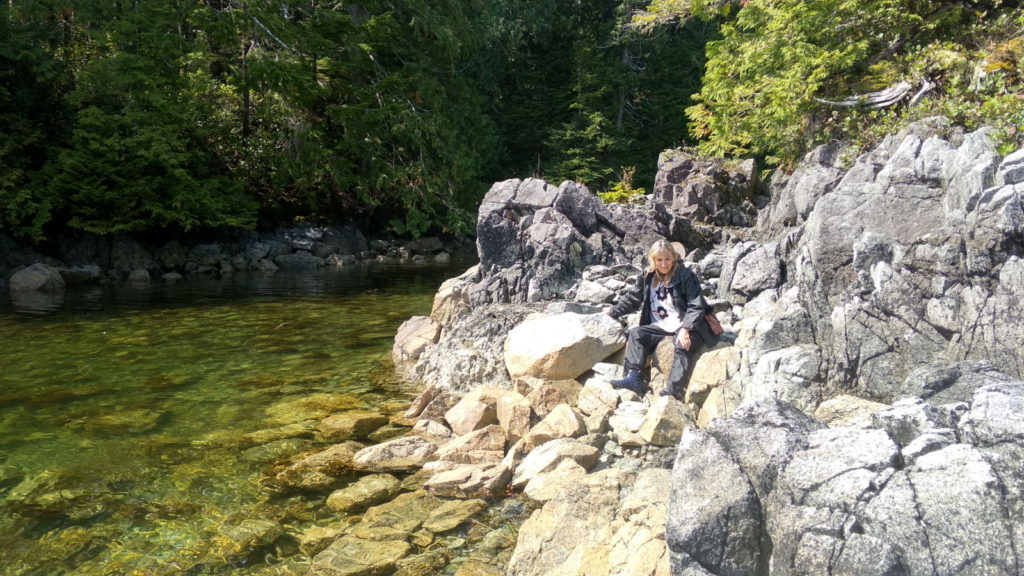
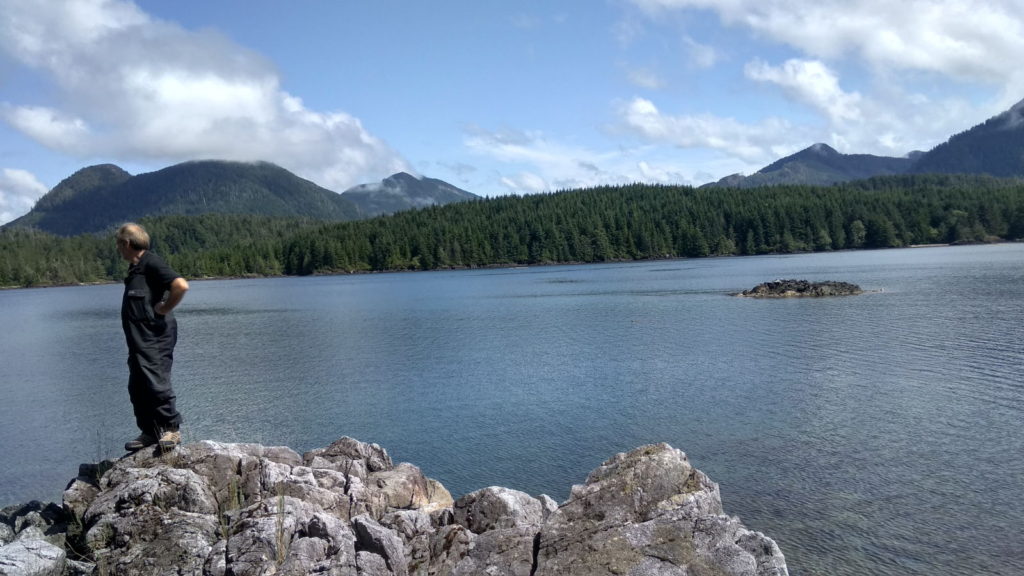
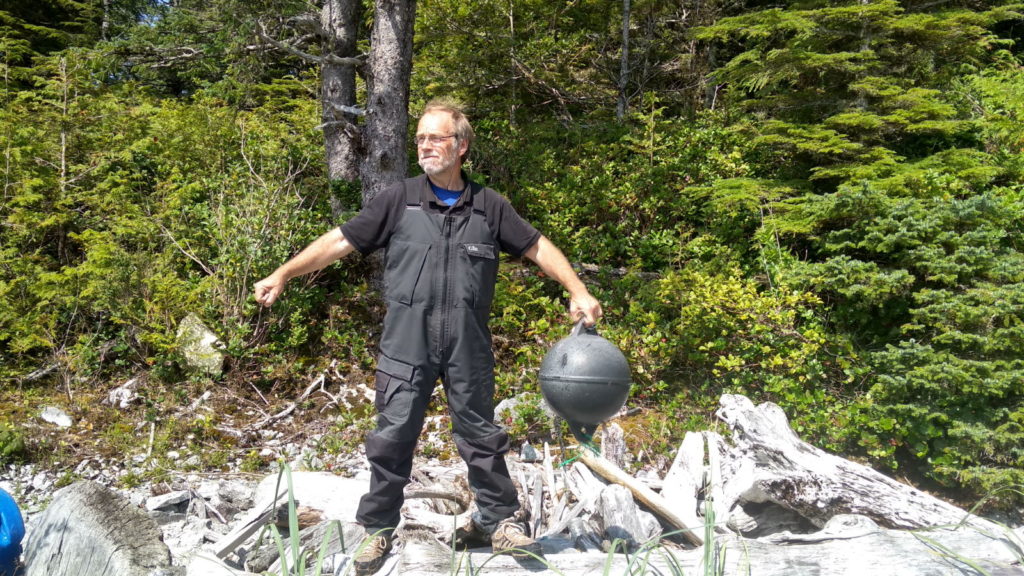
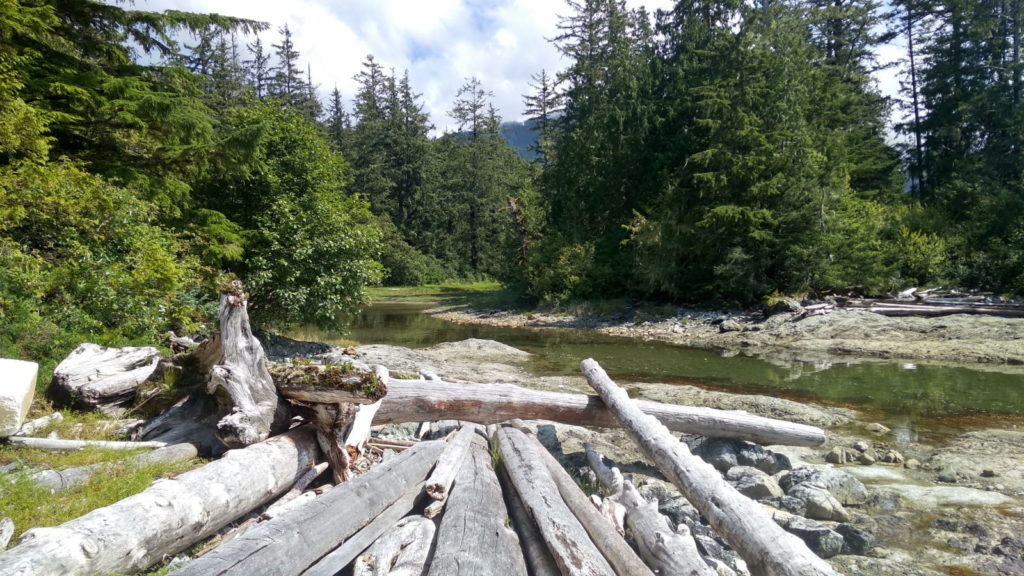
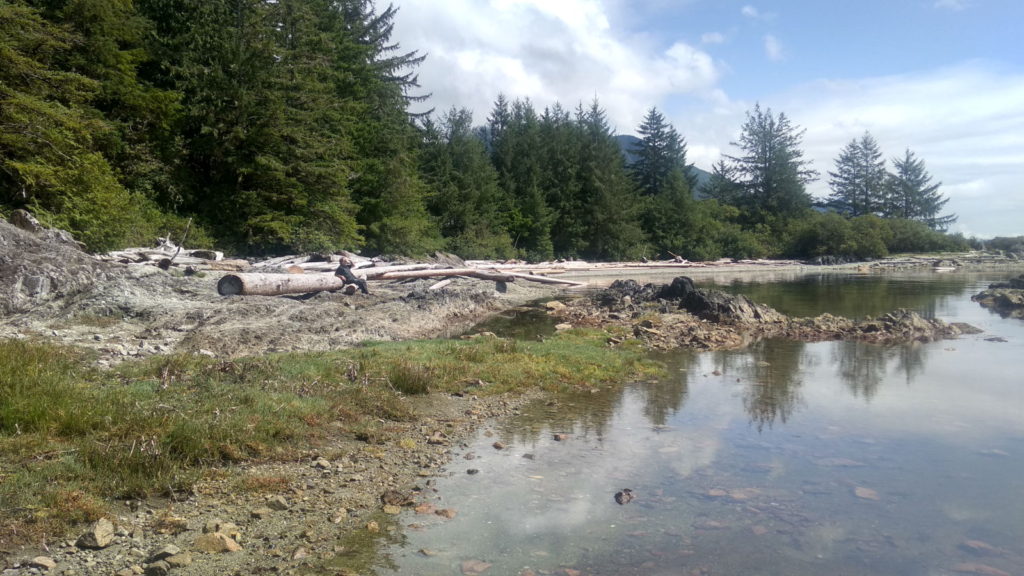
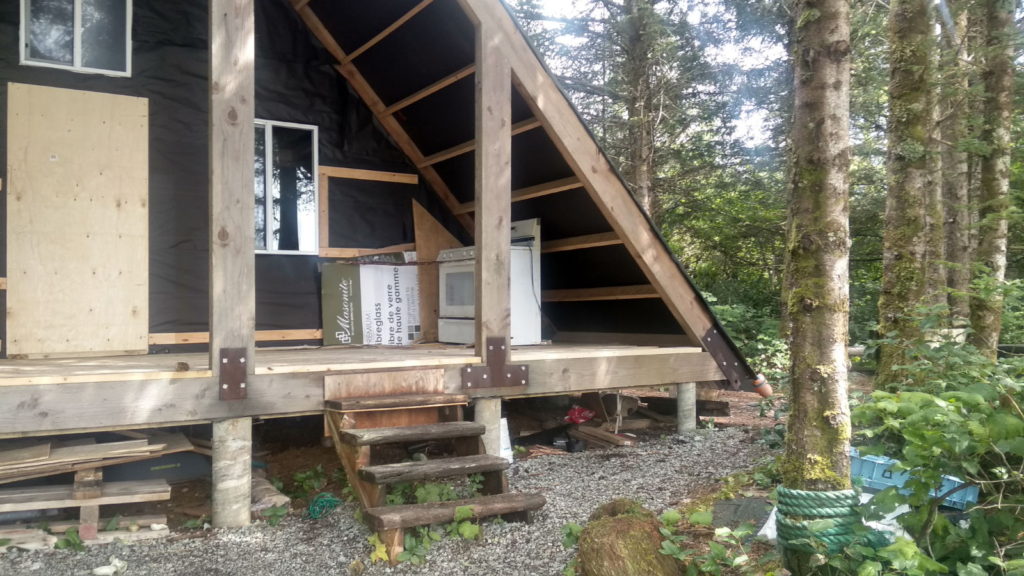
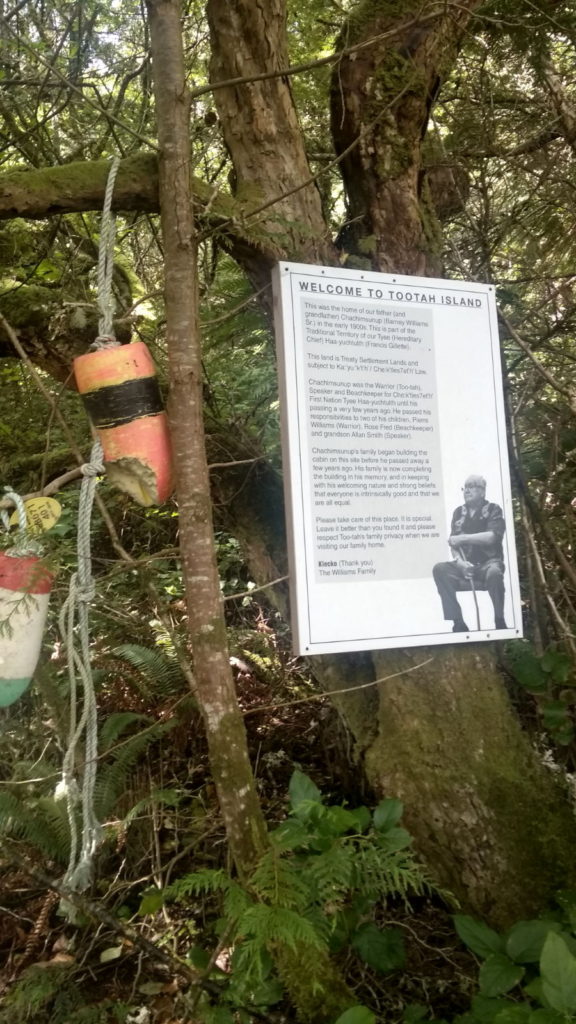
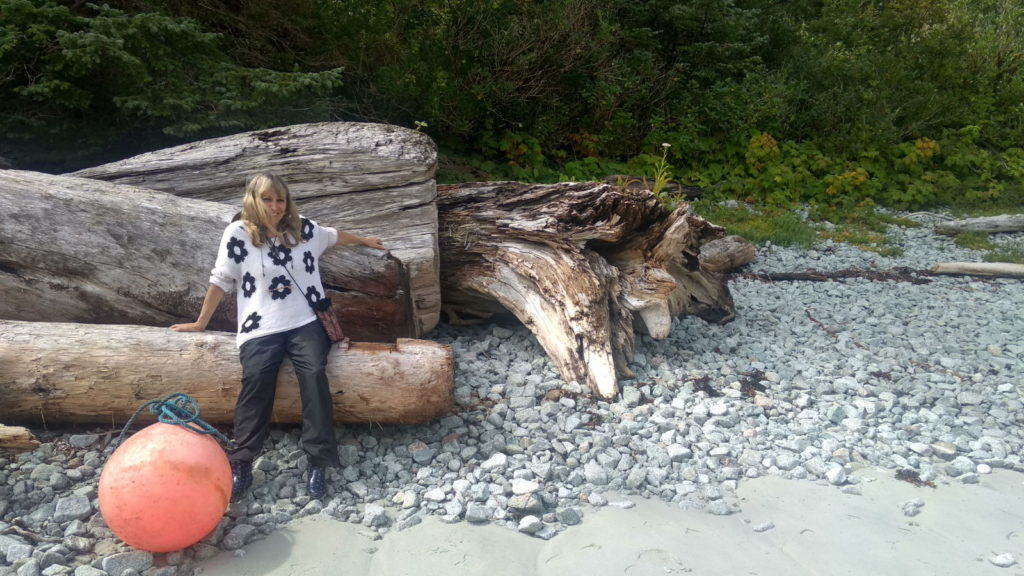
Late in the afternoon we dinghied over to see Robert and Vanessa at their anchorage and while we were chatting a sailing couple from Austria came over from their boat to chat and swap journey experiences. Turns out they are making their way to Mexico too so we will see quite a few familiar faces once we get there I hope.
Wednesday 14th August. This morning I watched the sun come up behind the mountains after a peaceful and rain-free night. We would be setting off for Walters Cove today, a place that might have some welcome wifi for us but no chance of replenishing wine supplies because it is a ‘dry’ town. The Kyuquot Native community voted for it to be so and even the hotel and resort complexes do not sell liquor. It was only a short distance away from West Nook which was just as well because the autohelm failed again. There were lots of shallow areas and rocks to watch out for so we would have probably hand steered the whole way anyway. This time, we saw several black fins gliding slowly through the water. I’m guessing they were sharks from the speed they were going but I know some fish resemble them. The weather continued to be gorgeous; warm and clear, enhancing the stunning rugged scenes around us. We followed ‘For Good’ all the way and tied up behind them on the free pontoons. We had an hour to wait until the shop opened so followed the 10 minute woodland path to ‘Java the Hut’ restaurant for a drink and some internet catch-ups on a balcony overlooking the bay.
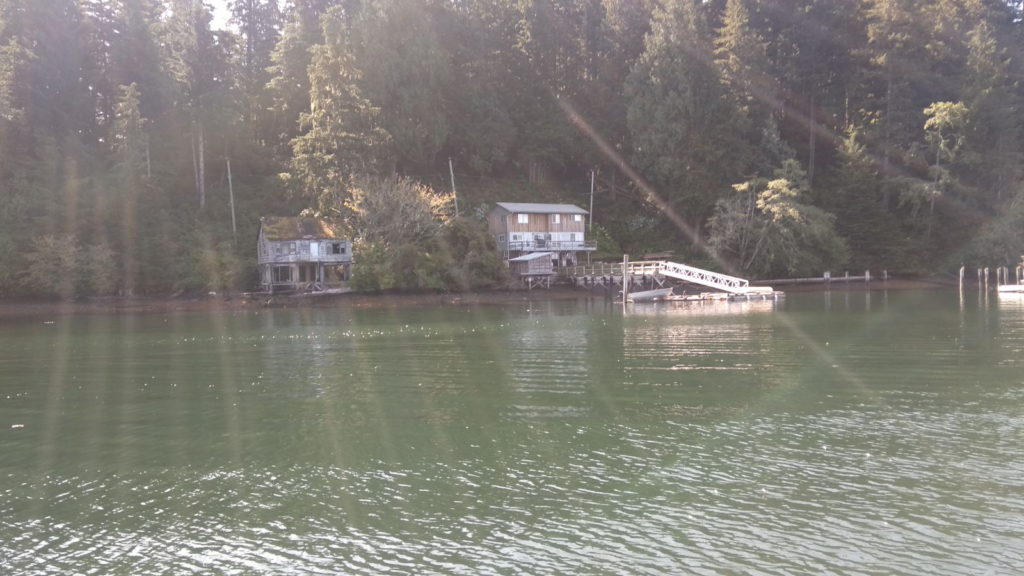
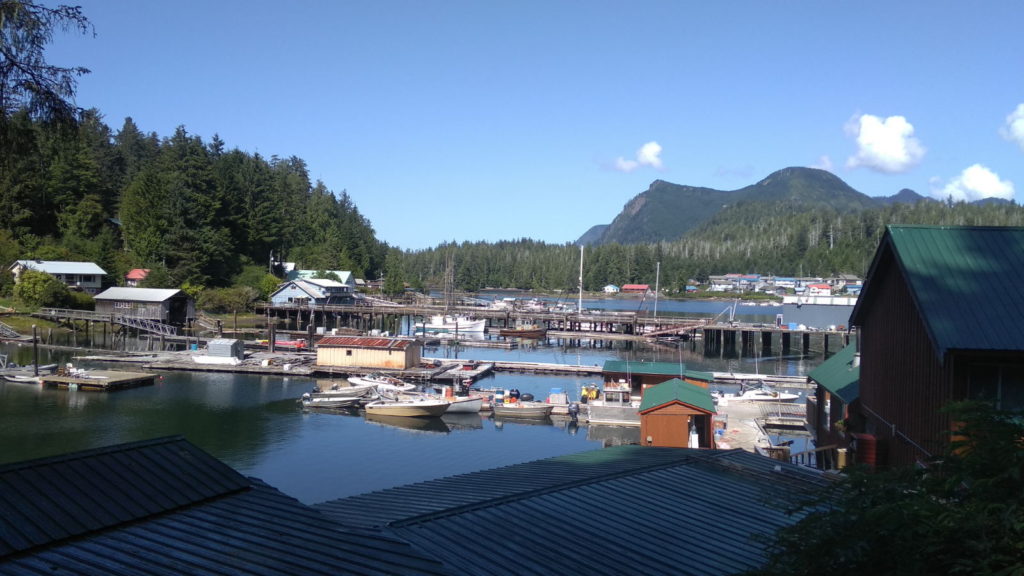
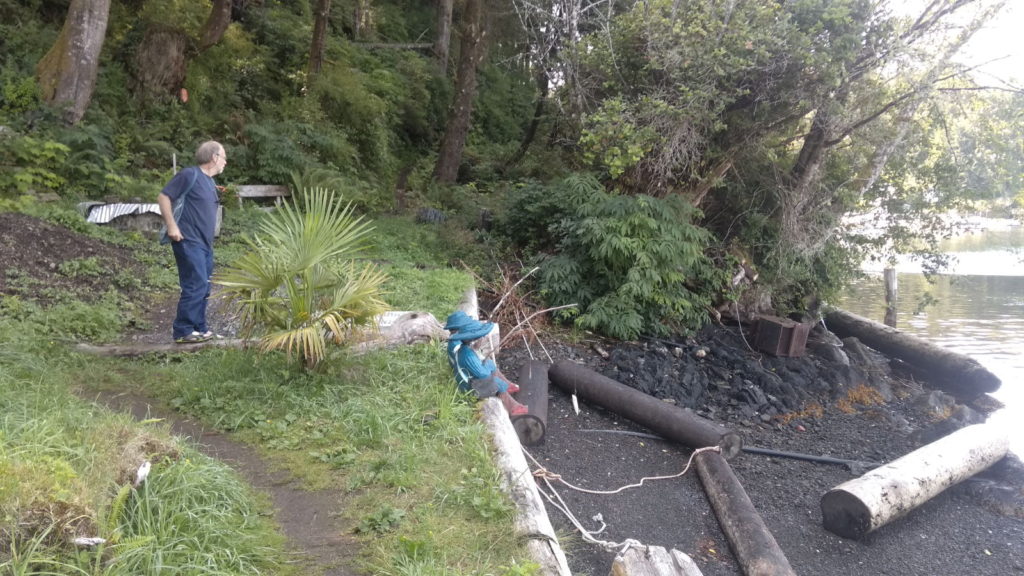
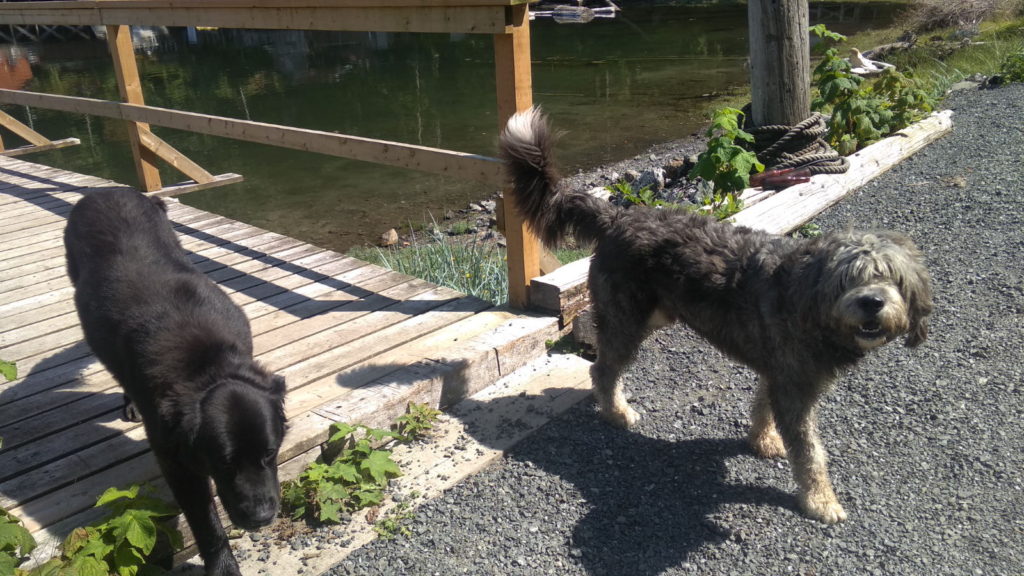
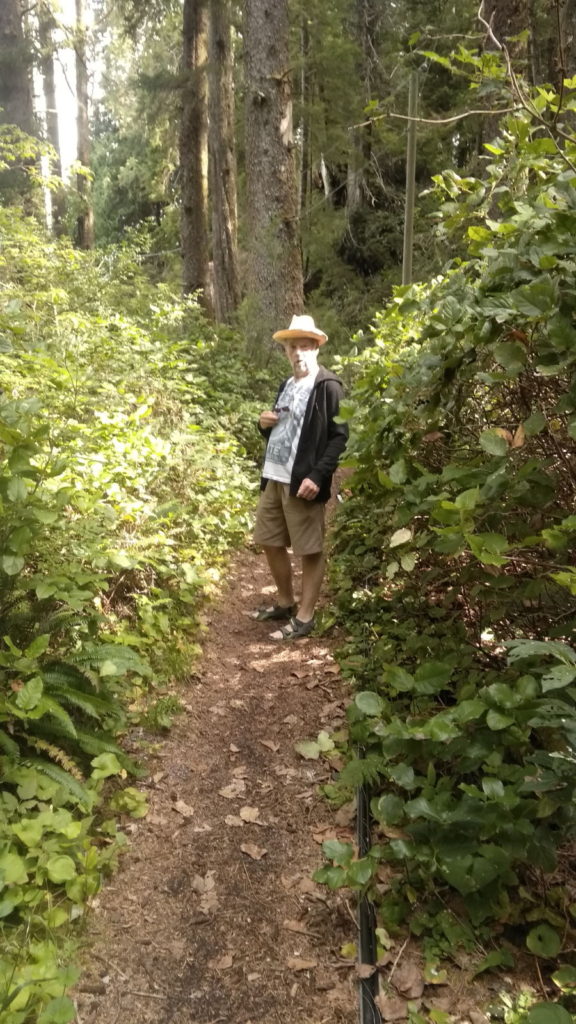
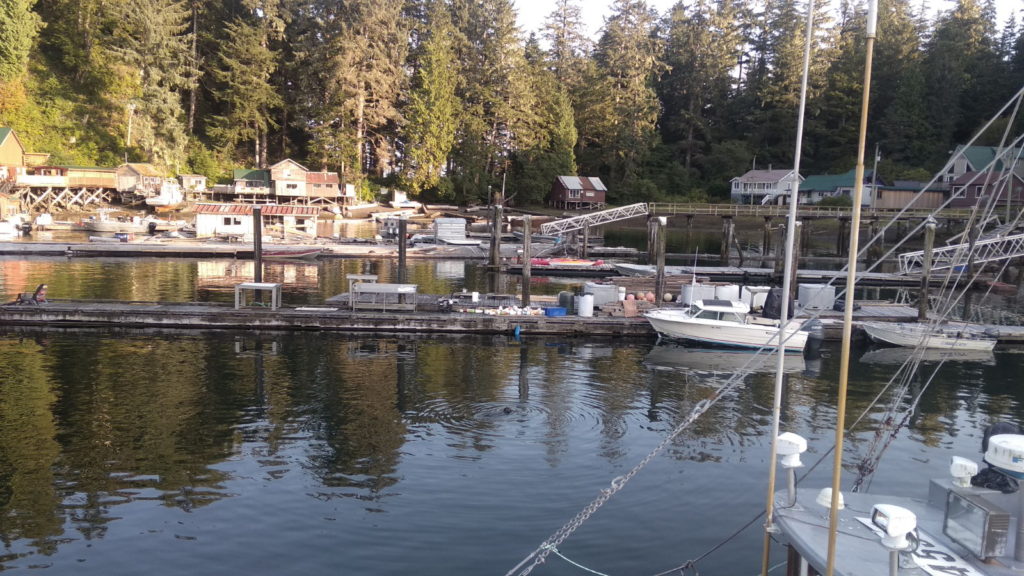
Walters Cove is a picturesque little village and the people we met were welcoming and friendly. It also has sea otters and we finally got to observe them up close. They tend to gather shellfish from the bottom of the sea around the pontoons and then surface to smash them open and eat the contents. Paul got some great video footage of them doing this, and later in the day they have grooming sessions. We watched them meticulously combing and cleaning their fur, diving down and coming up for another wash and brush up time after time – so close I could almost have touched them.
